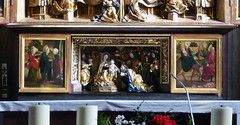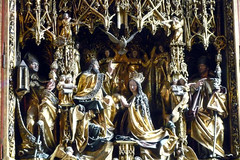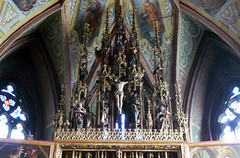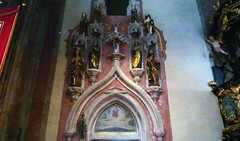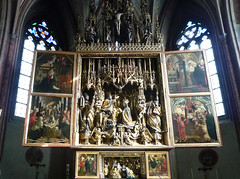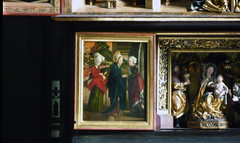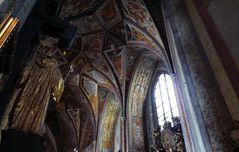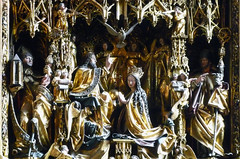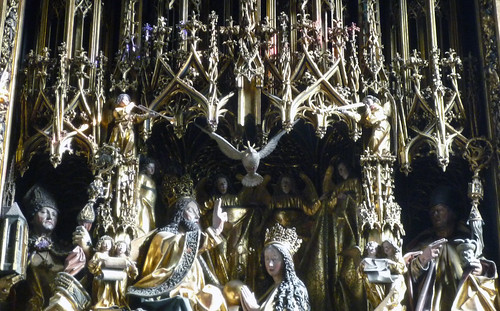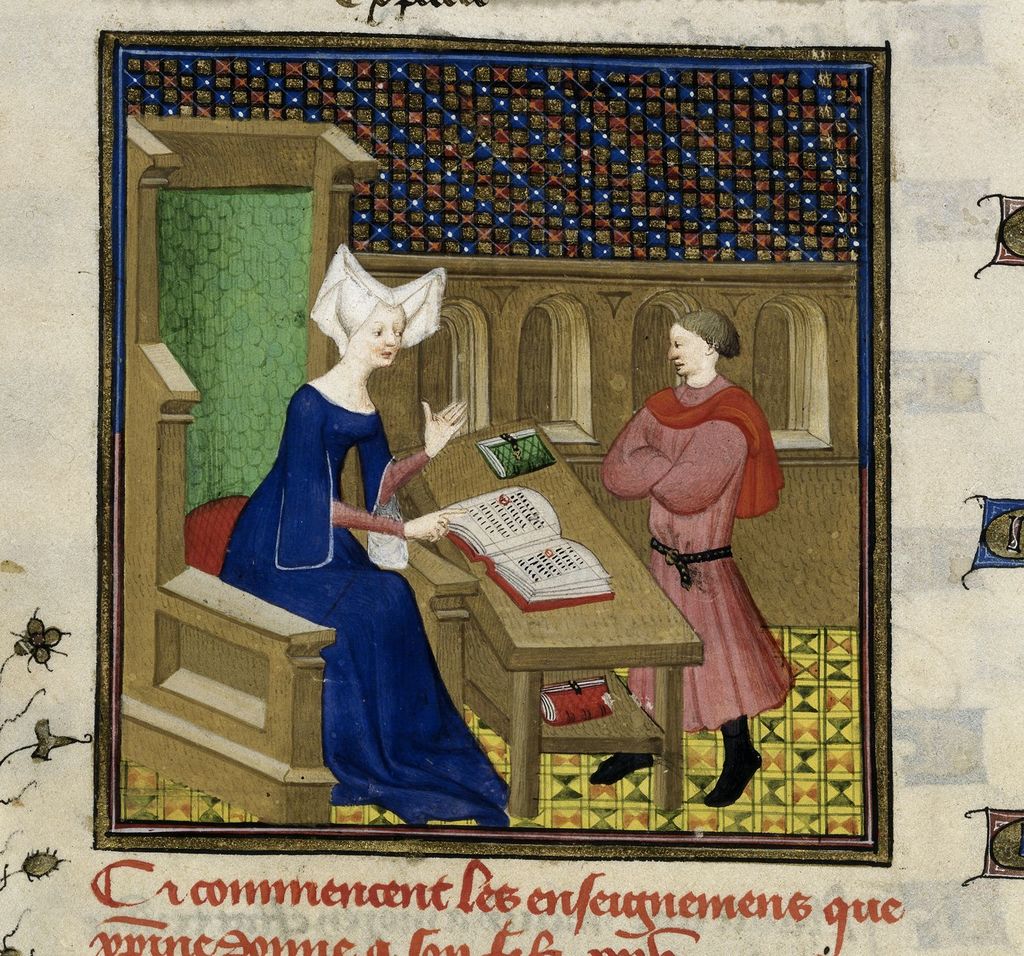7.8: Northern Europe in the 15th century- Northern Renaissance
- Last updated
- Save as PDF
- Page ID
- 147798
Northern Europe: 15th century
The Renaissance north of the Alps.
1400 - 1500 (Renaissance)
Beginner’s guide: Northern Europe in the 15th century
Much changed in northern Europe in the fifteenth and sixteenth centuries.
1400 - 1500
Some of the most important changes in northern Europe include the invention of the printing press, the formation of a merchant class of art patrons that purchased works in oil on panel, the Protestant Reformation and the translation of the Bible from the original languages into the vernacular or common languages such as German and French, and international trade in urban centers.
The Medieval and Renaissance Altarpiece
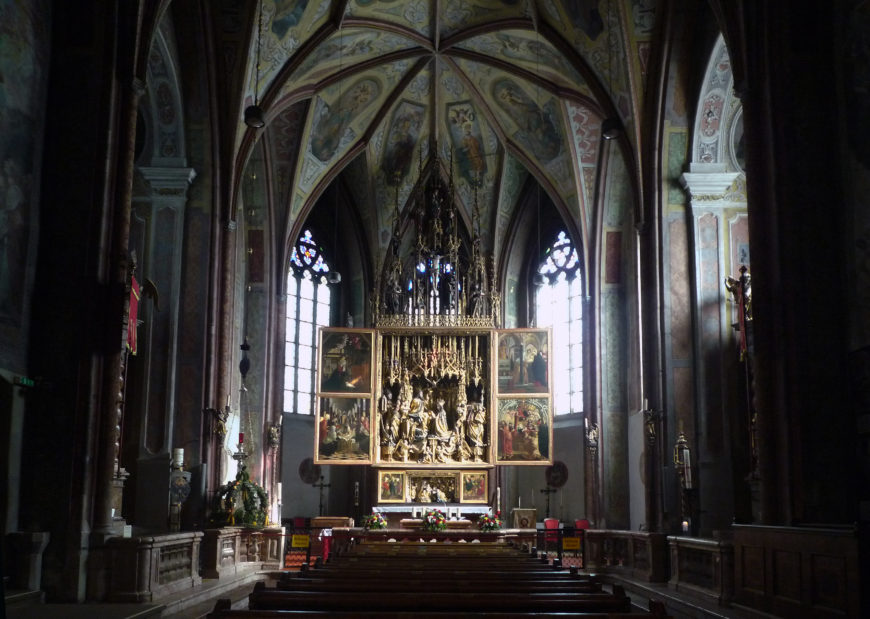
The altar and the sacrament of the Eucharist
Every architectural space has a gravitational center, one that may be spatial or symbolic or both; for the medieval church, the altar fulfilled that role. This essay will explore what transpired at the altar during this period as well as its decoration, which was intended to edify and illuminate the worshippers gathered in the church.
The Christian religion centers upon Jesus Christ, who is believed to be the incarnation of the son of God born to the Virgin Mary.
During his ministry, Christ performed miracles and attracted a large following, which ultimately led to his persecution and crucifixion by the Romans. Upon his death, he was resurrected, promising redemption for humankind at the end of time.
The mystery of Christ’s death and resurrection are symbolically recreated during the Mass (the central act of worship) with the celebration of the Eucharist — a reminder of Christ’s sacrifice where bread and wine wielded by the priest miraculously embodies the body and blood of Jesus Christ, the Christian Savior.
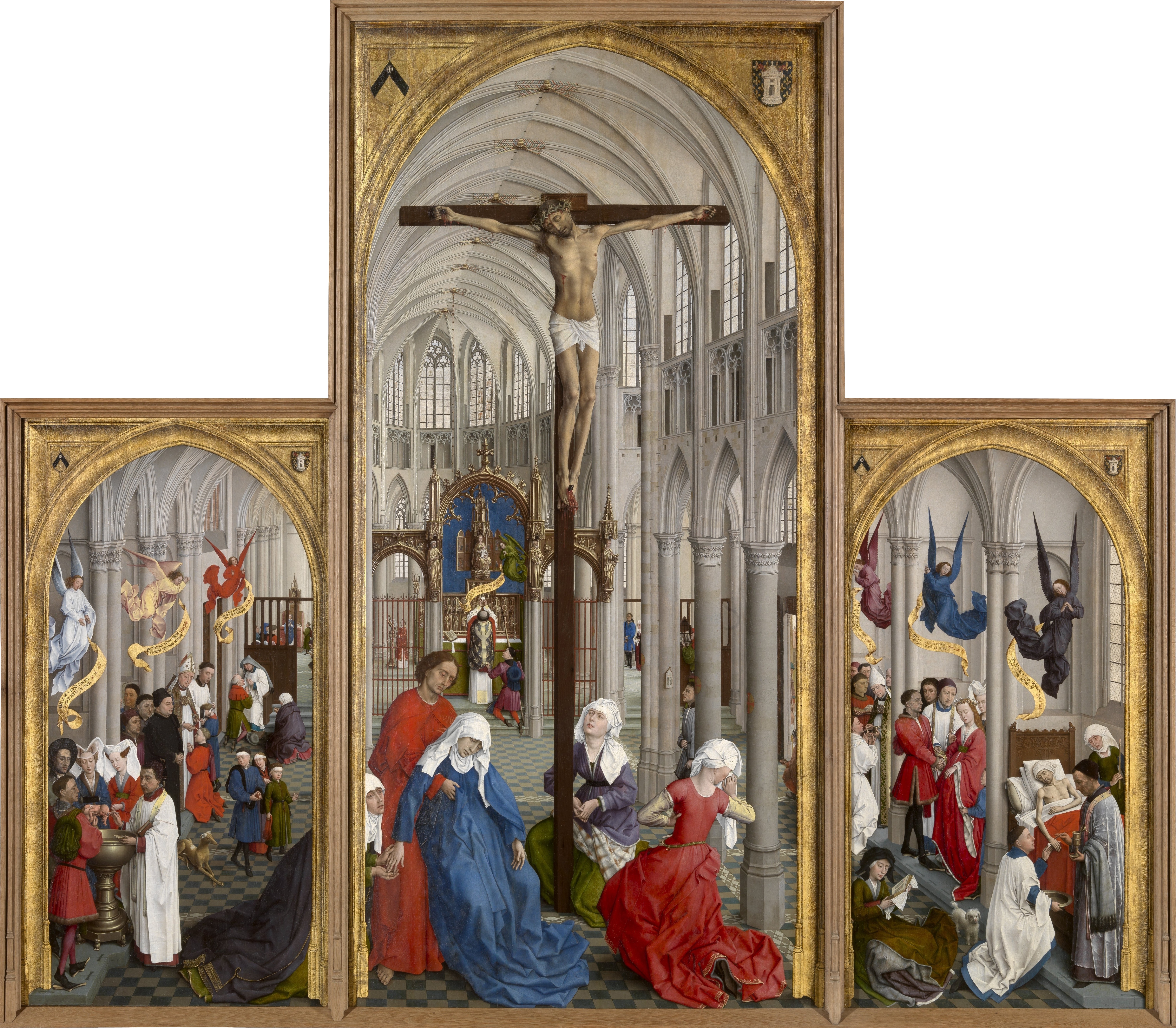
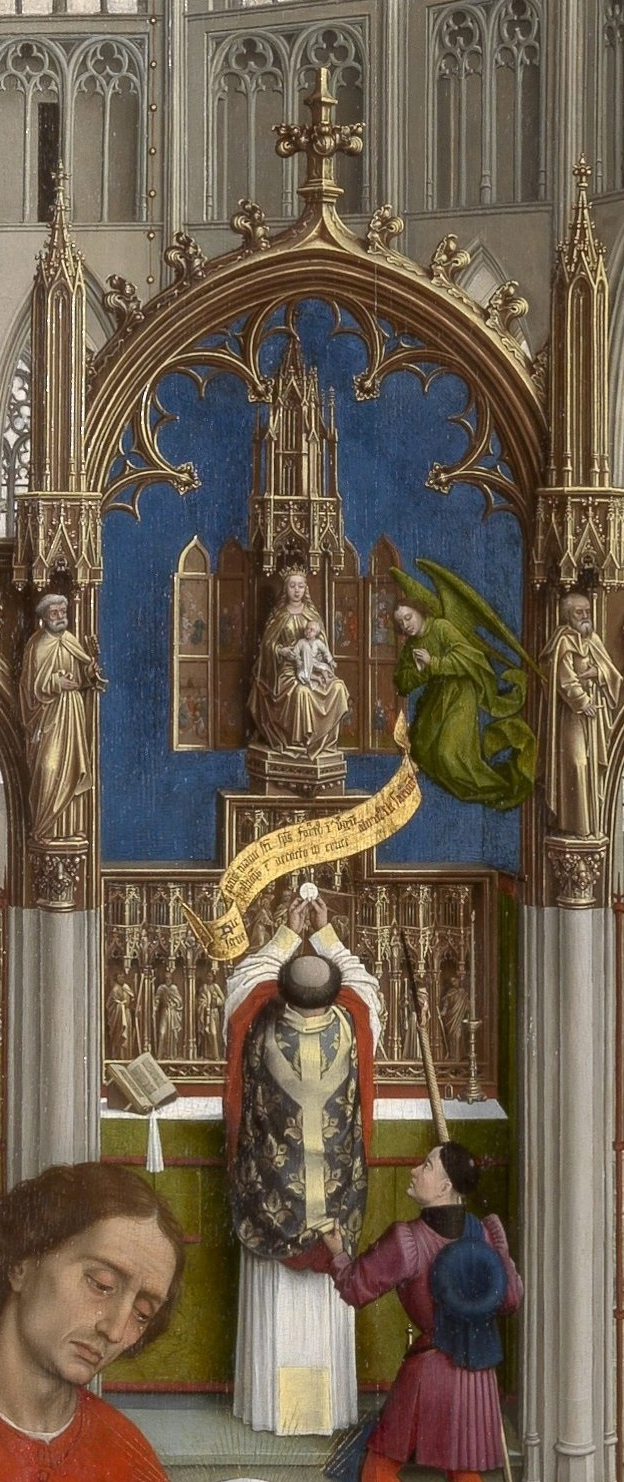
The altar came to symbolize the tomb of Christ. It became the stage for the sacrament of the Eucharist, and gradually over the course of the Early Christian period began to be ornamented by a cross, candles, a cloth (representing the shroud that covered the body of Christ), and eventually, an altarpiece (a work of art set above and behind an altar).
In Rogier van der Weyden’s Altarpiece of the Seven Sacraments, one sees Christ’s sacrifice and the contemporary celebration of the Mass joined. The Crucifixion of Christ is in the foreground of the central panel of the triptych with St. John the Evangelist and the Virgin Mary at the foot of the cross, while directly behind, a priest celebrates the Eucharist before a decorated altarpiece upon an altar.
Though altarpieces were not necessary for the Mass, they became a standard feature of altars throughout Europe from the thirteenth century, if not earlier. One of the factors that may have influenced the creation of altarpieces at that time was the shift from a more cube-shaped altar to a wider format, a change that invited the display of works of art upon the rectangular altar table.
Though the shape and medium of the altarpiece varied from country to country, the sensual experience of viewing it during the medieval period did not: chanting, the ringing of bells, burning candles, wafting incense, the mesmerizing sound of the incantation of the liturgy, and the sight of the colorful, carved story of Christ’s last days on earth and his resurrection would have stimulated all the senses of the worshipers. In a way, to see an altarpiece was to touch it—faith was experiential in that the boundaries between the five senses were not so rigorously drawn in the Middle Ages. For example, worshipers were expected to visually consume the Host (the bread symbolizing Christ’s body) during Mass, as full communion was reserved for Easter only.
Saints and relics
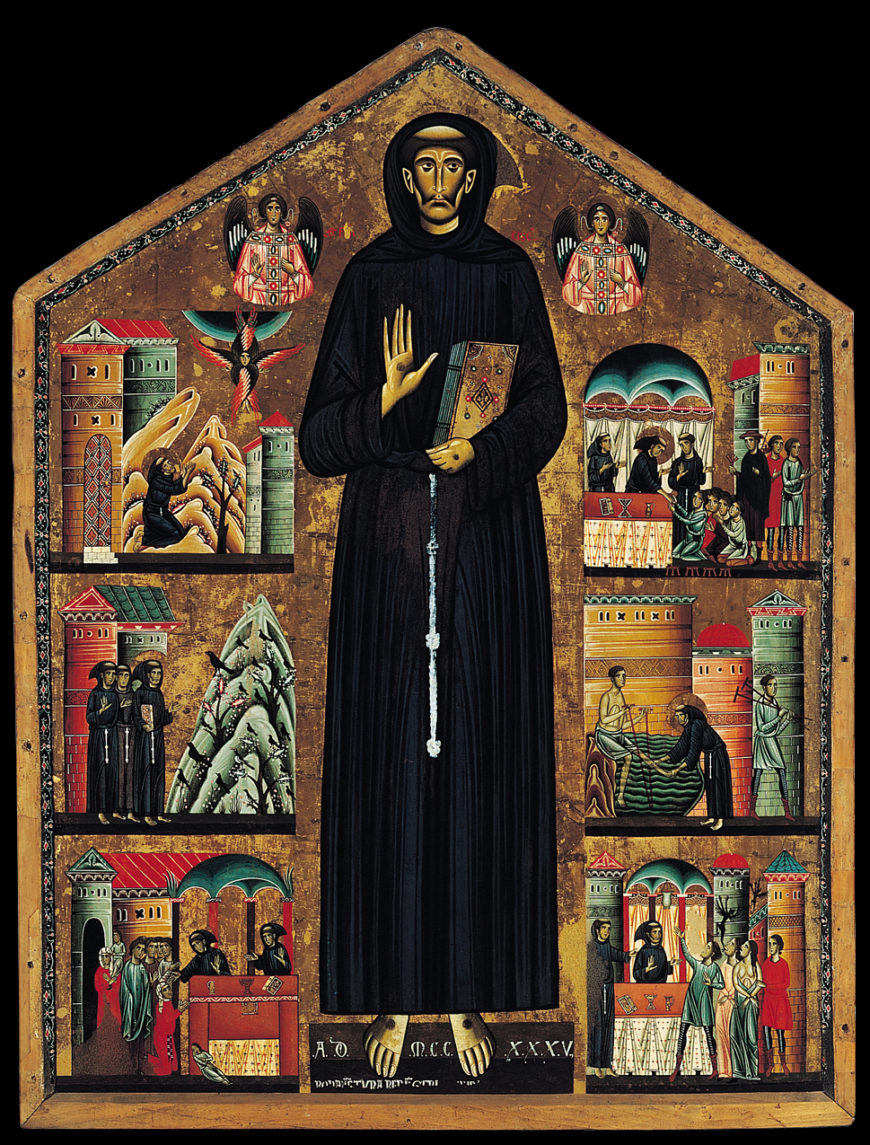
Since the fifth century, saints’ relics (fragments of venerated holy persons) were embedded in the altar, so it is not surprising that altarpieces were often dedicated to saints and the miracles they performed. Italy in particular favored portraits of saints flanked by scenes from their lives, as seen, for example, in the image of St. Francis of Assisi by Bonaventura Berlinghieri in the Church of San Francesco in Pescia.
The Virgin Mary and the Incarnation of Christ were also frequently portrayed, though the Passion of Christ (and his resurrection) most frequently provided the backdrop for the mystery of Transubstantiation celebrated on the altar. The image could be painted or sculpted out of wood, metal, stone, or marble; relief sculpture was typically painted in bright colors and often gilded.
Germany, the Low Countries, and Scandinavia were most often associated with polyptychs (many-paneled works) that have several stages of closing and opening, in which a hierarchy of different media from painting to sculpture engaged the worshiper in a dance of concealment and revelation that culminated in a vision of the divine.
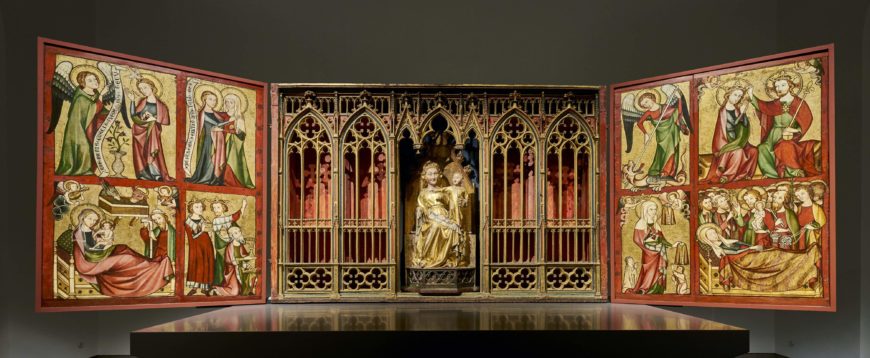
For example, the altarpiece from Altenberg contained a statue of the Virgin and Christ Child which was flanked by double-hinged wings that were opened in stages so that the first opening revealed painted panels of the Annunciation, Nativity, Death and Coronation of the Virgin (image above). The second opening disclosed the Visitation, Adoration of the Magi, and the patron saints of the Altenberg cloister, Michael and Elizabeth of Hungary. When the wings were fully closed, the Madonna and Child were hidden and painted scenes from the Passion were visible.
Variations
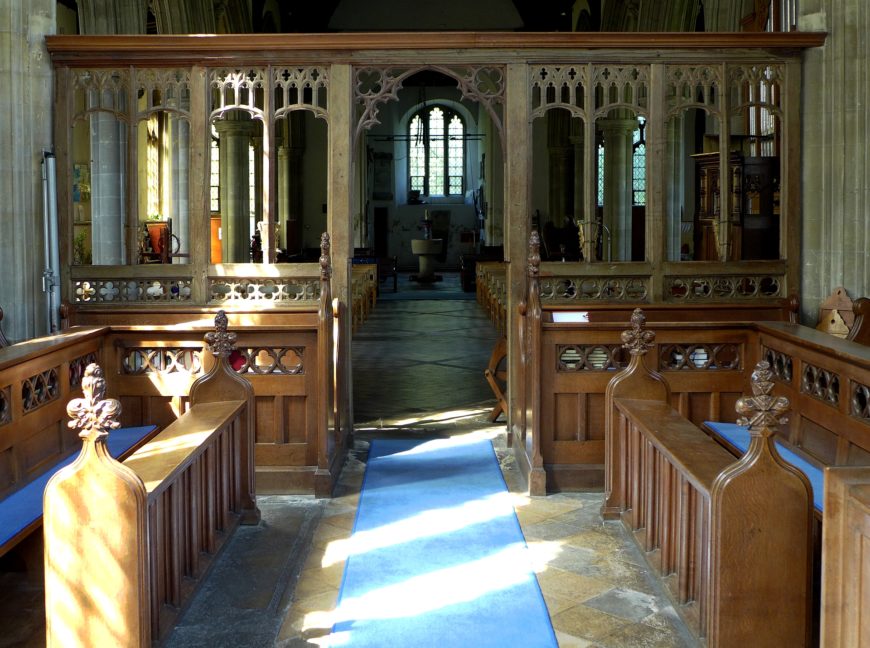
English parish churches had a predilection for rood screens, which were a type of carved barrier separating the nave (the main, central space of the church) from the chancel. Altarpieces carved out of alabaster became common in fourteenth-century England, featuring scenes from the life of Christ; these were often imported by other European countries.
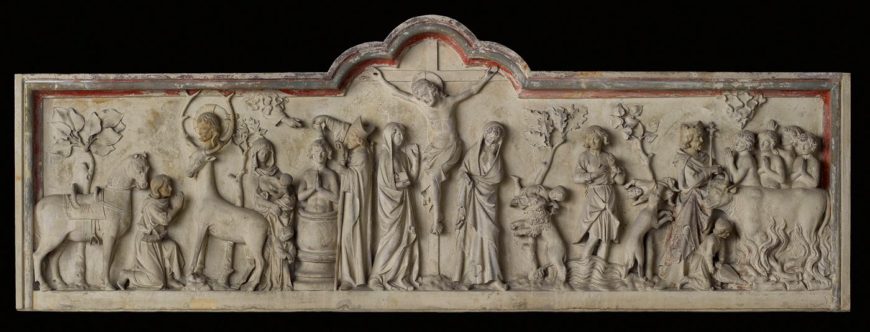
The abbey of St.-Denis in France boasted a series of rectangular stone altarpieces that featured the lives of saints interwoven with the most important episodes of Christ’s life and death. For example, the life of St. Eustache unfolds to either side of the Crucifixion on one of the altarpieces, the latter of which participated in the liturgical activities of the church and often reflected the stained-glass subject matter of the individual chapels in which they were found.
Gothic beauty
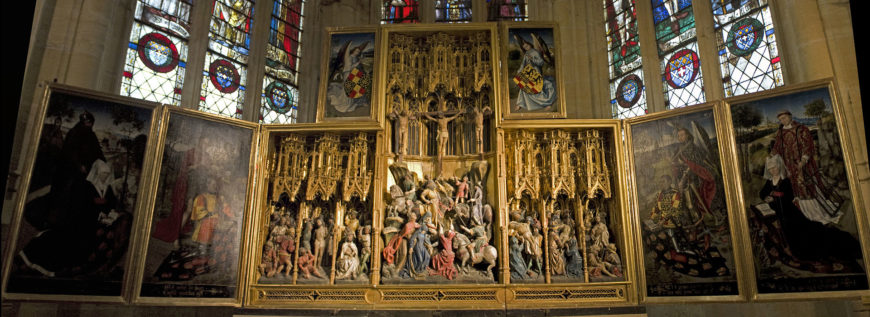
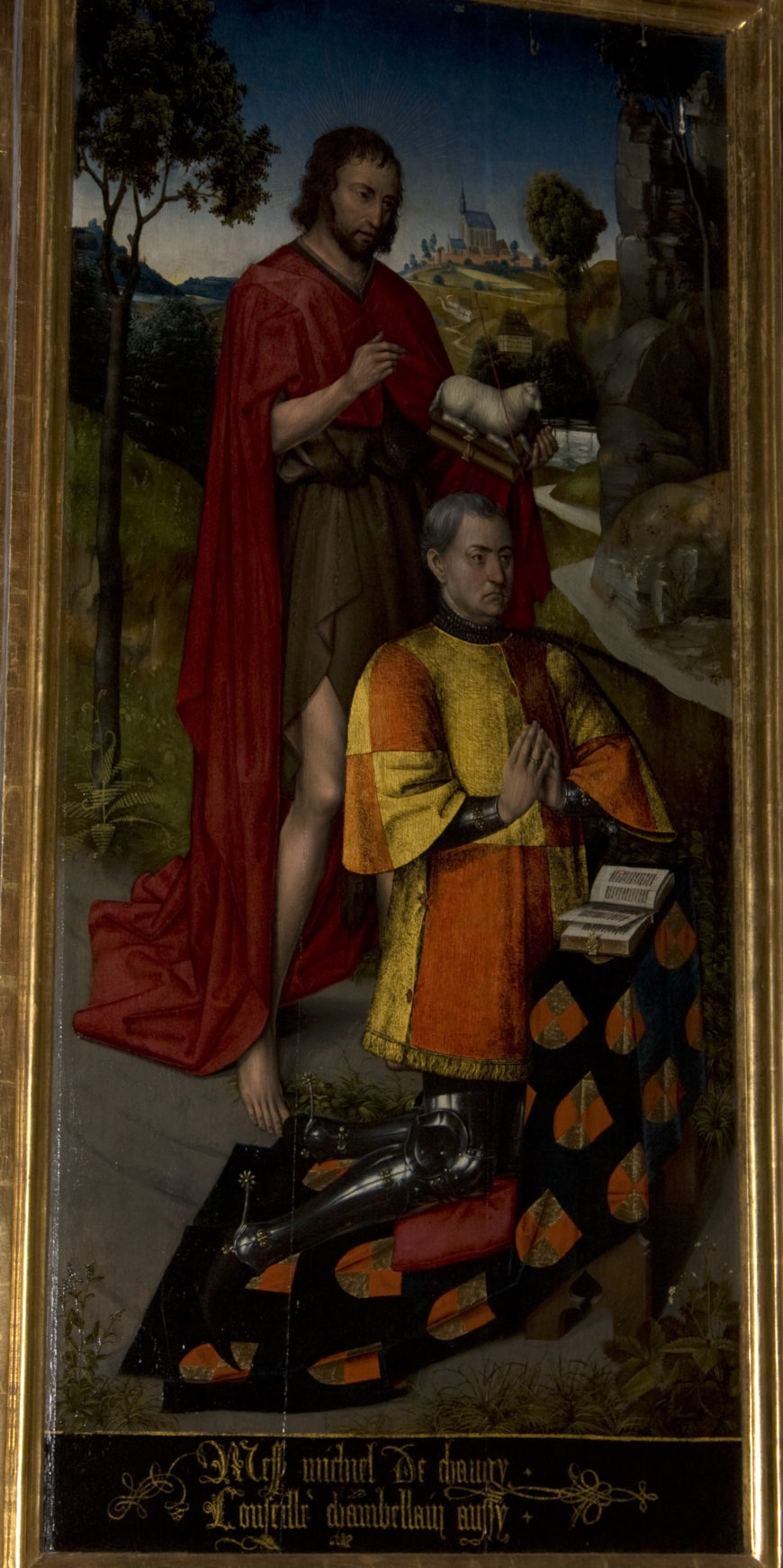
In the later medieval period in France (15th–16th centuries), elaborate polyptychs with spiky pinnacles and late Gothic tracery formed the backdrop for densely populated narratives of the Passion and resurrection of Christ. In the seven-paneled altarpiece from the church of St.-Martin in Ambierle, the painted outer wings represent the patrons with their respective patron saints and above, the Annunciation to the Virgin by the archangel Gabriel of the birth of Christ. On the outer sides of these wings, painted in grisaille are the donors’ coats of arms.
Turrets (towers) crowned by triangular gables and divided by vertical pinnacles with spiky crockets create the framework of the polychromed and gilded wood carving of the inner three panels that house the story of Christ’s torture and triumph over death against tracery patterns that mimic stained glass windows found in Gothic churches.
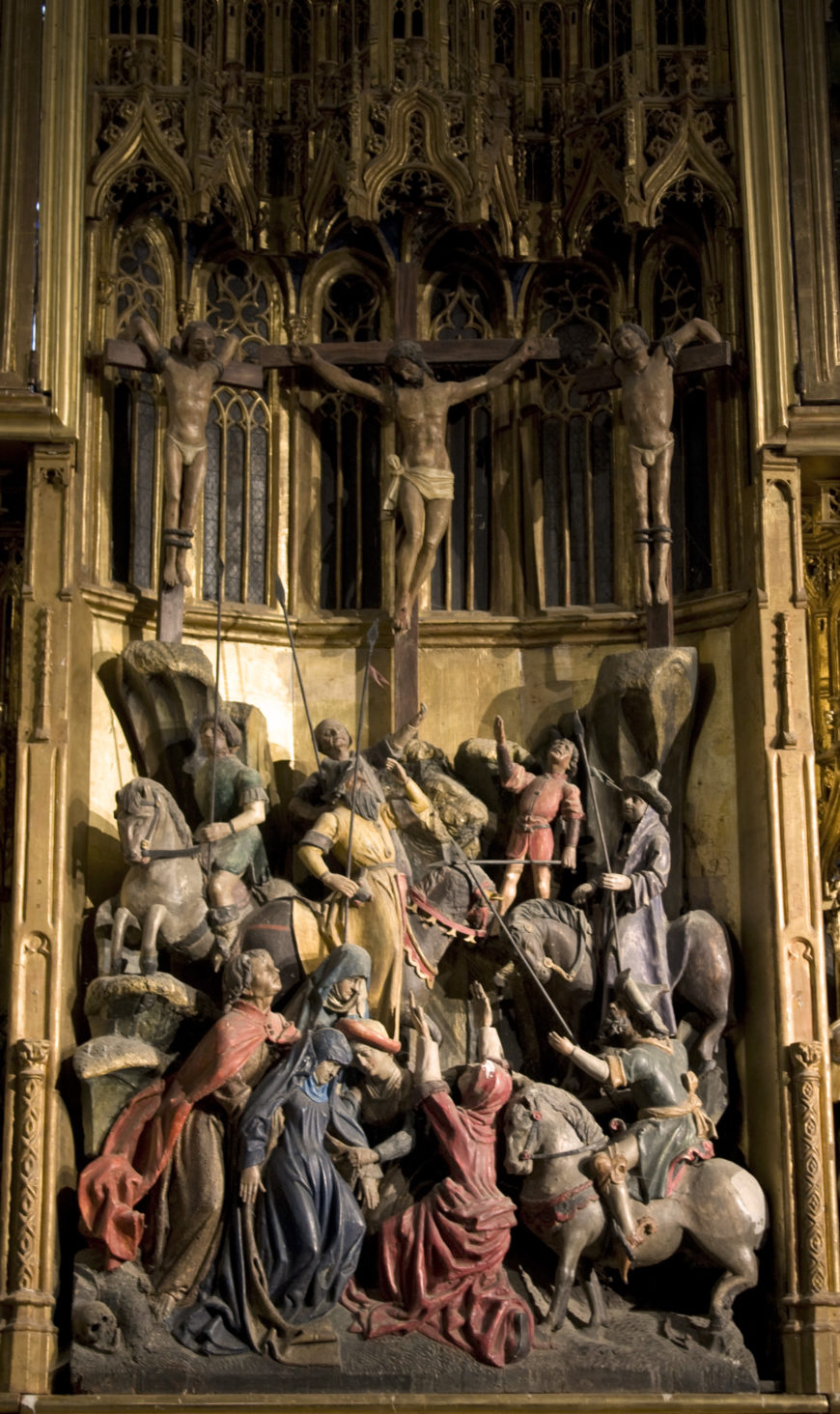
To the left, one finds the Betrayal of Christ, the Flagellation, and the Crowning with the Crown of Thorns — scenes that led up to the death of Christ. The Crucifixion occupies the elevated central portion of the altarpiece, and the Descent from the Cross, the Entombment, and Resurrection are represented on the right side of the altarpiece.
There is an immediacy to the treatment of the narrative that invites the worshiper’s immersion in the story: anecdotal detail abounds, the small scale and large number of the figures encourage the eye to consume and possess what it sees in a fashion similar to a child’s absorption before a dollhouse. The scenes on the altarpiece are made imminently accessible by the use of contemporary garb, highly detailed architectural settings, and exaggerated gestures and facial expressions.
One feels compelled to enter into the drama of the story in a visceral way—feeling the sorrow of the Virgin as she swoons at her son’s death. This palpable quality of empathy that propels the viewer into the Passion of Christ makes the historical past fall away: we experience the pathos of Christ’s death in the present moment.
According to medieval theories of vision, memory was a physical process based on embodied visions. According to one twelfth-century thinker, they imprinted themselves upon the eyes of the heart. The altarpiece guided the faithful to a state of mind conducive to prayer, promoted communication with the saints, and served as a mnemonic device for meditation, and could even assist in achieving communion with the divine.
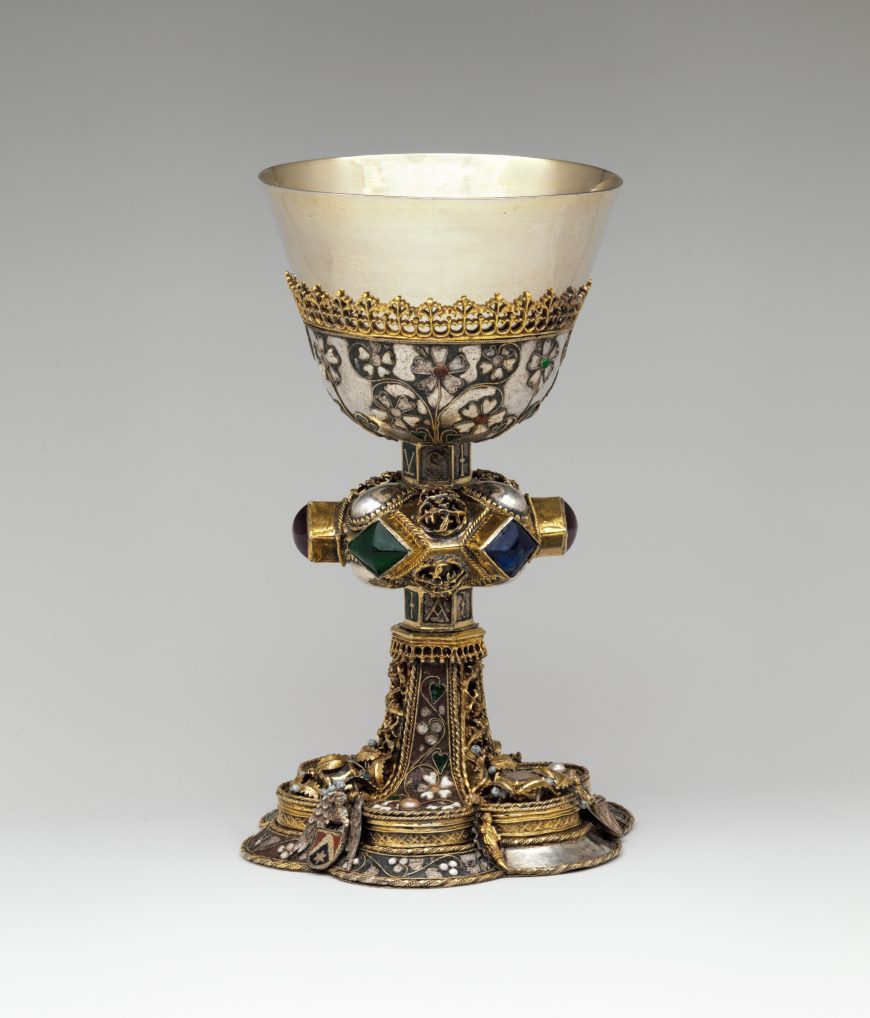
The altar had evolved into a table that was alive with color, often with precious stones, with relics, the chalice (which held the wine) and paten (which held the Host) consecrated to the blood and body of Christ, and finally, a carved and/or painted retable: this was the spectacle of the holy.
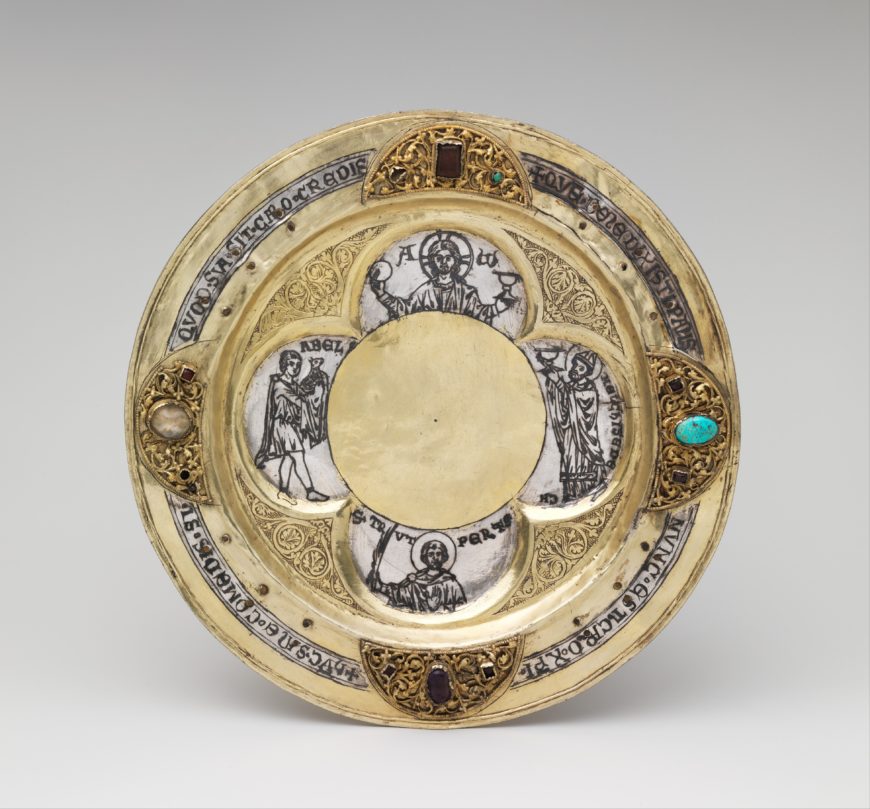
As Jean-Claude Schmitt put it:
this was an ensemble of sacred objects, engaged in a dialectic movement of revealing and concealing that encouraged individual piety and collective adherence to the mystery of the ritual.J.-C. Schmitt , “Les reliques et les images,” in Les reliques: Objets, cultes, symbols
(Turnhout: 1999)
The story embodied on the altarpiece offered an object lesson in the human suffering experienced by Christ. The worshiper’s immersion in the death and resurrection of Christ was also an engagement with the tenets of Christianity, poignantly transcribed upon the sculpted, polychromed altarpieces.
Additional resources
Hans Belting, Likeness and Presence: A History of the Image before the Era of Art, trans. Edmond Jephcott (Chicago: University of Chicago Press, 1994).
Paul Binski, “The 13th-Century English Altarpiece,” in Norwegian Medieval Altar Frontals and Related Materials. Institutum Romanum Norvegiae, Acta ad archaeologiam et atrium historiam pertinentia 11, pp. 47–57 (Rome: Bretschneider, 1995).
Shirley Neilsen Blum, Early Netherlandish Triptychs: A Study in Patronage (Berkeley and Los Angeles: University of California Press, 1969).
Marco Ciatti, “The Typology, Meaning, and Use of Some Panel Paintings from the Duecento and Trecento,” in Italian Panel Painting of the Duecento and Trecento, ed. Victor M. Schmidt, 15–29. Studies in the History of Art 61. Center for the Advanced Study in the Visual Arts. Symposium Papers 38 (New Haven and London: Yale University Press, 2002).
Donald L. Ehresmann, “Some Observations on the Role of Liturgy in the Early Winged Altarpiece,” Art Bulletin 64/3 (1982), pp. 359–69.
Julian Gardner, “Altars, Altarpieces, and Art History: Legislation and Usage,” in Italian Altarpieces 1250–1500: Function and Design, ed. Eve Borsook and Fiorella Superbi Gioffredi, 5–39 (Oxford: Oxford University Press, 1994).
Peter Humfrey and Martin Kemp, eds., The Altarpiece in the Renaissance (Cambridge: Cambridge University Press, 1990).
Lynn F. Jacobs, “The Inverted ‘T’-Shape in Early Netherlandish Altarpieces: Studies in the Relation between Painting and Sculpture” Zeitschrift für Kunstgeschichte 54/1 (1991), pp. 33–65.
Lynn F. Jacobs, Early Netherlandish Carved Altarpieces, 1380–1550: Medieval Tastes and Mass Marketing (New York: Cambridge University Press, 1998).
Justin E.A. Kroesen and Victor M. Schmidt, eds., The Altar and its Environment, 1150–1400 (Turnhout: Brepols, 2009).
Barbara G. Lane, The Altar and the Altarpiece: Sacramental Themes in Early Netherlandish Painting (New York: Harper & Row, 1984).
Henning Laugerud, “To See with the Eyes of the Soul, Memory and Visual Culture in Medieval Europe,” in ARV, Nordic Yearbook of Folklore Studies 66 (Uppsala: Swedish Science Press, 2010), pp. 43–68.
Éric Palazzo, “Art and the Senses: Art and Liturgy in the Middle Ages,” in A Cultural History of the Senses in the Middle Ages, ed. Richard Newhauser, pp. 175–94 (London, New Delhi, Sidney: Bloomsbury Academic, 2014).
Donna L. Sadler, Touching the Passion—Seeing Late Medieval Altarpieces through the Eyes of Faith (Leiden: Brill, 2018).
Beth Williamson, “Altarpieces, Liturgy, and Devotion,” Speculum 79 (2004): 341–406.
Beth Williamson, “Sensory Experience in Medieval Devotion: Sound and Vision, Invisibility and Silence,” Speculum 88 1 (2013), pp. 1–43.
Kim Woods, “The Netherlandish Carved Altarpiece c. 1500: Type and Function,” in Humfrey and Kemp, The Altarpiece in the Renaissance, pp. 76–89.
Kim Woods, “Some Sixteenth-Century Antwerp Carved Wooden Altar-Pieces in England,” Burlington Magazine 141/1152 (1999), pp.144–55.
An introduction to the Northern Renaissance in the fifteenth century
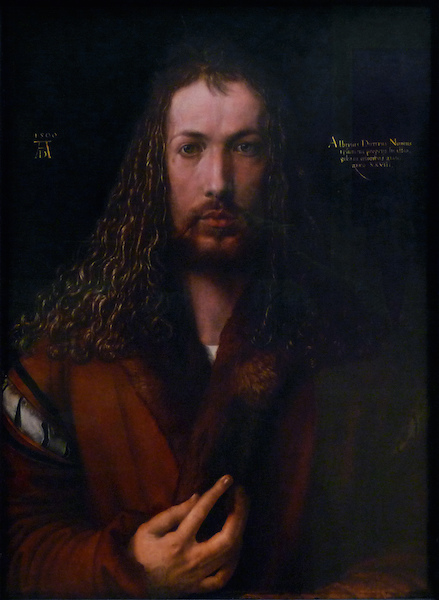
What was the Renaissance and where did it happen?
The word Renaissance is generally defined as the rebirth of classical antiquity in Italy in the fifteenth and sixteenth centuries. Seems simple enough, but the word “Renaissance” is actually fraught with complexity.
Scholars argue about exactly when the Renaissance happened, where it took place, how long it lasted, or if it even happened at all. Scholars also disagree about whether the Renaissance is a “rebirth” of classical antiquity (ancient Greece and Rome) or simply a continuation of classical traditions but with different emphases.
Traditional accounts of the Renaissance favor a narrative that places the birth of the Renaissance in Florence, Italy. In this narrative, Italian art and ideas migrate North from Italy (largely because of the travels of the great German artist Albrecht Dϋrer who studied, admired, and was inspired by Italy, and he carried his Italian experiences back to Germany).
The Renaissance in Northern Europe
However, so much changed in northern Europe in the fifteenth and sixteenth centuries that the era deserves to be evaluated on its own terms. So we use the term “Northern Renaissance” to refer to the Renaissance that occurred in Europe north of the Alps.
Some of the most important changes in northern Europe include the:
- – invention of the printing press, c. 1450
- – advent of mechanically reproducible media such as woodcuts and engravings
- – formation of a merchant class of art patrons that purchased works in oil on panel
- – Protestant Reformation and the translation of the Bible from the original languages into the vernacular or common languages such as German and French
- – international trade in urban centers
The fifteenth century: van Eyck


In the fifteenth century, northern artists such as Jan van Eyck introduced powerful and influential changes, such as the perfection of oil paint and almost impossible representation of minute detail, practices that clearly distinguish Northern art from Italian art as well as art from the preceding centuries. Jan and Hubert van Eyck’s Ghent Altarpiece, 1432 (Church of Saint Bavo, Ghent) exemplifies the grand scale and minute detail of Northern painting.
This public, religious picture has an opened and closed position. On the interior (above) we see such holy figures as the Virgin, Christ, saints and angels. It also showcases the largesse of the donors (left), depicted kneeling on the lowest corners of the exterior, who employed the van Eyck brothers to immortalize them in this very public work of art.

Jan van Eyck’s Arnolfini Double Portrait (1434) shows a well-to-do couple in a tasteful, bourgeois interior. The text in the back of the image identifies the date and Jan van Eyck as the artist. Art historians disagree about what is actually happening in the image, whether this is a betrothal or a marriage, or perhaps something else entirely. One of the most important aspects of this painting is the symbolic meanings of the objects, for instance that the dog may symbolize fidelity (“Fido”) or that the fruit on the windowsill may signify either wealth or temptation. This painting is a touchstone for the study of iconography, a method of interpreting works of art by deciphering symbolic meaning.
Though Jan van Eyck did not invent oil paint, he used the medium to greater effect than any other artist to date. Oil would become a predominant medium for painting for centuries, favored in art academies into the nineteenth century and beyond. The Arnolfinis counted as middle class because their wealth came from trade rather than inherited titles and land. The power of the merchant-class patrons of northern Europe cultivated a taste for art made for domestic display. Decorating one’s home is still a powerful motivation for art patrons. Museum visitors repeatedly comment, “well, I wouldn’t want it in my living room.”
Additional resources:
Jan van Eyck on The Metropolitan Museum of Art’s Heilbrunn Timeline of Art History
Smarthistory images for teaching and learning:
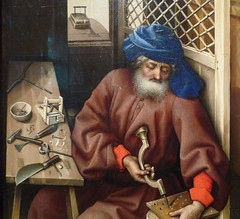
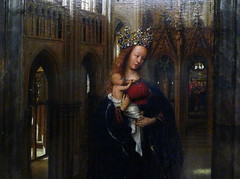
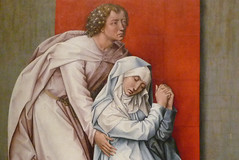


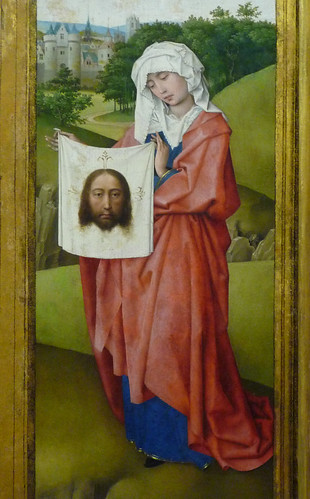
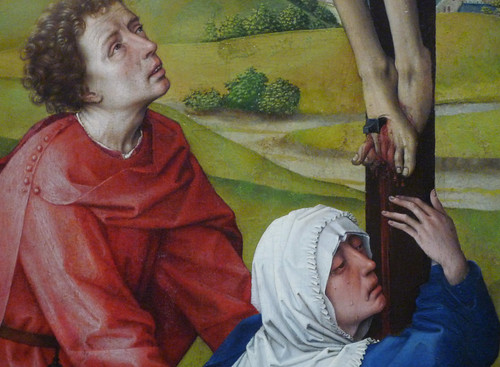
Introduction to Fifteenth-century Flanders

Material splendor
Jan van Eyck’s Rolin Madonna presents a series of objects and surfaces: a fur-lined damask robe, ceramic tiles, a golden crown, stone columns, warm flesh, flowers, translucent glass, and a reflective body of water. Even the air above the distant river seems palpable. The painting is a careful study of how light reacts to the varying textures. But the scene is an imagined one. Before a kneeling man the Virgin presents on her lap the Christ child, and an angel holds a crown above her. No eye contact is made. It is as if we are seeing what the man has in his mind’s eye as he prays from the book in front of him. While the sumptuousness of the surroundings belie the otherworldliness of the Mother and Child, at the same time they seem to augment rather than diminish their divinity. For Nicolas Rolin, the man in this image, it seems that attention to the magnificence and splendor of valuable arts and materials can provide a vision of the sacred, rather than distract from it.
Although Jan van Eyck’s painting is an exceptional artwork, it is typical of fifteenth-century Flemish art in the value it attributes to material splendor. The area of the southern Low Countries was one of the major contributors to what is often referred to as the Northern Renaissance—the efflorescence of artistic production that took place north of the Alps in the fifteenth and sixteenth centuries.
Flemish art
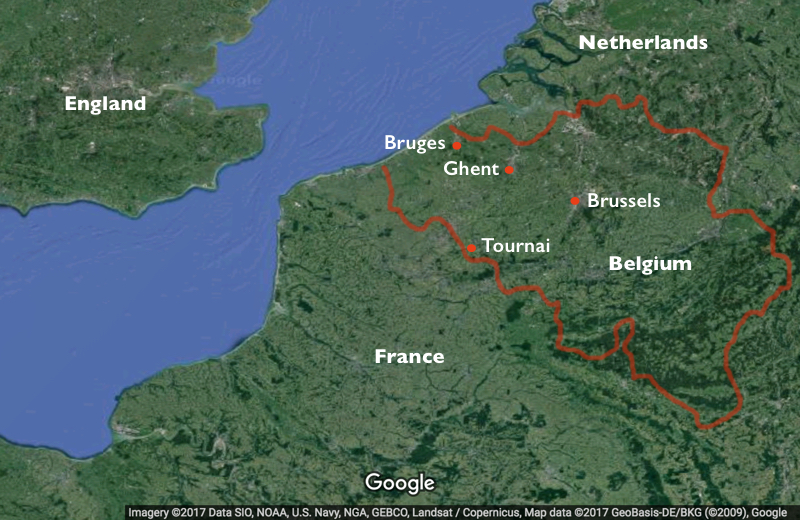
“Flemish art” is a difficult term: medieval Flanders does not have the same borders as it does today. It is used by art historians loosely to refer to artistic production in Flemish speaking towns—particularly Bruges, Ghent, Brussels and Tournai. The term is also most often associated with painting. Painters like Jan van Eyck, Rogier van der Weyden, and Hugo van der Goes were as internationally famous in their time as they are now, finding patrons not only in the Low Countries (today Netherlands, Belgium and northern Germany), but in Italy also, where their oil-paint technique had a considerable influence.
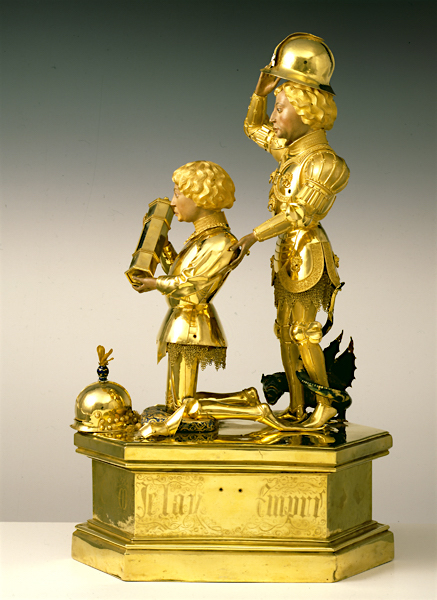
However, just as van Eyck was attentive to the range of crafted objects in the Rolin Madonna, we too should be observant of the many arts practiced in fifteenth-century Flanders. There were workshops across the major towns of Flanders for goldsmiths, ceramicists, cabinet-makers, manuscript illuminators, tapestry weavers, and sculptors in wood and stone.
More than paintings
The most expensive artworks were tapestries and goldwork and nobles would commission these as gifts for their allies and relatives. The prominence painting is given today is partly because our culture values painting as a “fine art” alongside sculpture and architecture, and thus one distinct from the “decorative” or “applied” arts of other media. It is important to understand that these distinctions did not exist in the fifteenth-century Low Countries. Therefore, when visiting collections in search of Netherlandish art, also take time to seek out the rare surviving goldwork, tapestries, and sculpture. Singular pieces include the Liège statuette (a reliquary with images of Charles the Bold and St George in the Cathedral of Liège), the Burgundian tapestries at Bern Historical Museum, and the tombs of Mary of Burgundy and Charles the Bold in the Church of our Lady in Bruges.
A major trading center
To understand why Flanders became the site of such intensive artistic production in the fifteenth century, it is useful to consider its place within the wider western European economy. Flanders was the most urbanized region of northern Europe in the fourteenth and fifteenth centuries. Between c. 1000 and 1300, its town and ports grew in size and number as it became the major center for trade in northern Europe, acting as a nodal point for merchants from England, the Baltic, Italy, and France. For this reason, its cities, particularly Bruges and Ghent, became centers of artistic production.
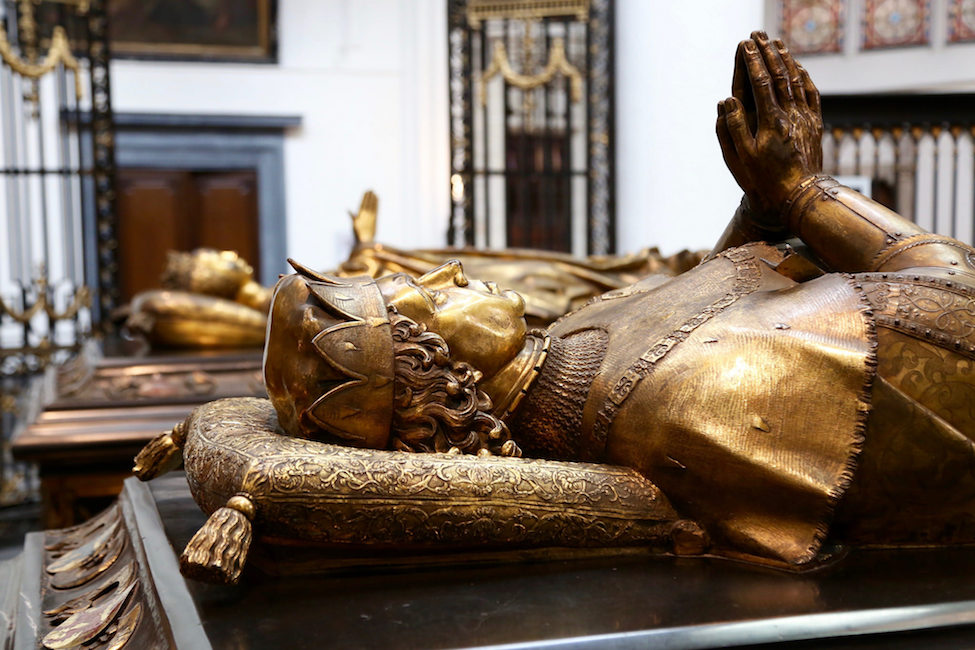
Craftsmen of all types—including painters, tapestry manufacturers, manuscript illuminators, goldsmiths, and sculpture in wood and stone—could rely on the trade networks that brought raw materials to these cities. Painters and sculptors established their own workshops and joined guilds that regulated the quality of their products, the prices for which they could be sold, as well as license those allowed to practice these crafts. The towns themselves often acted as a patrons, often commissioning sculpture and coats-of-arms for their municipal buildings. Particularly wealthy citizens also acted as patrons for some of the most famous Flemish paintings: Hubert and Jan van Eyck’s famous Ghent Altarpiece, made in 1432 for Ghent’s cathedral of Saint Bavo, was financed by the Ghent merchant Jodocus Vijd; the Italian banker and Bruges resident Tommaso Portinari was the patron of van der Goes’s Portinari Altarpiece; whereas the guild of archers of Leuven commissioned van der Weyden’s Descent from the Cross.
The Flemish towns therefore functioned as a crucible for both the highly specialized workshop labor needed to produce high-quality paintings, goldwork, textiles, and sculptures, and for the wealthy patrons that the craftsmen relied on. The fifteenth-century efflorescence of art in Flanders also coincided with the demographic recovery after the shock of the Black plague in the mid-fourteenth century. In addition, the wars between France and England, which had slowed the Flemish economy, gradually subsided during this period. But these were not the only factors in the development of Flemish visual art. Another major source of patronage came from the Burgundian court.

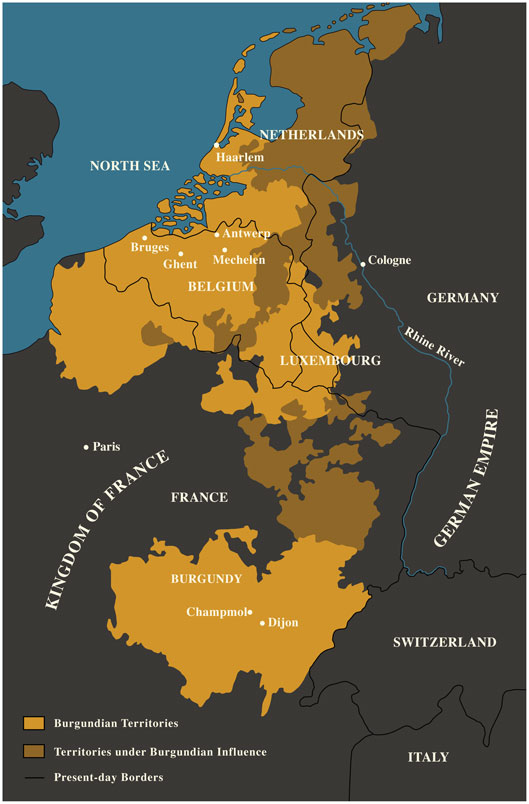
Part of the Burgundian court
In 1384 the count of Flanders, Louis II, died, and he was succeeded by his son-in-law, Philip the Bold, the fourth son of King John II of France and the Duke of Burgundy. Flanders was from then ruled by a series of Burgundian dukes, and many craftsmen from the Flemish towns were enlisted by the Burgundian court where they would work for the duke and his courtiers. To return to where we began, Nicolas Rolin, the man depicted in Van Eyck’s Rolin Madonna and the patron of that painting, was a high-ranking Burgundian courtier. In addition to being a patron of van Eyck, he also commissioned van der Weyden to make a large altarpiece for the hospice he endowed in Beaune (where it can still be seen).
After the death of Duke Charles the Bold in 1477, the Burgundian lands were partitioned between France and the Holy Roman Empire, and many Netherlandish artists lost the court’s patronage as a result. Furthermore, the towns of Bruges and Brussels were losing their economic importance to Antwerp, and the painters there favored a quicker method of painting suited for widespread sale on that city’s international markets, rather than the slower, more layered and labored technique of their forebears. However, the influence of fifteenth-century Netherlandish painting would continue into the next century, particularly in the closely observed still life and portrait paintings by court artists such as Hans Holbein the Younger and Albrecht Dürer.
Additional resources:
Northern European Painting of the 15th-16th centuries from the National Gallery of Art
Burgundian Netherlands on The Metropolitan Museum of Art’s Heilbrunn Timeline of Art History
Jan van Eyck on The Metropolitan Museum of Art’s Heilbrunn Timeline of Art History
Early Netherlandish Painting on The Metropolitan Museum of Art’s Heilbrunn Timeline of Art History
Guy Delmarcel, Flemish Tapestry from the 15th to the 18th Century, trans. Alastair Weir (Tielt, 1999)
Craig Harbison, The Mirror of the Artist: Northern Renaissance Art in its Historical Context (New York, 1995)
Craig Harbison, Jan van Eyck: The Play of Realism (2nd ed.; London, 2012)
Susie Nash, Northern Renaissance Art (Oxford, 2008)
James Snyder, Northern Renaissance Art: Painting, Sculpture, the Graphic Arts from 1350 to 1575 (2nd ed.;New York, 2005)
Hugo Van der Velden, The Donor’s Image: Gerard Loyet and the votive portraits of Charles the Bold (Turnhout, 2000)
Introduction to Burgundy in the Fifteenth Century
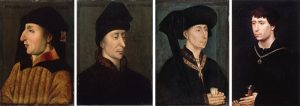
“The unlimited arrogance of Burgundy! The whole history of that family, from the deeds of knightly bravado, in which the fast-rising fortunes of the first Philip take root, to the bitter jealousy of John the Fearless and the black lust for revenge in the years after his death, through the long summer of that other magnifico, Philip the Good, to the deranged stubbornness with which the ambitious Charles the Bold met his ruin – is this not a poem of heroic pride? Burgundy, as dark with power as with wine…greedy, rich Flanders. These are the same lands in which the splendour of painting, sculpture, and music flower, and where the most violent code of revenge ruled and the most brutal barbarism spread among the aristocracy.”
—Johan Huizinga, The Autumn of the Middle Ages, 1919 (1996 english ed.)

This remarkable passage from Johan Huizinga’s early twentieth-century classic The Autumn of the Middle Ages anticipated how the history of Burgundy has been written by many later historians: that is, as a series of successive dukes (Philip the Bold, John the Fearless, Philip the Good, and Charles the Bold).
The first of these, Philip the Bold, became one of the wealthiest individuals in western Europe after he inherited the county of Flanders from his father-in-law in 1384, adding to his lands in Burgundy. His successors expanded on these holdings to create a territorial power located between France and the Habsburg Empire.
From the beginning, the dukes of Burgundy aspired to rival kings in their magnificence and authority. Their wealth and access to Flemish craftsmen enabled the dukes to produce one of the most visually splendorous court cultures in western Europe, one that in turn influenced royal patronage and ceremony in Spain, France, England, and the Habsburg Empire.
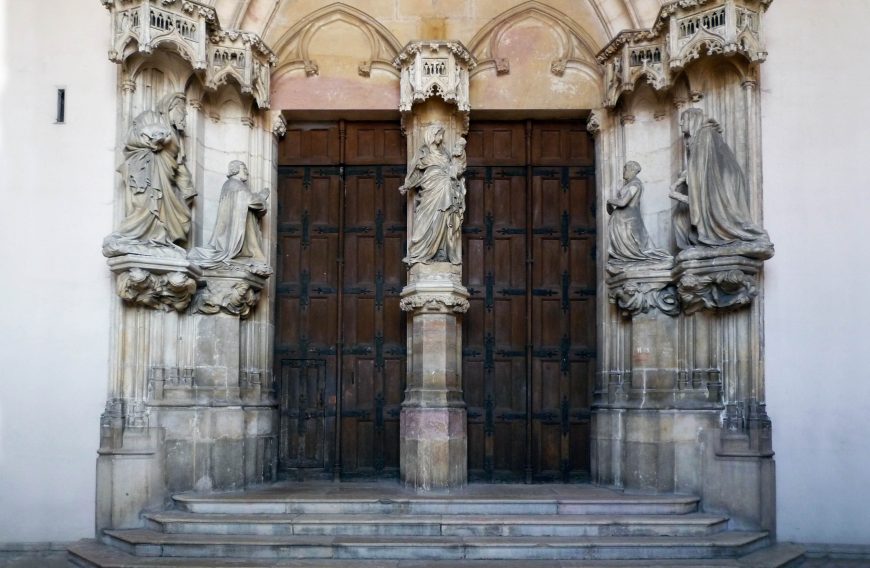
Monastery as monument
The first major project undertaken by a Burgundian duke was the construction of a Carthusian monastery outside Dijon, the Charterhouse of Champmol (1383—c. 1410), eventually served as a mausoleum for Philip the Bold and many of his descendants. The monastery was destroyed during the French Revolution and the site is now a psychiatric hospital, but some monuments from it survive, including the tombs of Philip the Bold and John the Fearless.
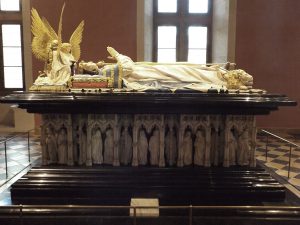
Other monuments include the so-called Well of Moses, which sits above a well in the main cloister of the monastery, and which includes life-size statues of Old Testament prophets below a crucifixion scene (that does not survive). The base with the prophets can still be visited in its original place, as can the portal to the church of the Charterhouse, which still has life-size statues in deep relief of Philip and his wife Margaret praying to the Virgin and Child and supported by donor saints. The Charterhouse of Champmol was intended to secure Philip’s memory and prayers for his soul after he died, but it was also a political monument, serving to remind his family and peers of his wealth and power.
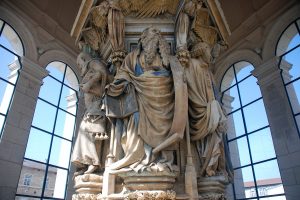
A turn towards Flanders
During the fifteenth century the main site of ducal patronage moved towards the Burgundian territories in the Low Countries. After the assassination of John the Fearless in the presence of the French king in 1419, the third duke, Philip the Good, shifted his attention away from the intrigues of Paris and France, focusing instead on consolidating and expanding his territories in the Netherlands. The most famous artworks made in the court of Philip the Good are the paintings of Jan van Eyck, who Philip retained in his services.
Unfortunately, although we know van Eyck made portraits of Philip and his wife, Isabella of Portugal, there is no surviving work known to be commisssioned by Philip. As the art historian Craig Harbison has suggested, van Eyck might have been most often enlisted by the duke to decorate the courtly environment, either by painting walls or even designing stages and centerpieces for courtly ceremonies such as weddings, funerals, and tournaments. One of the most spectacular types of ceremonies would have been “Joyous Entries”: civic processions in which the duke and his entourage were guided through and around a town lined with pageantry, plays, and tableaux vivants. These events marked a town’s acceptance of their new or current ruler.
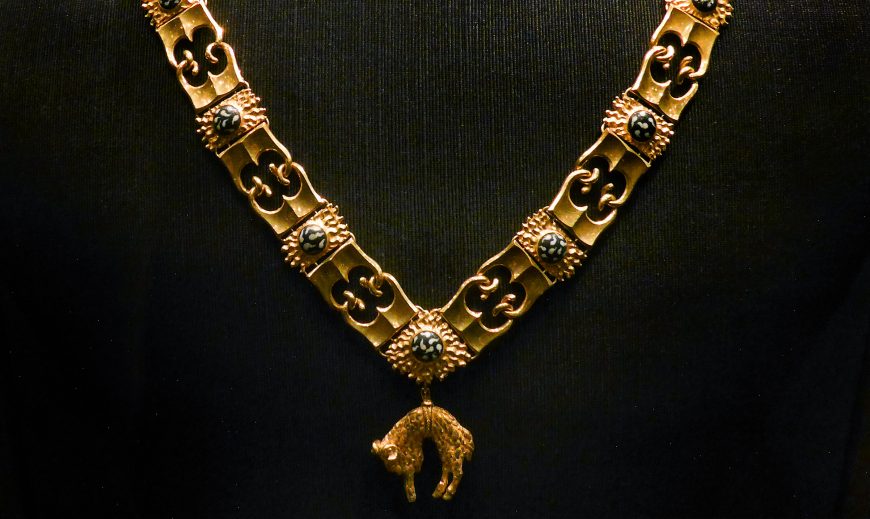
Knights of the Golden Fleece
Philip the Good and Charles the Bold knew their titles (Dukes) were inferior to those of their neighbors (including the Holy Roman Emperor and the King of France), and they both sought crowns from the Holy Roman Emperor. Both also had ambitions to launch crusades against the Ottoman Empire. Even though these later two dukes never went on crusade, they often publicly fashioned themselves as defenders of Christendom. These two rulers therefore favored tapestries and manuscripts that depicted the lives and actions of chivalric heroes, particularly those of Alexander the Great (who conquered the east) and Saint George (a Christian warrior). In 1454, Philip the Good even hosted a grand banquet, the famous “Feast of the Pheasant.” This spectacle was intended to encourage the members of the chivalric order Philip founded, the Knights of the Golden Fleece, to vow to support a crusade. The tables were decorated with statues, and automata (moving statues), and accompanied by music. An elephant (most probably a mechanical one) with an actor dressed as a woman personifying the church was led before the guests, and the Knights had to make their oath before a live pheasant decorated with pearls and a gold necklace (perhaps like that worn by members of the Golden Fleece).
Splendor and ambition
Not everyone in Burgundy shared these chivalric values. The refusal of the Netherlandish towns to fully support and fund Charles’s wars played a major part in his downfall and death at the Battle of Nancy in 1477. This event marked the beginning of the end for the Burgundian state, but its art and ceremony would remain a strong influence on the Habsburg dynasty that subsequently took control over the Burgundian Netherlands. The towns that had provided the crafts, stages, hosts, and audience for the Burgundian courts would also continue to develop their own civic visual and ceremonial cultures. The remarkable splendor and influence of the short-lived Burgundian court stemmed from its feverish and often violent ambition as a wealthy but precarious power in western Europe.
Additional resources:
Burgundian Netherlands: Private Life, and Burgundian Netherlands: Court Life and Patronage from The Metropolitan Museum of Art’s Heilbrunn Timeline of Art History
Art from the Court of Burgundy: The Patronage of Philip the Bold and John the Fearless 1364-1419, Dijon, 2004.
Karl der Kühne (1433-1477). Kunst, Krieg und Hofkultur, Susan Marti, Gabriele Keck, Till H. Borchert (eds.), Bern, 2008.
Wim Blockmans and Walter Prevenier, The Promised Lands: The Low Countries Under Burgundian Rule, 1369-1530, Elizabeth Fackelman and Edward Peters (trans.), Philadelphia, 1999 (This is the shortest and most easily assessable introduction to the period).
Wim Blockmans and Walter Prevenier, The Burgundian Netherlands, Cambridge, 1986.
Sherry C. M. Lindquist, Agency, Visuality and Society and the Charterhouse of Champmol, Aldershot and Burlington, 2008
Biblical Storytelling: Illustrating a Fifteenth-Century Netherlandish Altarpiece
by THE METROPOLITAN MUSEUM OF ART
Video \(\PageIndex{1}\): Video from The Metropolitan Museum of Art.
The Norfolk Triptych and how it was made
by MUSEUM BOIJMANS VAN BEUNINGEN
Video \(\PageIndex{2}\): The Norfolk Triptych, c. 1415-20, oil on panel, 33.1 x 16.35 x 2.85 cm (Museum Boijmans Van Beuningen, Rotterdam).
Video \(\PageIndex{3}\): Layer By Layer, reconstruction by art historian and painting restorer Charlotte Caspers. Produced by Museum Boijmans Van Beuningen, Rotterdam. Video from ARTtube.
Burgundian and adjacent territories
Ruled by a succession of very wealthy Dukes, Burgundy (today parts of France, Germany, Luxembourg, Belgium and the Netherlands) produced some of the most important art of the 15th century.
1400 - 1500 (Northern Renaissance)
Fit for a duke: Broederlam’s Crucifixion Altarpiece
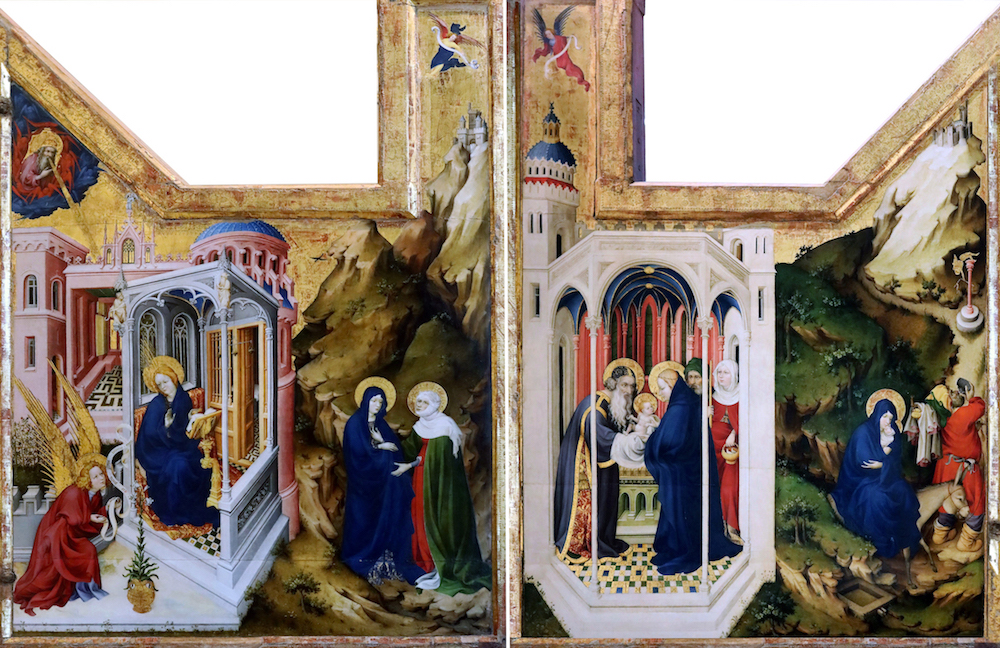
An altarpiece fit for a duke
The two beautiful paintings above, by Melchior Broederlam, were made for the exterior of an altarpiece. Inside was an elaborately carved wooden triptych (below).
Video \(\PageIndex{4}\)
The interior was sculpted by Jacques de Baerze (it was common to combine sculpture and painting in a single altarpiece — see this later example by Rogier van der Weyden). Together, the paintings (by Broederlam) and sculpture (by de Baerze) are known as the Crucifixion Altarpiece.
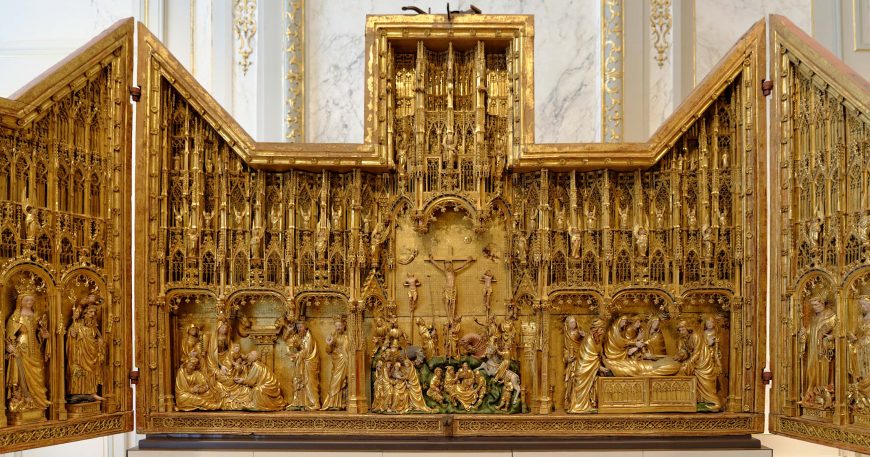
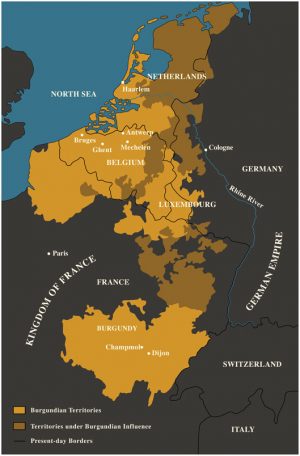
The Crucifixion Altarpiece of Champmol was commissioned by the Duke of Burgundy, Philip the Bold, for the monastery he founded known as the Chartreuse de Champmol (charterhouse/monastery of Champmol), outside of Dijon, France.[1] At the time, Dijon was the capital of the Duchy of Burgundy and the Duke — Philip the Bold — was one of the wealthiest individuals in western Europe.
The richly decorated monastery at Champmol was intended to be the final resting place for the duke and his family and so it housed the tomb carved for him.
The Crucifixion Altarpiece illustrates the life of Christ from the time of his immaculate conception to that of his burial. (While Christ’s conception was immaculate — free from sin — the term Immaculate Conception is usually used to refer to Mary’s conception by her mother, Anne, rendering Mary the suitable mother for the child of God). The story begins on the exterior with Broederlam’s imagery which shows the early life of Christ: the Annunciation, the Visitation, the Presentation in the Temple, and the Flight into Egypt. The narrative continues when the altarpiece is open, beginning with the Adoration of the Magi, then the Crucifixion of Christ (the central and largest of the scenes), and the final representation of Christ’s Entombment.
International Gothic
Broederlam’s two painted panels are an exquisite example of the International Gothic style which developed in the courts of Europe in the 15th century. The International Gothic style often features rich colors, gold, and carefully observed naturalistic details placed within a somewhat illogical space. The figures and architecture of the International Gothic style are commonly given a delicacy and elegance that can be seen here.
The visual delight of Broederlam’s panels
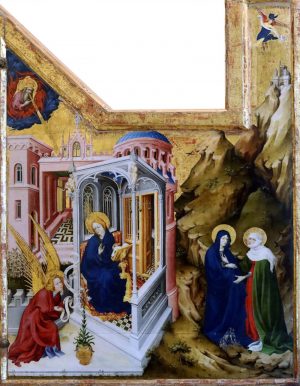
It is safe to say that Broederlam’s two panels are visually complex. Not only did he delight in the International Gothic style of the period, but he also painted with an eye toward naturalism and capturing of minute detail.
Broederlam balanced the pictorial elements in each panel, arranging architecture, landscape, and figures so they are in visual harmony with one another. For example, in both panels, the architectural structures are placed to the left, while the landscape occupies the right side of the composition. As a result, when the panels are side by side, there is an alteration of architecture and landscape.
Similarly, in both panels, the landscape rises to the right with rocky, undulating hills, each surmounted by a walled town. Also in both panels, an angel fills the space in the panel’s rectangular projection. Tying all these elements together is Broederlam’s repeated use of red, blue, and pink, keeping the viewer’s eye moving from one scene to the next and creating continuity amongst the individual events.
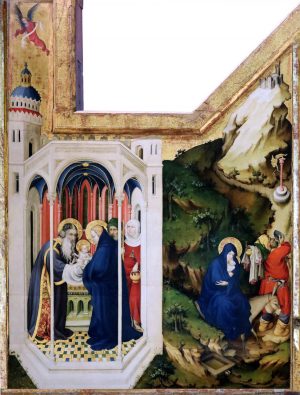
Annunciation and Visitation
At the left side of the left panel, the Annunciation to the Virgin depicts the moment when the angel Gabriel announces to Mary that she will bear the son of God (Luke 1:26-38 and Matthew 1:18-22). The event takes place within an elaborate architectural space. To the right, Mary, dressed in her traditional blue robe, sits in her chamber before a lectern on which we see a book of hours.
However, Mary is not reading the book. instead, she turns her head to the right, as if caught by surprise, and raises her hand in acknowledgement of the angel Gabriel who has just alighted in the left foreground. Gabriel’s banderole pronounces Mary’s new role as mother of the Savior. The Holy Spirit enters Mary through the golden rays that issue from God the Father’s mouth in the upper left corner. Two elements emphasize that the conception of Christ was immaculate (without sin): the vase of white lilies in front of Gabriel is a traditional symbol of the Virgin’s purity as is the walled garden behind Gabriel, known as the hortus conclusus.
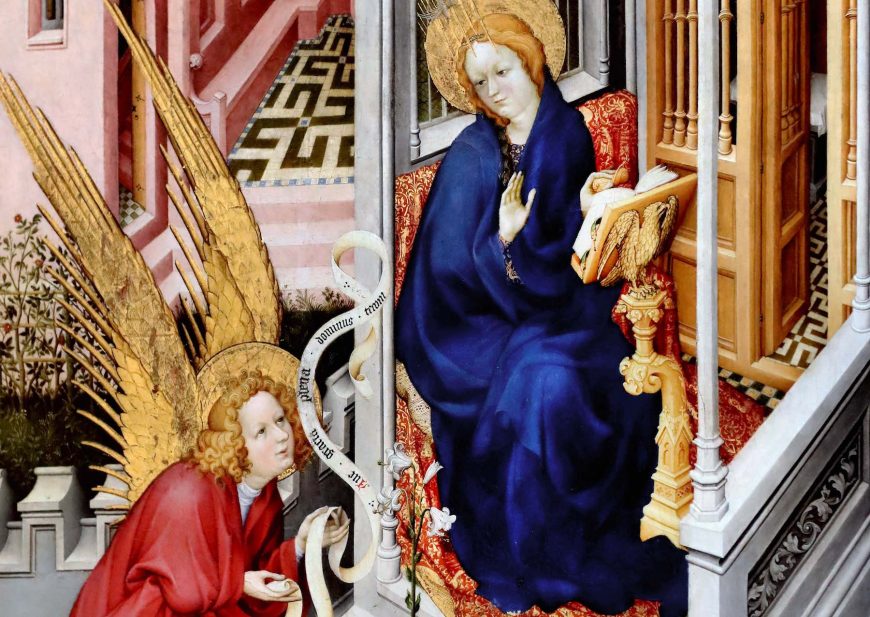
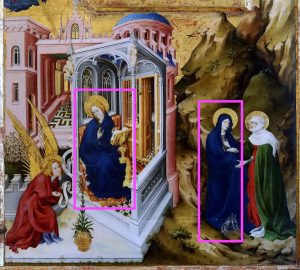
The next event, the Visitation, depicts the moment when the Virgin Mary, again dressed in blue, encounters Elizabeth, the mother of John the Baptist. According to tradition, both women were pregnant when they encountered each other. As John the Baptist recognized Christ as the Savior, he “leapt with joy” in his mother’s womb (Luke 1:42-45). The two women stand before a rocky landscape crowned by a fortified town. Small trees and bushes dot the landscape and a solitary bird flies through the sky, silhouetted against the gold leaf background.
Within this panel, color ties the two events together. Mary is seen twice in her traditional blue garment, the red of Elizabeth’s dress corresponds with that of Gabriel’s robe, and both relate to the red and blue that surround God the Father in the upper left corner.
The Presentation in the Temple and the Flight into Egypt
On the right-side panel, the Presentation in the Temple illustrates the moment when Christ is presented to the priest (Luke 2:22-40). The Virgin Mary presents the Christ Child by holding him above a golden altar inside an elegant temple that combines elements of Romanesque and Gothic architecture.
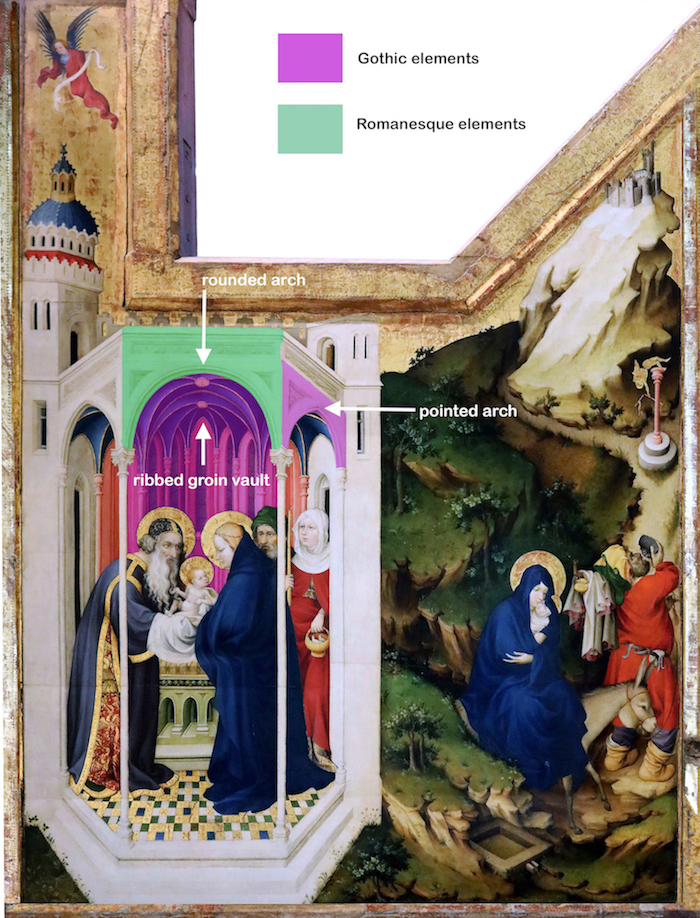
Here, the Romanesque rounded arches contrast with the ribbed groin vault and pointed arch windows, both of which are characteristic of Gothic architecture. Broederlam also used this combination in the Annunciation, where the pink Romanesque church is juxtaposed against the more Gothic structure of the open loggia where the Virgin Mary sits. This pairing of the two styles of architecture has been interpreted as representing the Old and New Testaments. [2] Like the inclusion of a book of hours in the Annunciation scene, the style of the architecture dates to the period of the painting (not to biblical times) — possibly a deliberate choice to make the narratives feel more relevant and relatable.
In both scenes, Broederlam used intuitive perspective, where the buildings recede at opposite angles away from the front of the picture plane and the floors tilt forward, rather than recede back into space. By using this method, Broederlam created relatively three-dimensional spaces for his figures to inhabit. [3]
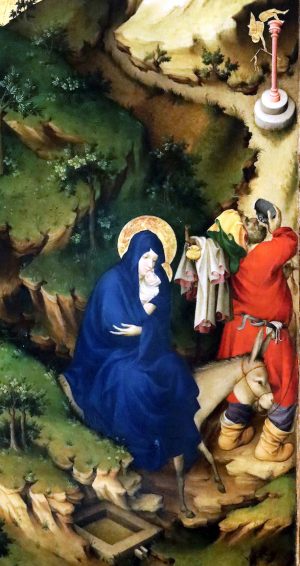
The final event represented on the panels is the Flight into Egypt—a journey undertaken by the Holy Family to flee the murderous intentions of King Herod (Matthew 2:13-23). In this scene, the Virgin and Christ Child sit on the back of a donkey as they undertake their arduous journey. The Virgin’s blue mantle is wrapped around the young infant in a gesture of motherly protection.
Leading the way is Joseph, Mary’s husband, and as if to emphasize the difficulty of the journey, Joseph drinks heavily from a water bag. The rocky path on which they are about to embark leads up to a fortified city. Halfway up the path, a golden idol falls from a pink column, signaling the transition to the new Christian era brought about by the birth of Christ.
The eternal resting place of the duke
Filled with brilliant color, elegant figures, and charming detail, Melchior Broederlam’s panels for the Crucifixion Altarpiece are visual delights in the purest sense. The style of these painted panels matches that of the carved, gilded interior and together they created a stylistically unified narrative of the life of Christ. The devotional content and lavish representation are perfectly suited for the Duke and his eternal resting place in Dijon.
Notes
[1] Charles Minott, “The Meaning of the Baerze-Broederlam Altarpiece,” in A Tribute to Robert A. Koch. Studies in the Northern Renaissance (Princeton, NJ: Princeton University Press, 1994), p. 132.
[2] James Snyder, Northern Renaissance Art. Painting, Sculpture, the Graphic Arts from 1350 to 1575 (Upper Saddle River, NJ: Prentice Hall, Inc., 2005), p. 54; Minott, p. 138.
[3] Anne Hagopian van Buren, “Broederlam, Melchior.” Grove Art Online. Oxford Art Online. Oxford University Press, accessed September 28, 2017. Comparison has long been made between Broederlam’s composition and that of the Italian artist Ambrogio Lorenzetti, who painted the same subject for the Cathedral in Siena in 1342.
Additional resources:
Original Corpus of Christ from the Crucifixion Altarpiece, removed during the French Revolution (Art Institute of Chicago)
Hagopian van Buren, Anne. “Broederlam, Melchior.” Grove Art Online. Oxford Art Online. Oxford University Press.
Minott, Charles. “The Meaning of the Baerze-Broederlam Altarpiece.” In A Tribute to Robert A. Koch. Studies in the Northern Renaissance. Princeton, NJ: Princeton University Press, 1994, pp. 131-141.
Snyder, James. Northern Renaissance Art. Painting, Sculpture, the Graphic Arts from 1350 to 1575. Upper Saddle River, NJ: Prentice Hall, Inc., 2005.
Claus Sluter and Claus de Werve
Claus Sluter (with Claus de Werwe), The Well of Moses
by DR. BETH HARRIS and DR. STEVEN ZUCKER
This work is located on the grounds of the former Chartreuse de Champmol, a Carthusian monastery in Dijon, France, established by Philip the Bold, Duke of Burgundy. The prophets depicted include: Moses, David, Jeremiah, Zachariah, Daniel, and Isaiah.
Smarthistory images for teaching and learning:
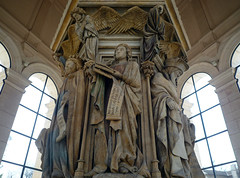
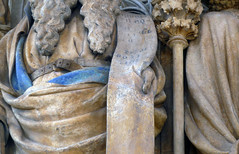
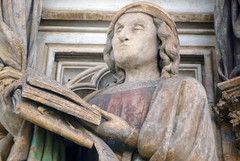
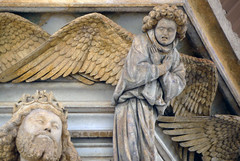
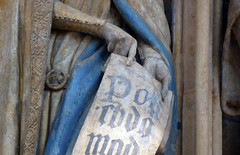

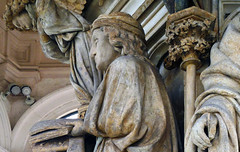

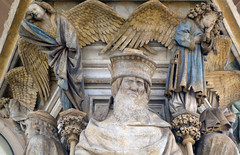
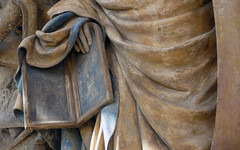
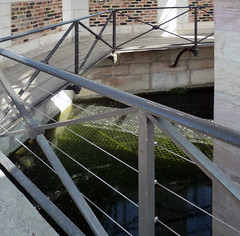
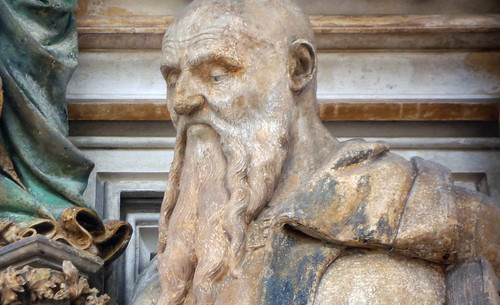

Claus Sluter (with Claus de Werve), Mourners
by DR. BETH HARRIS and DR. STEVEN ZUCKER
Video \(\PageIndex{6}\): Claus Sluter (with Claus de Werve), Mourners, Tomb of Philip the Bold, Duke of Burgundy, 1410 (Museum of Fine Arts, Dijon)
Smarthistory images for teaching and learning:

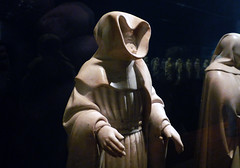
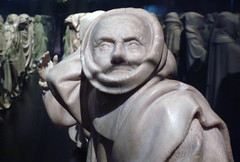
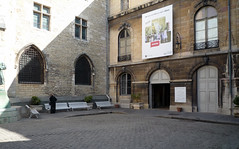
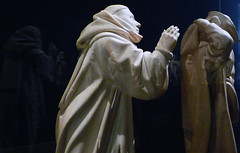
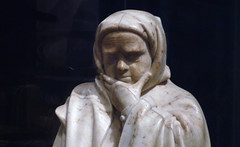




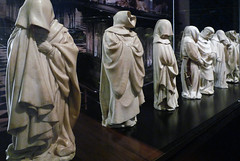
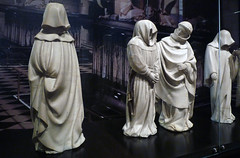
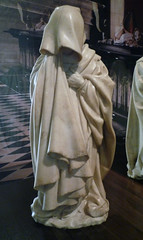
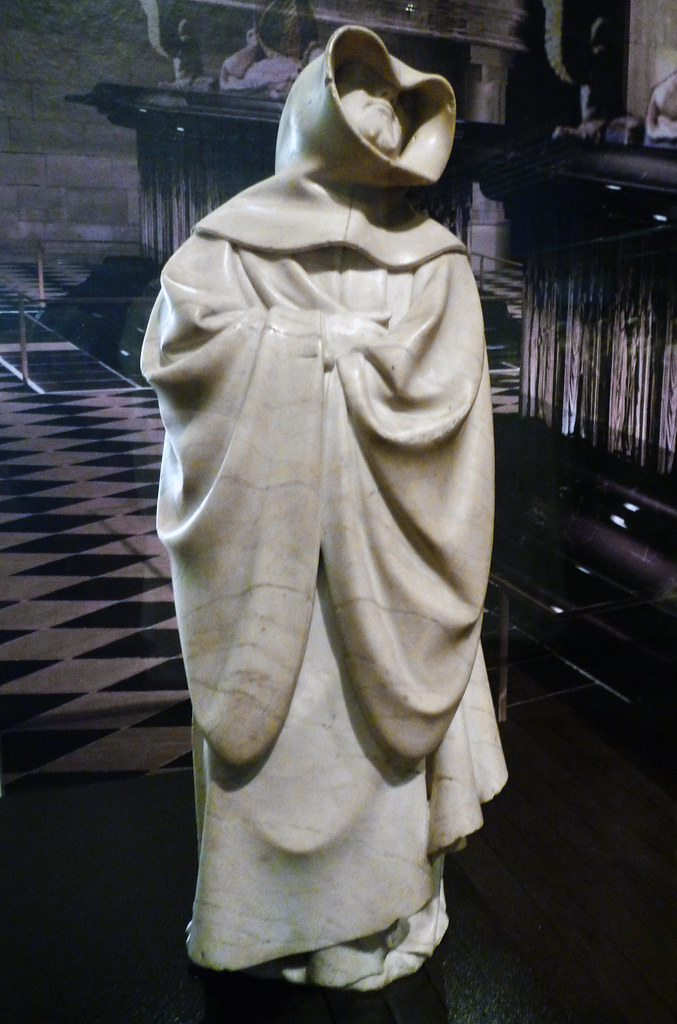
Herman, Paul, and Jean de Limbourg
Limbourg brothers, Très Riches Heures du Duc de Berry

Some background: the Limbourg Brothers
Known collectively as the Limbourg brothers, Paul, Jean and Herman de Limbourg were all highly skilled miniature painters active at the end of the 14th century and the beginning of 15th century. Together, they created some of the most beautiful illuminated books of the Late Gothic period.
The brothers hailed from the city of Nijmegen, currently part of the Netherlands. They came from an artistic family—their father was a wood sculptor, and their maternal uncle was an established painter who worked for Philip the Bold, Duke of Burgundy. From the mid-1400s until the mid-1800s, the brothers’ legacy was lost in the mists of time until a dedicated bibliophile, Henri d’Orleans, duke of Amale, acquired one of their works, the Très Riches Heures, in 1856. This set off a flurry of study around the manuscript and its creators.
Though the exact birth years of the brothers are not known, it is believed that all three died in a wave of plague that hit Europe in 1416. All were likely under 30 years of age, which, though young to the contemporary mind, was a pretty standard life expectancy in the middle ages. Regardless, during their relatively brief lives, they were able to produce a number of complex and remarkable works.
The artistic lives of these brothers (at least Jean and Herman), began when they were sent at a young age to apprentice at a Parisian goldsmith. Apprenticeships—typical for craftsman in the middle ages—generally lasted around seven years. However, these were turbulent times and after only two years the boys were sent back home when a plague epidemic hit Paris in 1399. En route to return home to Nijmegen, they were captured in Brussels, which was experiencing conflict during this period. Jean and Herman were held in a prison for ransom. As their newly widowed mother did not have the funds to pay the ransom, the boys were held for approximately six months. Eventually Philip the Bold, Duke of Burgundy—patron of their uncle Jean—paid half the ransom. Painters and goldsmiths from their hometown contributed the other half. Some scholars believe that upon their release the young men traveled to Italy (though this is highly speculative).
A Moralized Bible
After their release, Philip the Bold commissioned the three brothers to create a miniature bible over a four-year period. Scholars assume this is the Bible Moralisée (Moralized Bible) which currently resides in the Bibliothèque National de France (Ms Fr166)—though this is a matter of some debate.
Bible moralisée, or moralized bibles, are a small group of illustrated bibles that were made in thirteenth-century France and Spain. These books are among the most expensive medieval manuscripts ever made because they contain an unusually large number of illustrations. They books were generally commissioned by members of royal families, as no one else would have been able to afford such luxury. Bible moralisée contain two texts: the biblical text and the commentary text, which is sometimes called a gloss. These commentary texts interpreted the biblical text for the thirteenth century reader. Commentary authors often created comparisons between people and events in the biblical world and people and events in the medieval world.
Their patron: the Duke of Berry
When Philip the Bold died in 1404, the future was uncertain for both the brothers and their uncle, but eventually Philip’s brother—Jean de France, duc de Berry (John, Duke of Berry)—took on the still teenaged boys. They would go on to create the Belles Heures de Jean de France, Duc de Berry, or the “Beautiful Hours of the Duke of Berry,” for him. The story of the Limbourg Brothers is integrally tied to the wealthy and powerful Duke of Berry—a major patron of the arts and avid collector, and the manuscripts they produced for him.
The Belles Heures
The Belles Heures is a Book of Hours— a very popular book to possess during the late medieval period. A Book of Hours is essentially a prayer book (with prayers and readings for set times throughout a day), and it they typically featured the “Hours of the Virgin” (a set of psalms with lessons and prayers), a calendar, a standard series of readings from the Gospels, the Office for the Dead, the Penitential Psalms, and hymns (or some variation thereof). They were miniature works of art made for private use, and generally contained a number of intricate illuminations painstakingly created on vellum (calfskin). A book of hours was for personal, devotional use—it was not an official liturgical volume. Typically, these books of hours were quite petite.
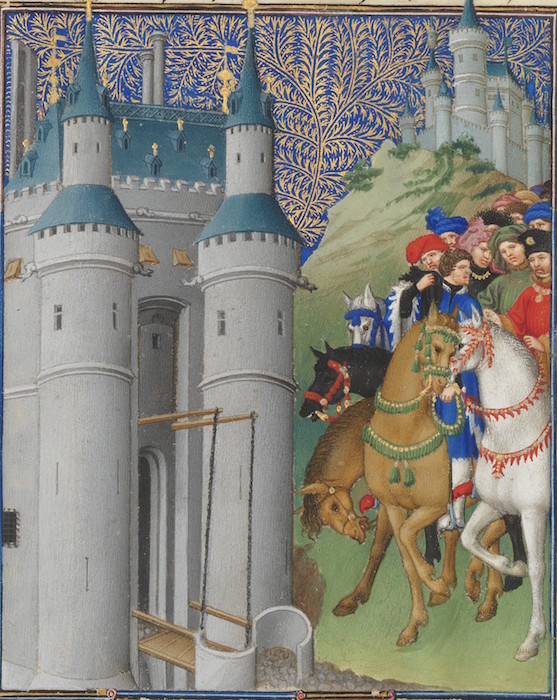
The Limbourg brothers finished work on the “Belles Heures” around 1409—this was to be their only complete work. The Duke of Berry then commissioned another devotional book in 1411 or 1412, which would become the Très Riches Heures du Duc de Berry (The Very Rich Hours of the Duke of Berry)—probably the best-known example of Gothic illumination.
Though the two manuscripts (the Belles Heures and the Très Riches Heures) were created in fairly close succession, stylistic differences are apparent, and it seems clear that at least one of the brothers (likely Paul as he was the eldest and the master of the workshop), spent some time in Italy studying Renaissance masters such as Pietro Lorenzetti. Whatever the case, there is a change in style—particularly in the way landscapes are depicted and in the decorative borders. This, along with its fine, extant condition, is part of what makes the Très Riches Heures one of the finest examples of Gothic illumination and the International Gothic Style.
The Tres Riches Heures
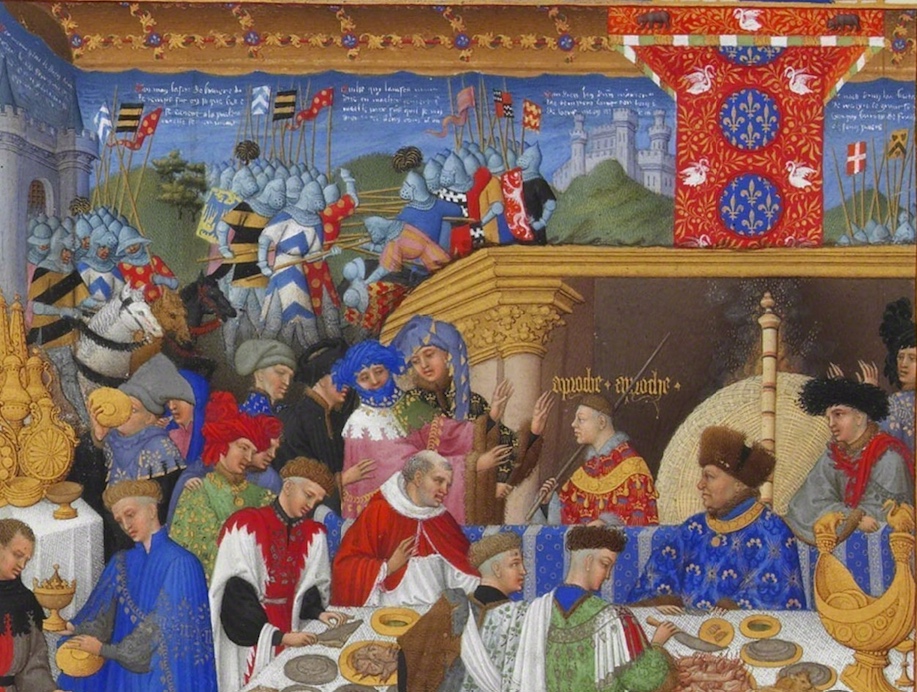
In the Très Riches Heures, there are a number of full-page images—including calendar pages. The calendar pages often show agricultural scenes where happy peasants till the fields and harvest. In the background are castles and landscapes that were specific holdings of the Duke of Berry. Likewise we also see the inside the palace. For example, in January (in full at the top of the page, and detail above) we see an image of the Duke himself, sitting at the head of the table while all around presents are exchanged. Likely, the Limbourgs themselves would have been part of this ritual exchange—the man in the mid-ground with the gray floppy cap may be a self-portrait of Paul. The table, resplendent in damask and laden with expensive goods, represents the wealth and taste of the Duke. A variety of heraldic motifs relating to the Duke can also be found, such as the gold fleur-de-lys (in the blue circles above the Duke for example). In the background we see tapestries with a scene of knights emerging from a castle ready to go into battle.

Meanwhile, the February page takes us outside into the frigid winter air. Wan light falls across a snow covered landscape where in the background we see a town blanketed in snow, along with a peasant and a donkey gamely taking the road towards it. In the middle ground we see another peasant diligently chopping wood, while another hurries towards shelter. In the foreground we see the farm as well peasants warming themselves in a small wooden house. he tunics of both the men are pulled so high, assumedly in an effort to warm their chilled legs, that their nether regions are exposed—something that might strike modern viewers as incongruous to a religious book. At least the lady of the house decorously only warms her ankles! However, nudity in medieval manuscripts, while not prolific, was also not unusual. In fact, there are several other examples that can be found in the “Très Riches Heures.”

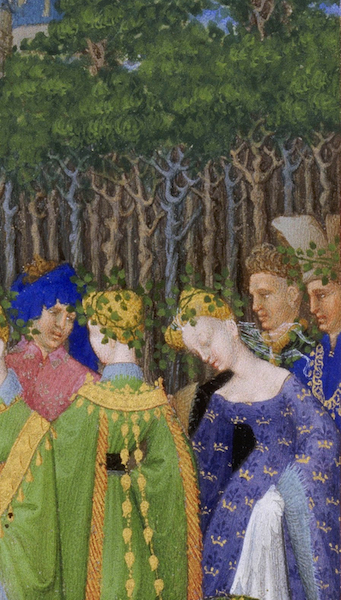
Something else that might strike the modern viewer as curious is the incorporation of the zodiac into this book of hours. For every calendar page, the corresponding astrological sign is shown at the top of the page in a lunette or tympanum. This is in part because the stars were integrally tied to the agricultural calendar. Also, medieval medical practioners believed that people’s health issues were related to what constellation they were born under. Even the church calendar used the Zodiac to calculate feast days. For the month of May (below), we see the astrological signs of the bull and the twins, accompanying the chariot of the sun.
The International Gothic style
The International Gothic style emphasized decorative patterns. This is obvious on the clothing worn by the figures, but even natural forms—like trees—create decorative patterns. Gold leaf, always popular in manuscripts, was also used in abundance. Figures are elegant and elongated. These images are also highly detailed and show an abundant interest in accurately portraying plants and animals. Though the Très Riches Heures, is incomplete, it remains a shining example of the International Gothic style, along with such art works as The Annunciation by Simone Martini and Gentile Fabriano’s Adoration of the Magi.
Video \(\PageIndex{7}\)
Herman, Paul, and Jean de Limbourg, The Belles Heures of Jean de France, Duc de Berry
by THE METROPOLITAN MUSEUM OF ART
Video \(\PageIndex{8}\): Herman, Paul, and Jean de Limbourg, The Belles Heures of Jean de France, Duc de Berry, 1405–1408/1409, tempera, gold, and ink on vellum, 9 3/8 x 13 7/16″ / 23.8 x 34.1 cm (The Metropolitan Museum of Art). Video from The Metropolitan Museum of Art.
Campin and his workshop
Robert Campin, Christ and the Virgin
by DR. STEVEN ZUCKER and DR. BETH HARRIS
Video \(\PageIndex{9}\): Robert Campin (also called the Master of Flémalle), Christ and the Virgin, c. 1430-35, oil and gold on panel, 11-1/4 x 17-15/16 inches (28.6 x 45.6 cm) (Philadelphia Museum of Art)
Smarthistory images for teaching and learning:
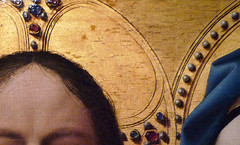
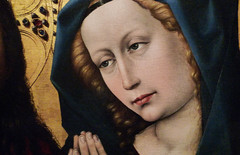
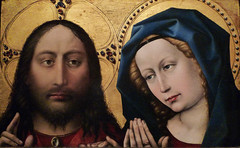
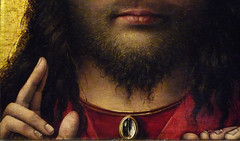
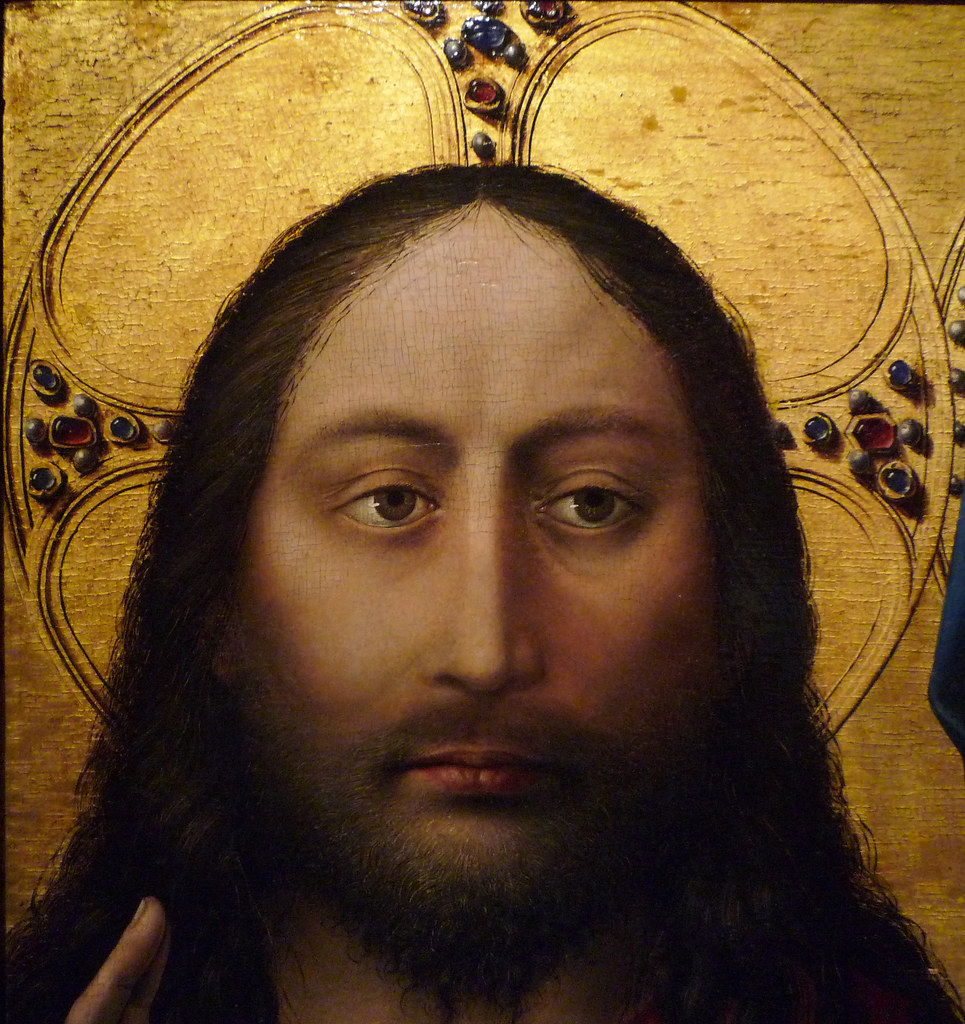
Workshop of Robert Campin, Annunciation Triptych (Merode Altarpiece)
by DR. BETH HARRIS and DR. STEVEN ZUCKER
Video \(\PageIndex{10}\): Workshop of Robert Campin, Annunciation Triptych (Merode Altarpiece), 1425-28, tempera and oil on panel (Metropolitan Museum of Art, New York)
Additional resources:
This painting at The Metropolitan Museum of Art
More on this painting from Dr. Allen Farber
Smarthistory images for teaching and learning:
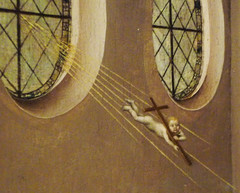
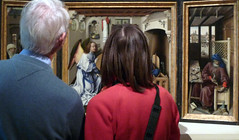

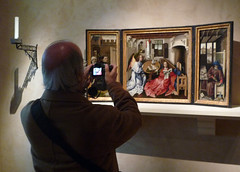

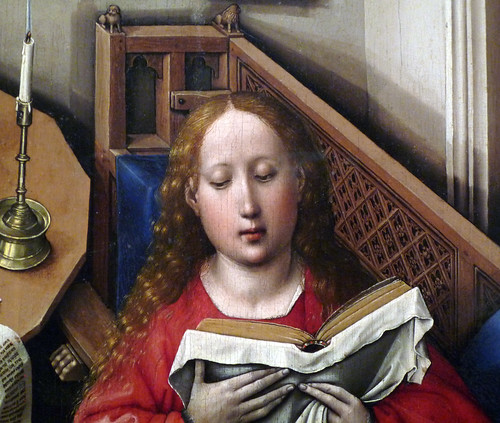

Jan van Eyck
Jan Van Eyck, The Ghent Altarpiece
Video \(\PageIndex{11}\): Jan van Eyck, The Ghent Altarpiece (closed), completed 1432, oil on wood, 11’ 5” x 7’ 6” (Saint Bavo Cathedral, Ghent, Belgium)
Video \(\PageIndex{12}\): Jan van Eyck, The Ghent Altarpiece (open), completed 1432, oil on wood, 11’ 5” x 7’ 6” (Saint Bavo Cathedral, Ghent, Belgium)

“All art constantly aspires to the condition of music”
– Walter Pater
A troubled past
When he wrote that statement, I doubt that Walter Pater had in mind the veritable rock opera that is the Ghent Altarpiece, now housed in the Cathedral of St. Bavo, Ghent (in present-day Belgium). From its singing, costumed, organ-pumping chorister angels to its gospel-choir legions of saints, soldiers, prophets and martyrs, to its central panel depicting the Adoration of the Mystic Lamb—is there any other fifteenth-century altarpiece that even comes close in spirit to the 1970s theatrical excesses of rock operas like Jesus Christ Superstar?


Since that time, the altarpiece has seldom failed to be in some process of constant condition monitoring (as T.S. Eliot would say “like a patient etherized upon a table”) or some kind of reconstruction or conservation—a kind of cultural-historical exercise in trying to perfect the past. The latest campaign of study, restoration and renewal has gone on since 2009, much of it carried out in front of the crowds at Saint Bavo’s Cathedral.
Video \(\PageIndex{13}\)
Astonishingly, given its many trials and tribulations, the altarpiece has weathered well. Only one of the original 12 panels (8 of which are part of the hinged shutter apparatus, and therefore painted on both sides), has been lost. In 1934 the panels depicting St. John the Baptist, and another depicting the Just Judges were stolen from the church. The John the Baptist panel was recovered. The Just Judges panel (on the lower left when the altarpiece is open—see image at the top of the page) was replaced with a modern copy during the 1945 restoration. The other panels have all survived, although there is some lingering disagreement about whether they are now reassembled in their original configuration, given the many times the altarpiece has been taken apart.

A pixilated present
The Getty Foundation in Los Angeles has funded the recent campaign to conserve the Ghent Altarpiece, an effort being led by Belgium’s Royal Institute for Cultural Heritage. A painstaking photographic enlargement is captured in 100 million pixels on the “Closer to Van Eyck” website. There, one can probe the impenetrably gorgeous enamel-like surface of van Eyck’s greatest masterpiece, and gaze astonished at his virtuosic accomplishments.
A moveable feast
Video \(\PageIndex{14}\)
The altarpiece itself is a visual “moveable feast,” made up of 12 panels that fold against themselves (see the video above). It is like frozen theatre, and when open, reveals a spiritual guidebook to divine revelation.
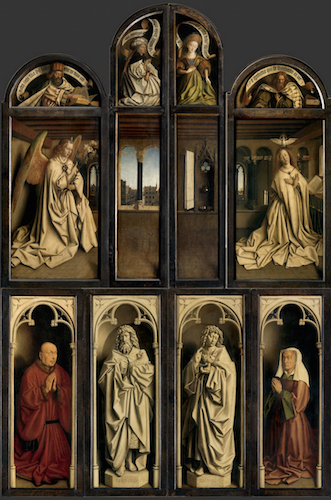
In its basic configuration, the rather austere, largely monochromatic outer panels (above)—which show the kneeling patrons and statues of prophets and glimpses into orderly rooms; are grounded in the material and sensible terrestrial world, in which Gabriel appears to Mary at the moment of the Annunciation. But when the altarpiece is opened, we travel, accompanied by prophets on foot and princes on horseback, saints and martyrs and more angels, to the brilliantly-colored heart of the scene depicting the Adoration of the Mystic Lamb (below). It is as if the makers of the Wizard of Oz derived their inspiration for a black-and-white Kansas and a technicolor Oz, from Ghent.

Byzantine influences
The Adoration of the Mystic Lamb (above) is presided over by the figure of God (the bearded Jesus with crown and scepter, below).* This figure can also be read as Christ Pantokrator (one of the many names for God in the Jewish tradition and, in the Bible, an appellation used only by John the Baptist to describe God), flanked by separate panels of John the Baptist to the right and the Virgin Mary to the left (below). The combination of these three figures reminds us of a Byzantine image type—the Deësis (from the Greek, “prayer”), which shows the intercession of the Virgin Mary and St. John the Baptist for the salvation of our souls, the heavenly interview at the moment of the Last Judgement (an example of a Byzantine Deësis, Byzantine art refers to art from the Byzantine or Eastern Roman empire).

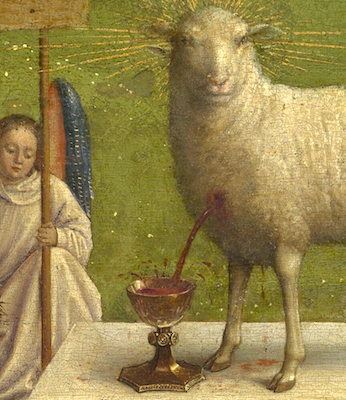
In The Adoration of the Mystic Lamb (left detail), the sacrifice of the lamb, symbol of Christ’s slaughter for our salvation, is similarly Byzantine in origin.
The inner panels are painted in the bold and dynamic naturalistic style for which the artist Jan van Eyck is justifiably famous. In all of its positions, the Ghent Altarpiece is a vision of the visionary. It alludes not only to sight but to sound—musical angels accompanying the elaborate orchestration of the whole. Its appeal to the senses threatens to overwhelm the intellectual apprehension of its content.
The artists
According to an inscription, written on two silver strips mounted on the rear of the two donor panels, and only discovered in 1823, the altarpiece was painted by the brothers Jan and Hubert van Eyck:
The painter Hubert van Eyck, than whom none was greater, began this work. Jan [his brother], second in art, completed it at the request of Joos [Jodocus] Vijd on the sixth of May [1432]. He begs you by means of this verse to take care of what came into being.

Because Jan van Eyck is seen as the far more famous of the two brothers, the reference to Jan as “second in art” has raised a few eyebrows among art historians, eager to assign the lion’s share of the work to young Jan. My own undergraduate professor postulated that what the inscription means is that Hubert was responsible for the actual construction of the altarpiece, which was later largely painted by Jan—a not unusual sequence of events in a fifteenth-century workshop (building polyptych, or many-paneled, altarpieces required construction knowledge, and painting them required an entirely different expertise). Hubert died in 1426, and the altarpiece was finished in 1432, so Jan probably took over the contract Hubert signed with the patron of the work, Judocos Vijd (sometimes spelled “Vijdt”), which also would have made Jan literally “second in art.”

We know Jan to have been an exquisite painter of miniatures who worked for the Dukes of Burgundy, and there are many aspects of the work here consistent with the detailed work of a manuscript illuminator, but there are also some important differences, particularly in scale. The relatively large size of the panels pushed Jan to new heights of virtuosity as a master of light; directional light, saturation, the softest scale of illuminations in the gradation of shadow, the construction of space through light and shade, symphonies of reflection and refraction alive in a world of textured surfaces—literally, the light of the world. Here, for the first time on such a scale, is a picture of the completely natural world saturated by the light of God—the perfect intermingling of divine illumination with the created world—and all described in paint. Van Eyck creates a world within the painting as substantial and real as the world outside the painting. Say what you will about Brunelleschi and Masaccio and linear perspective in Florence, without the subtlety of oil paint, their works look like mathematical equations beside the painted world of the Ghent Altarpiece.
The patrons

Like most Renaissance patrons, Jodocus Vijd was a wealthy merchant who sought to expiate the sin of being too fond of money by spending some of it on creating a monument to God. An influential citizen of Ghent, Vijd commissioned the altarpiece for the Church dedicated to St. John the Baptist (now the Cathedral of St. Bavo) in his home city as a means of saving his soul while simultaneously celebrating his wealth. Vijd was warden of the Church of St. John and assistant Burgomeister of Ghent, and he had a rich aristocratic wife, so he had plenty of money to commission the van Eyck brothers. It is uncertain the extent to which he influenced the iconography of the overall work, but he obviously spared no expense.
The distinctive faces of Jodocus Vijd and Elizabeth Borluut (the husband and wife patrons) are each shown in three-quarter view (left and below). They kneel in the traditional donor positions, with their hands clasped in prayer, facing each other and gazing vaguely toward the central panels. Undoubtedly, contemporaries would have recognized them taking pride of place in such an important civic church, and although the immediacy of their presence would fade with time, their identities as the donors of the work remain intact.
The altarpiece, closed

It is best to start in the smallest and most constricted stage of the altarpiece in its closed position. The kneeling donors are depicted on the outer extremes, separated by simulated statues of two standing saints painted in grisaille (shades of grey)—St. John the Baptist and St. John the Evangelist (above).


In the register above is a depiction of the Annunciation—this is the moment when the archangel Gabriel announces to Mary that she will be the mother of Christ (above). Figures of the angel and Mary are found on the outer edges of the panels. The Holy Spirit hovers over Mary. The two contiguous scenes between them are pure genre scenes (scenes of everyday life). Beside Gabriel, a window opens onto a view of buildings in Ghent (left), beside the Virgin, a recessed niche holds a silver tray, a small hanging silver pitcher and a linen towel neatly hanging from a rack (below). These items are consistent with iconography of the period that uses domestic objects as a means of expressing the purity of the Virgin. We are drawn most deeply into the center of the altarpiece (achieved without mathematically calculated perspective—you can tell because the floor appears to tilt upward), toward the mystery within.

At the top of the Gabriel panel, beneath a shallow rounded arch, is the Old Testament prophet Zacharias, father of John the Baptist; and above the Virgin, we see the Old Testament prophet Micah, who predicted the birth of the Messiah in Bethlehem. The two central panels in this upper register depict the Erythraean and Cumaean Sibyls (sibyls are female figures from ancient Greece and Rome who prophesied the future). These four figures are all messengers of the incarnation and sacrifice of Christ (Michelangelo painted these prophets and sibyls in the Sistine Chapel, and more).

The altarpiece, open


Opened, the altarpiece is divided into two horizontal registers. The Deësis (the Virgin Mary, Christ/God,* and St. John the Baptist) panels are flanked on either side by choirs of heavenly angels and, on the outermost panels at each side, Adam and Eve. God’s first human creatures are therefore the parenthetical figures of this upper register and the figures that necessitate the salvation scene below). Their literal marginalization—at the edges of the altarpiece—is indicative of their state of sin. Eve holds the forbidden fruit and covers her genitals. Opposite her, Adam assumes the classical pose of the so-called “modest Venus,” one arm across his chest, the other covering his genitals (a rather peculiar pose for a male figure to assume).
Adam and Eve’s sin in the garden of Eden (the Fall of Man) is, of course, the reason for all that occurs below in the panel known as the Adoration of the Mystic Lamb—the full salvation play, complete with sacrificial lamb, a symbolic representation of Christ (from Gospel of John: “The next day John saw Jesus coming toward him, and said, ‘Behold! The Lamb of God who takes away the sin of the world!'”—John 1:29).
From the outer edges of the lower panels, crowds converge towards the altar in the center, presenting a unified field across the five panels, overcoming the Gothic division of the frame. From the left come figures known as the Just Judges and the Soldiers of Christ, on horseback, arrayed in glittering armor and armed with swords of Justice, followed by the Judges wearing opulent and various finery.

From the right come the saints and the prophets, chief among them the giant (and apocryphal) St. Christopher (below), the male saints suitably dressed in simple tunics and robes in sober earth tones. These crowds approach the central panel. Where are they all going? They’re going to witness the sacrifice of the Mystic Lamb.

The Adoration of the Mystic Lamb


The key panel of the altarpiece, the Adoration of the Mystic Lamb (detail above), depicts a large meadow, dotted with flowers, at the center of which are two key structures—in the foreground is a lovely octagonal stone fountain, with a tall central pedestal from which spring multiple cascades of water. In the background, on a direct axis with the fountain, is an altar with a lamb standing on it. The head of the strangely alert lamb is surrounded by a glowing nimbus (a halo, here depicted as golden rays). In the sky above, the dove of the Holy Spirit descends in its own pulsating nimbus of light from which radiate long, golden spires that touch the angels and the ground. Behind the altar, in the distance, are trees and one tall tower, punctuated by windows (left). Still further back on the blue horizon are distant mountains; the setting is a paradisaical landscape for the re-enactment of the sacrifice of Christ. What is the relationship between the altar, the sacrifice of the lamb, and the foreground fountain?

The Mystic Lamb is the Lamb of God—the sacrificial lamb—a symbol of Christ and Christ’s death. The lamb on the altar is equivalent to the crucifixion of Christ, made explicit by the juxtaposition of the lamb with the cross held by the angel. Other angels behind the altar hold the instruments of the Passion (the events surrounding Christ’s death): the column to which Christ was tied during the flagellation, the sponge on a stick used to touch his lips with vinegar (increasing his thirst), the nails and the lance that pierced his flesh. Angels in front of the altar swing censors containing incense (below). This is also a reference to the sacrament of the Eucharist, where the bread and wine, offered by the priest during Mass, become the body and blood of Christ.

The Lamb bleeds from a wound in his side, and this stream of blood flows directly into a chalice set on the altar cloth (the full inscription on the altar cloth reads, “Ecce Agnus Dei, qui tollis peccata mundi, miserere nobis,” which translates, “Here is the Lamb of God, who takes away the sins of the world”). The flowing of the blood, visually linked to the spouts of water in the foreground fountain, is probably an allusion to Christ as the “living water” of God.
The fountain is therefore the Fountain of Life—a reference to the promise of eternal life made possible by Christ’s sacrifice. This reference to Christ as the “living water” occurs in the Gospel of John. In that story, Christ meets the Woman of Samaria at the well. When the woman questions Christ’s presence there, “Jesus answered and said unto her, If thou knewest the gift of God, and who it is that saith to thee, Give me to drink; thou wouldest have asked of him, and he would have given thee living water.” (John 4:14).

Inscribed on the fountain, in Latin (below), we see a verse from the Book of Revelation, “Then the angel showed me the river of the water of life, clear as crystal, proceeding from the throne of God and of the Lamb.” (Revelation, 22:1). In the symbolic context of the Lamb, the fountain is therefore the wellspring of eternal life and salvation.

Clustered around the fountain are yet more distinct processional groups worshiping the Lamb. These are commonly identified as patriarchs and prophets from the Old Testament and male and female saints and church figures. If you’re wondering what the Old Testament figures are doing in paradise, in the Byzantine tradition, Christ’s death is followed by his Harrowing of Hell (which takes place during the three days before his resurrection). In this episode (while “dead” to the world), Christ breaks open the doors of Hell. He frees and saves pagan writers (like Homer), prophets of the Old Testament (like Moses), and Adam and Eve—all of whose deaths preceded Christ’s birth and who could not otherwise have experienced eternal salvation through his resurrection.

Together, these scenes, which relate to the Gospel of John and the Book of Revelation, invite the viewer to share in the promise of salvation. These days, of course, we are invited to contemplate the altarpiece itself as a material survivor of time, war, reparation and restoration, and the painting has its own cult of dedicatees who worship it as an iconic work of art.
The sum of its parts (some thoughts on van Eyck’s sources and influences)
The iconography of the Ghent Altarpiece may be read in a myriad of ways, and it would be impossible to do justice to all of them here. But there is one more message that is, I think, important. The central panels of the open position may be read downward vertically; through the seated Christ/God* figure, to the descent of the dove of the Holy Spirit, to the Lamb on the altar. The symbolism of the Trinity (in Christian theology, God, the Holy Spirit and Christ are manifestations of one being) is important because it was a doctrine that was frequently challenged in the western Church. Again, the Gospel of John is often cited as most strongly defending and defining the divine nature of Jesus, and supporting the Trinitarian belief that the Holy Spirit shares the same being as Jesus and God. In the thirteenth century, a philosopher named Henry of Ghent, from Ghent of course, waded into the Trinitarian question through his work on the metaphysics of Being, and his work on the Metaphysics of the Trinity. It was not unusual for works of fifteenth-century art to engage with contemporary theological and philosophical debate.

The iconography of the Ghent Altarpiece suggests that the artists (or patron) drew on very particular sources, perhaps even Henry of Ghent, although this is merely speculation. Certainly, aspects of the iconography of the Ghent Altarpiece are peculiarly indebted to Byzantine art, which we know Jan van Eyck had studied. His genius was in the commingling of the timelessly iconic with the naturalistic play of light across the temporal textures of the world, transforming the material into the miraculous.
*The central figure of the top register of the open altarpiece has been identified as both Christ and God the Father. Some scholars has asserted that this ambiguity may have been purposeful.
Additional resources:
Getty Foundation Ghent Altarpiece initiative
A Smarthistory video on a Byzantine Deësis mosaic from Hagia Sophia
The Ghent Altarpiece from the Web Gallery of Art
The Ghent Altarpiece from The Metropolitan Museum of Art’s Heilbrunn Timeline of Art History
Smarthistory images for teaching and learning:



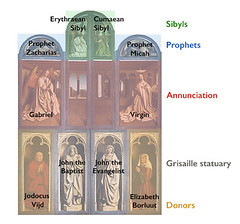

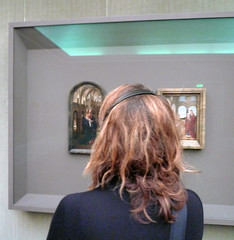
Jan van Eyck, Portrait of a Man in a Red Turban (Self-Portrait?)
by DR. STEVEN ZUCKER and DR. BETH HARRIS
Video \(\PageIndex{15}\): Jan van Eyck, Portrait of a Man in a Red Turban (Self-Portrait?), 1433, oil on oak panel, 26 x 19 cm (The National Gallery, London)
Jan van Eyck, The Madonna in the Church
by DR. STEVEN ZUCKER and DR. BETH HARRIS
Video \(\PageIndex{16}\): Jan van Eyck, The Madonna in the Church, c. 1438, oil on oak, 31 x 14 cm (Gemäldegalerie, Staatliche Museen zu Berlin)
Smarthistory images for teaching and learning:

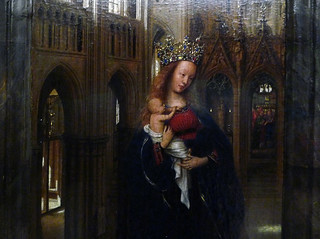

Jan Van Eyck, The Arnolfini Portrait
by DR. BETH HARRIS and DR. STEVEN ZUCKER
Video \(\PageIndex{17}\): Jan Van Eyck, The Arnolfini Portrait,1434, tempera and oil on oak panel, 82.2 x 60 cm (National Gallery, London)
Video \(\PageIndex{18}\)
Using infrared reflectography, Rachel Billinge explains aspects of the artist’s meticulous underdrawing for the work and some of the fascinating secrets it reveals.
Additional resources:
This painting at The National Gallery
The many questions surrounding Jan Van Eyck’s Arnolfini Portrait (from ARTstor)
Smarthistory images for teaching and learning:
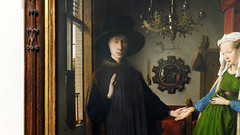
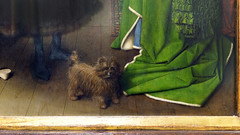
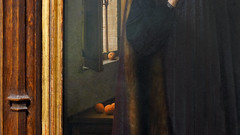
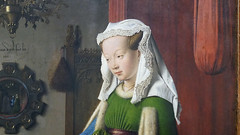

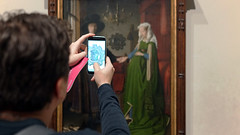
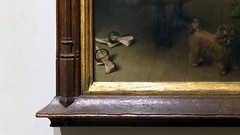

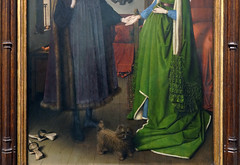

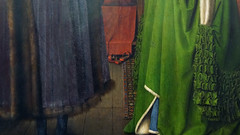
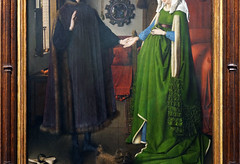
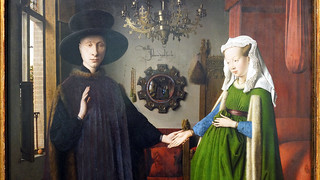
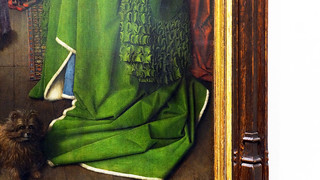
The question of pregnancy in Jan van Eyck’s Arnolfini Portrait
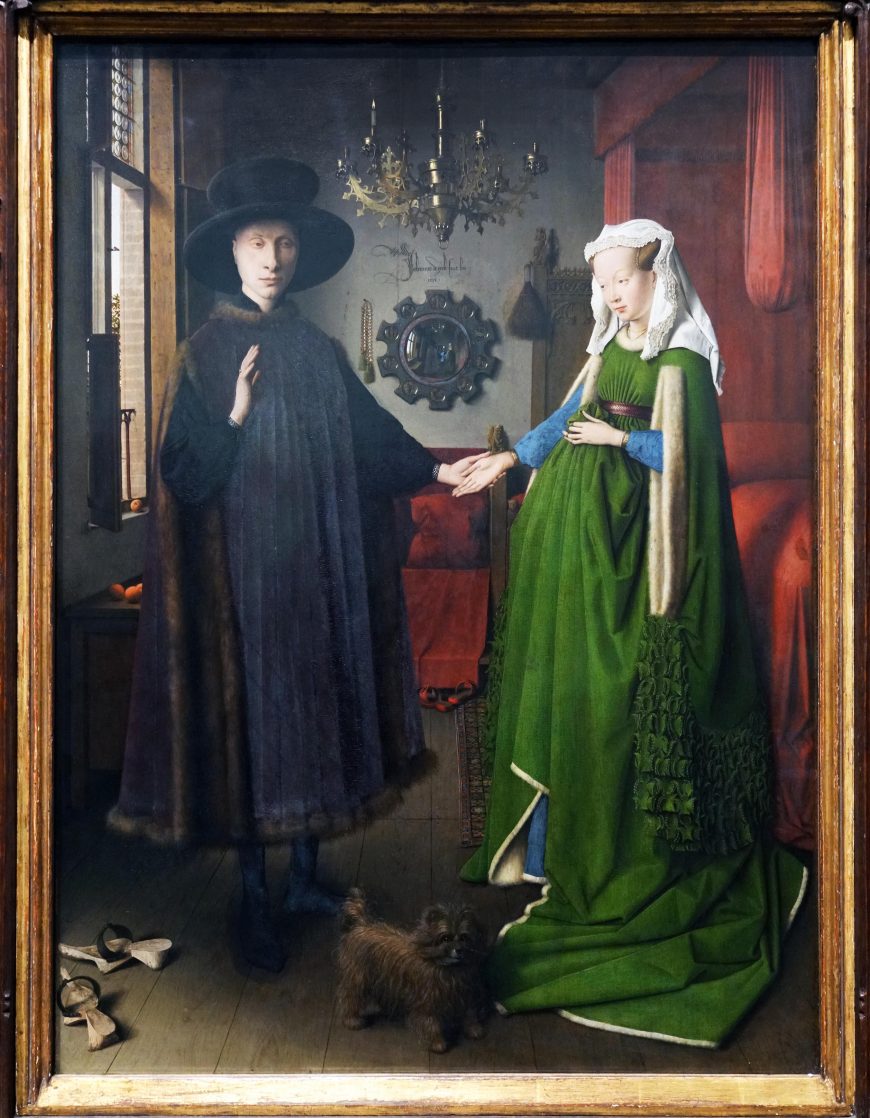
But is she pregnant?
Jan van Eyck’s equally enigmatic and iconic Arnolfini Portrait often prompts art history newcomers and experts alike to ask: is the female figure pregnant? Questions about the presence of pregnancy in the portrait are so common that the London National Gallery’s website addresses the issue on the second line of the painting’s official explanatory text.
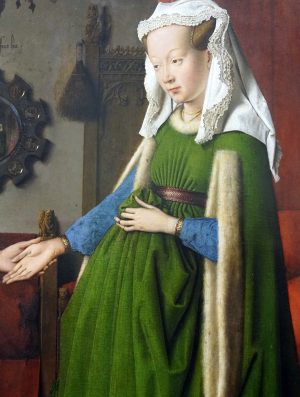
Is the woman in the Arnolfini Portrait pregnant? The short answer is no. The illusion is caused because the figure collects her extensive skirts and presses the excess fabric to her abdomen where it springs outwards and creates a domelike silhouette. Her hand position is regularly read by modern viewers as a universal acknowledgment of pregnancy, but in the Renaissance this gesture would have been understood instead as a sign of adherence to female decorum. Young Renaissance women were encouraged to keep their hands demurely clasped around their girdles when in public, as this was seen as polite and unobtrusive.
The issue of pregnancy in the Arnolfini Portrait is a complex one: the figure is not literally pregnant, because painting or sculpting pregnancy violated the period’s artistic customs—yet pregnancy is nevertheless present in the picture. Both pregnancy symbolism and expectation are at play within the painting.
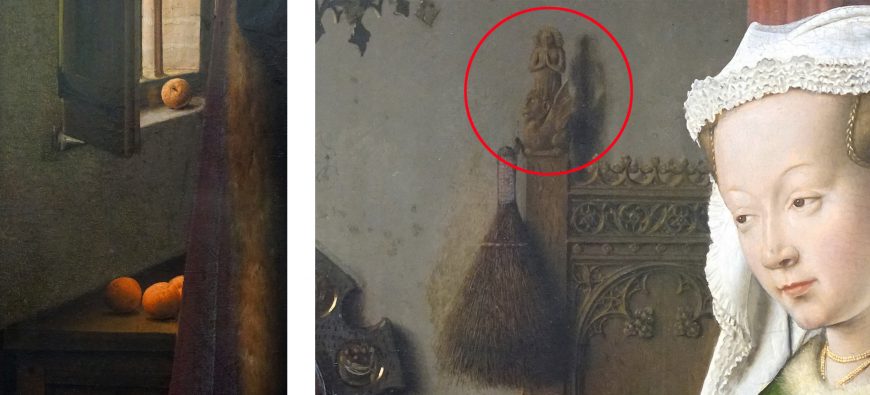
Objects alluding to future pregnancy pepper the composition, from the ripened fruit arranged on the windowsill, to the wooden statuette of Saint Margaret, the patron saint of childbirth, who is shown overcoming the dragon of heresy on the bedframe. Though it’s impossible to sever the question concerning pregnancy from this painting, we can answer it by examining both Renaissance pregnancy and dress practices.
Renaissance pregnancy
The highly-gendered Renaissance world produced widely disparate male and female lived experiences. While a man generally married in his third or fourth decade, allowing him ample time to grow his business or estate, women became brides ideally between the ages of thirteen and seventeen. Women, therefore, were expected to and did spend the majority of their married lives with child.
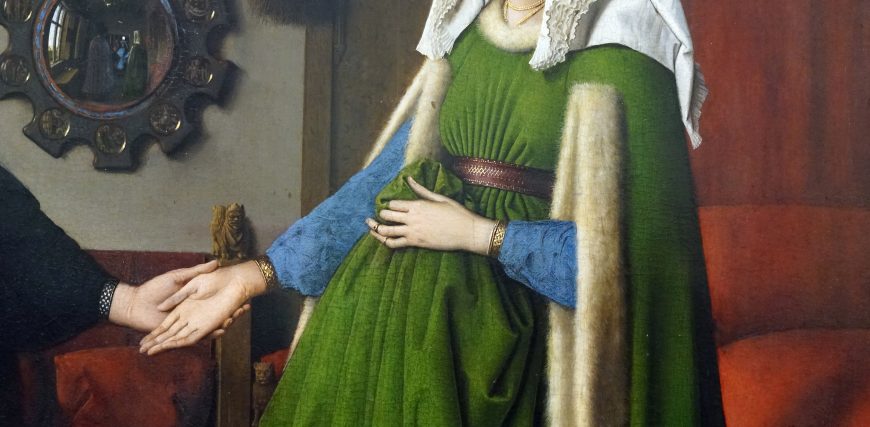
Arnolfini’s wife is not pregnant in the picture, but period norms assumed she soon would be. Art historian Diane Wolfthal agrees that although the woman is not pictured pregnant, “the panel alludes to the proper goal of sexual relations through the wife’s protruding belly…her gesture…brings attention to her womb,”[1] and argues that the few period viewers who came into contact with the Arnolfini Portrait would have understood and recognized this signaling.
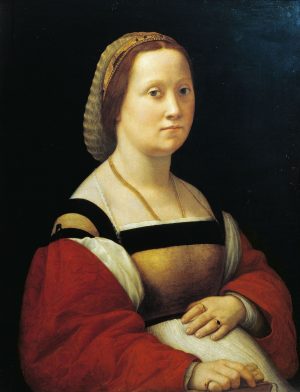
Although married Renaissance women spent the majority of their premenopausal lives with child, pregnancy itself was rarely represented. Artists working across a myriad of media shied away from depicting pregnancy, most likely because the condition was thought to be indecorous.
During the Renaissance, when a woman entered into her third trimester, she generally remained at home in a ritual called confinement. Further, depicting pregnancy admitted a direct link to human sexuality. Though procreative intercourse between heterosexual married couples was the only church-sanctioned form of sexuality in the Renaissance, to portray a married woman pregnant was generally seen as improper.
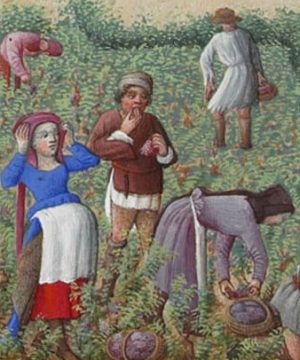
Rare exceptions exist, such as Raphael’s inscrutable Donna Gravida, or Portrait of an Unknown Lady attributed to Marcus Gheeraerts II, or the peasant woman toiling away in the fields in the September page of the Limbourg brothers’ Très Riches Heures du Duc de Berry.
But even paintings depicting the Visitation—a moment in the Gospel of Luke when Mary and Elizabeth meet and both are pregnant (Mary with Christ, and Elizabeth with St. John the Baptist)—the two biblical heroines are rarely depicted as obviously gestational, though again, there are a few exceptions (for example, Rogier van der Weyden’s Visitation).
Another medium that offers a glimpse into Renaissance pregnancy and childbirth are birth trays, which were popular gifts for new mothers that would include jars and bowls containing soup and sweets.
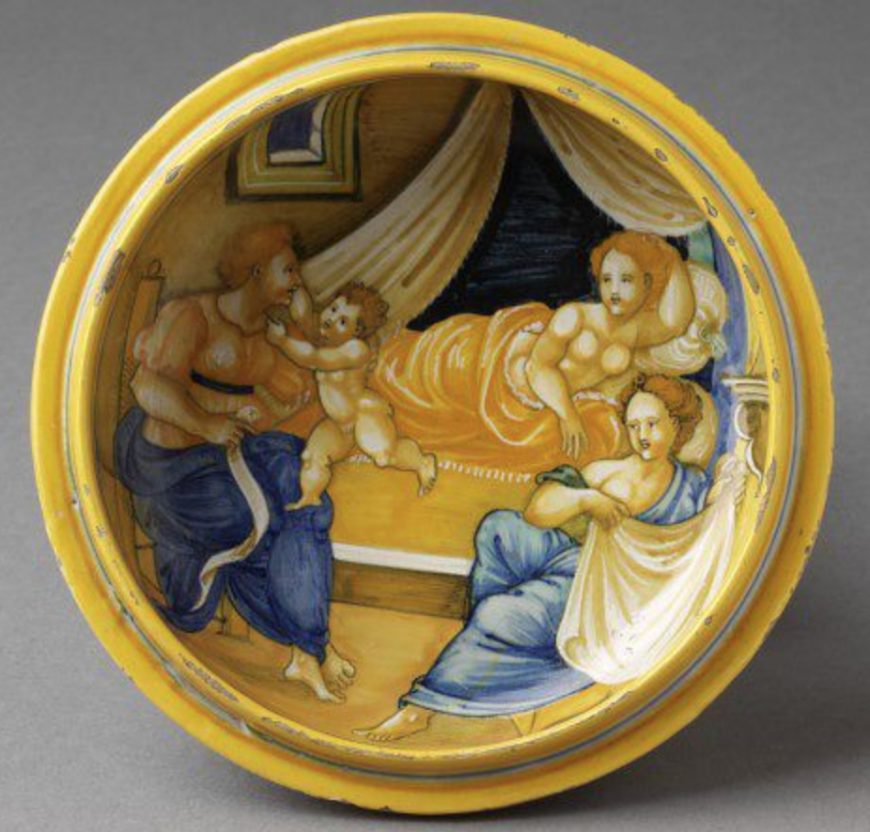
Renaissance dress and gender norms
While the Arnolfini Portrait foregrounds many domestic objects, dress takes center stage. Both outfits in the portrait are ludicrously expensive and detailed, but the woman’s clothing outshines her husband’s. This excessive disparity in color and yardage is perfectly in line with Renaissance fashion and gender difference. Men’s outfits tended to be tailored from darker fabrics to signal the wearer’s sobriety and lack of vanity. In contrast, Renaissance women’s bodies in both images and reality were potent sites of material display. An exemplary upper-class wife was required to demonstrate her husband’s wealth (through his ability to keep her adorned in the latest fashion trends) as well as the couple’s potential fertility.
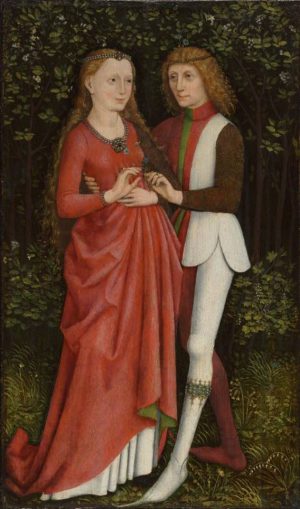
The woman in the Arnolfini Portrait holds her dress in a way that styles her body as seemingly pregnant. This pose is not uncommon in depictions of Renaissance women, especially in the Northern Renaissance context (see, for example, A Bridal Couple in The Cleveland Museum of Art, left). The odd pose was adopted for practical purposes: full Renaissance skirting forced women to pick up their gowns when they walked. The gesture likewise illuminates the wearer’s moneyed status.
According to costume historian Ann Hollander, the notorious, seemingly pregnant silhouette touted by the woman in The Arnolfini Portrait (and countless other images of women created throughout the early modern period) connoted elegance and luxury on the part of the wearer and her male keeper (for the man it was a swelled midsection). The more dramatic a woman’s curves, the more real estate to show off exquisitely tailored fabrics. The lifting of skirts likewise provided a chance to further showcase wealth by revealing contrasting undergarments (such as the blue undergown worn by the woman in the Arnolfini Portrait).
While the woman’s gown does not display an actual pregnancy, it is possible that the controversial dress is coded with pregnancy and may be read as symbolic of women’s roles in the Renaissance, including motherhood. The woman’s ample costume does not conceal or describe a pregnancy; however, it is roomy enough to easily host a future one without the need for tailoring. Its green hue could also connote fecundity, as the color was widely associated with springtime and therefore fertility and fruitfulness in the period. Additionally, the gown is lined with ermine. Art historian Jacqueline Musacchio has argued that martins and weasels in portraits (either alive or skinned) may be symbolic of pregnancy or the hope for future pregnancy. It is no accident, therefore, that mid-fifteenth century Flemish haute couture (high fashion) suggests pregnancy.
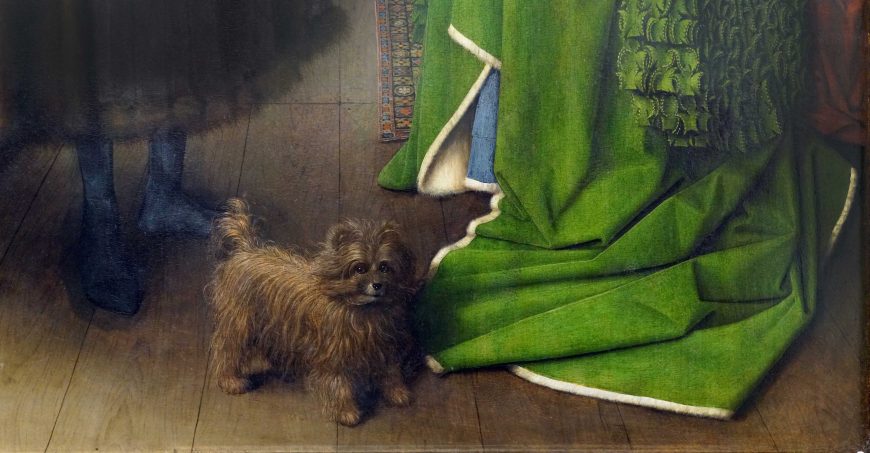
A new question
Perhaps the question we should be asking when considering the Arnolfini Portrait is not “is the female figure pregnant?” Instead, we can consider why the female figure appears to be pregnant. The persistent illusion asks us to consider Renaissance gender roles, as well as our own beliefs concerning depictions of women in pre-modern art. The woman in the green dress is not meant to be read as actually pregnant, yet—more significantly—she lived and died in a culture that expected near-constant pregnancy from women.
Notes:
[1] Diane Wolfthal, In and out of the Marital Bed: Seeing Sex in Renaissance Europe (New Haven: Yale University Press, 2010), pp. 40-41.
Additional Resources:
This painting at The National Gallery
Renaissance Childbirth from the Victoria & Albert Museum
Victoria Finlay, Color: A Natural History of the Palette (1st Ballantine Books ed. New York: Ballantine Books, 2003).
Anne Hollander, Seeing through Clothes (Berkeley: University of California Press, 1993).
Jacqueline Marie Musacchio, “Weasels and Pregnancy in Renaissance Italy,” Renaissance Studies 15, no. 2 (2001), pp. 172–87.
Diane Wolfthal, In and out of the Marital Bed: Seeing Sex in Renaissance Europe (New Haven: Yale University Press, 2010).
Smarthistory images for teaching and learning:

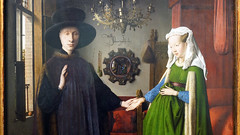
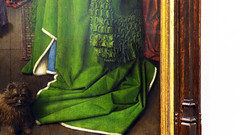









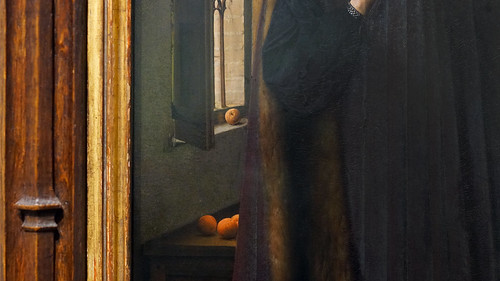

Petrus Christus
Petrus Christus, Portrait of a Carthusian
by DR. DAVID DROGIN and DR. BETH HARRIS
Video \(\PageIndex{19}\): Petrus Christus, Portrait of a Carthusian, 1446 (Metropolitan Museum of Art, New York)
Smarthistory images for teaching and learning:
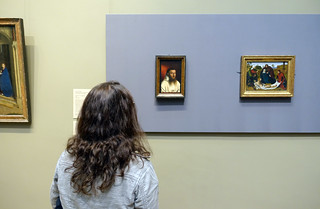


Petrus Christus, A Goldsmith in his Shop
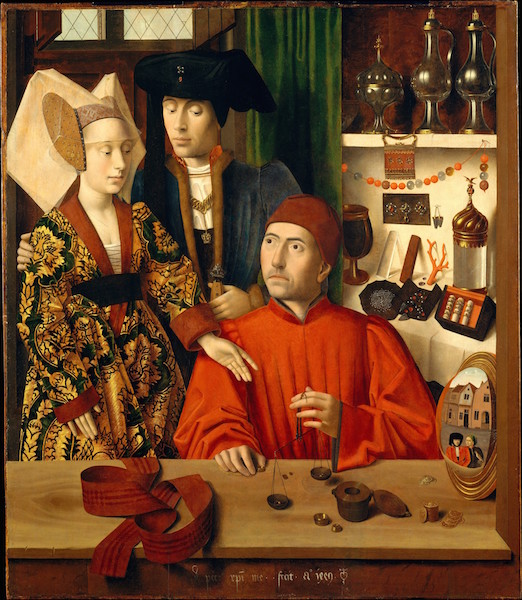
Out shopping
Like many Northern Renaissance paintings, Petrus Christus’ Goldsmith in his Shop reveals its complexities to the viewer over time. At first, one sees a group of three people inside a room filled with trinkets. The two standing figures—a male and a female in dressed in rich, expensive-looking clothing—appear to be a couple, as the man has his arm wrapped around the back of the woman. This woman gestures with her left hand towards the seated man, who, clad in a plain, red garment with a matching hat, looks up at the woman. In his left hand, he holds a small balance which supports a gold ring (fans of northern art will recognize this as a small scale—much like the one that appears in Vermeer’s much later Woman Weighing Gold from 1662-1663). In fact, the figures are inside a gold shop, and the man is a goldsmith. The baubles on display—objects made from precious metal, stones, glass, and coral—are his wares, and the standing couple is probably about to make a purchase.

However, there is much more to this story. The smith appears to be seated at a work desk, but in fact, the front of the desk is visible, and a length of fabric hangs over it, into our space. Most importantly, a convex mirror resting on the smith’s desk (in the lower right hand corner of the painting) reveals a cityscape. What we see is not a mere desk however. It is, in fact, the front of the smith’s shop, which opens on a street in Bruges (in present-day Belgium, and the city where Christus lived and worked). The two young men captured in the mirror hold a falcon and approach the smith’s shop. The mirror situates us, the viewer, on the street in Bruges with that couple, looking into the smith’s shop at the artisan and the rich patrons behind him.
A gift for a royal wedding
Although genre scenes, or images of every day life, became popular in the North later (“the North” meaning all of the countries above Italy), Christus’ creation of illusionistic and complex space implies that the painting also carries a complex meaning. Since the painting is signed and dated by the artist in white paint in the center foreground, it can firmly be placed in the year 1449. This is the year that King James II of Scotland married Mary of Guelders. The duke of Burgundy, Phillip the Good, who was also a renowned patron of the arts in Bruges, commissioned the goldsmith Willem van Bleuten to make the couple a gift for their wedding. Thus, the painting is believed to depict van Bleuten as he is about to give the royal couple a gift of golden rings, made for their marriage.
This interpretation also explains the very expensive brocaded and bejeweled clothes—well out of the budget of the average man—worn by the standing couple. The piece of fabric on the desk is believed to be a wedding girdle (belt), and also supports this interpretation.
The two men in the convex mirror may not only be a device used to demonstrate the artist’s virtuoso skill in this tour de force of illusionistic painting. The falcon held by the men is a symbol of greed and pride. Since the scale in the hand of the goldsmith, along with the illusions to marriage and purity, represent perfection and balance, the presence of the two figures with their ill-associated bird creates a contrast between the perfect world of the royals and the imperfect world of the viewer. The royal couple is morally superior to the common man.

Oil paint
Petrus Christus’ artistic concerns are typical of painters of his time. The minute detail of the trinkets in the shop, as well as the luminosity of the painting, are only possible because of the use of oil paint, which was not common in Italy until many years later (indeed, the technique is commonly believed to have come to Italy from the North). The use of convex mirrors was a device exploited by northern painters, such as in Jan van Eyck’s Arnolfini Portrait (1434)—another oil on oak panel painting. In that painting, a convex mirror hanging in the back of the room reflects the artist himself, whose self-portrait con be discerned in the glass. In Christus’s painting, the round surfaces of the jewels and goblets echo the convex mirror, and the white highlights that are used to create both light and volume betray an interest in still-life painting which would come to dominate northern painting hundreds of years later.

Although northern art of this period is often compared to Italian art (and often unfavorably at that), paintings such as Petrus Christus’ Goldsmith in his Shop demonstrate that, although the concerns of the northern artist were different, they were no less talented, their paintings no less beautiful and complex. Indeed, northern paintings from this period (by Petrus Christus himself, along with his contemporaries Jan van Eyck and Hans Memling) were often bought by Italians and made their way into Italy and helped shape the style of the Italian High Renaissance, as well as the Mannerist period that followed. Still, these paintings deserve to be appreciated in their own right as examples of the rapid artistic changes that occurred in the early 1400s, as the world was on the precipice of great political, historic, and cultural revolutions that would end the Middle Ages and bring us into the Modern World.
Additional resources:
This painting at The Metropolitan Museum of Art
Pertrus Christus from the Flemish Primitives site
Petrus Christus on The Metropolitan Museum of Art’s Heilbrunn Timeline of Art History
Painting in Oil in the Low Countries and Its Spread to Southern Europe
Petrus Christus, Portrait of a Young Woman
by DR. STEVEN ZUCKER and DR. BETH HARRIS
Video \(\PageIndex{20}\): Petrus Christus, Portrait of a Young Woman, c. 1470, oil on oak, 29 x 22.50 cm (Gemäldegalerie, Staatliche Museen zu Berlin)
Smarthistory images for teaching and learning:
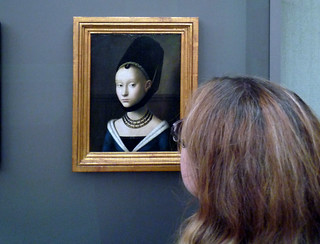

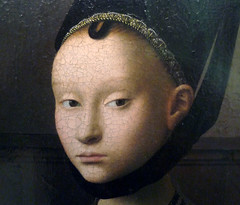
Rogier van der Weyden
Rogier van der Weyden, Deposition
by DR. DAVID DROGIN and DR. BETH HARRIS
Video \(\PageIndex{21}\): Rogier van der Weyden, Deposition, c. 1435 (Prado, Madrid)
Rogier van der Weyden, Crucifixion Triptych
by DR. STEVEN ZUCKER and DR. BETH HARRIS
Video \(\PageIndex{22}\): Rogier van der Weyden, Crucifixion Triptych, c. 1445, oil on oak, center panel: 101 x 70 cm, each wing: 101 x 35 cm (Kunsthistorisches Museum, Vienna)
Smarthistory images for teaching and learning:
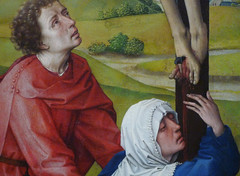

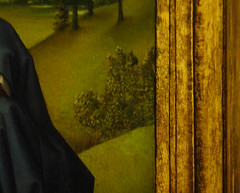
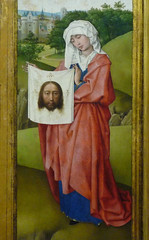
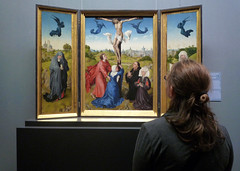
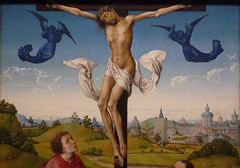

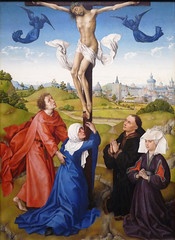
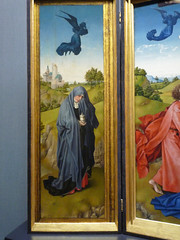
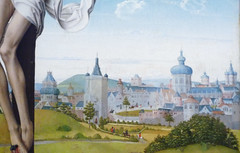
Rogier van der Weyden, The Last Judgment
by DR. BETH HARRIS and DR. STEVEN ZUCKER
Video \(\PageIndex{23}\): Rogier van der Weyden, Last Judgment, 1443-51, oil on panel, 215 x 560 cm (Musée de l’Hôtel-Dieu, Beaune)
Additional resources:
Prayers and Portraits: Unfolding the Netherlandish Diptych
About the artist and a work in the collection of the National Gallery of Art (from the National Gallery of Art)
An introduction to Valois Burgundy
Barbara G. Lane, “‘Requiem aeternam dona eis’: The Beaune Last Judgment and the Mass of the Dead”
Rogier van der Weyden, The Crucifixion, with the Virgin and Saint John the Evangelist Mourning
by DR. CHRISTOPHER D.M. ATKINS and DR. BETH HARRIS
Video \(\PageIndex{24}\): Rogier van der Weyden, The Crucifixion, with the Virgin and Saint John the Evangelist Mourning (companion paintings), c. 1460, oil on panel, left panel 180.3 × 92.2 cm, right panel 180.3 × 92.5 cm (Philadelphia Museum of Art). Speakers: Dr. Christopher D.M. Atkins, Associate Curator of European Painting and Sculpture before 1900, Philadelphia Museum of Art and Dr. Beth Harris.
Additional resources:
Stephan Kemperdick and Jochen Sander, eds. The Master of Flémalle and Rogier van der Weyden (Frankfurt am Main: Städel Museumand Berlin: Gemäldegalerie, Staatliche Museen, 2008).
Philadelphia Museum of Art: Handbook (Philadelphia: Philadelphia Museum of Art, 2014), p. 98.
Griet Steyaert and Mark S. Tucker, “The Philadelphia Crucifixion, Dijon Annunciation, and Washington Apparition: A carved altarpiece’s painted wings from the workshop of Rogier van der Weyden,” Boletín del Museo del Prado, Tomo XXXII, Número 50, (Madrid: Museo Nacional del Prado, 2014), pp. 50-65.
Smarthistory images for teaching and learning:


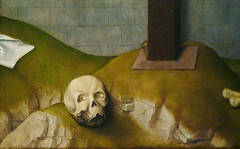
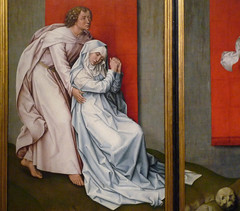

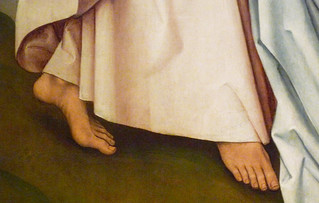
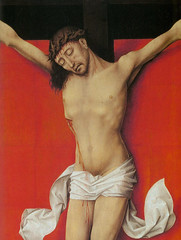
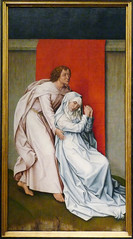
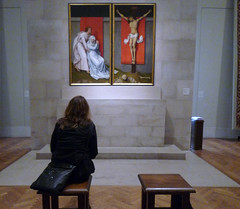
Hugo van der Goes, Portinari Altarpiece
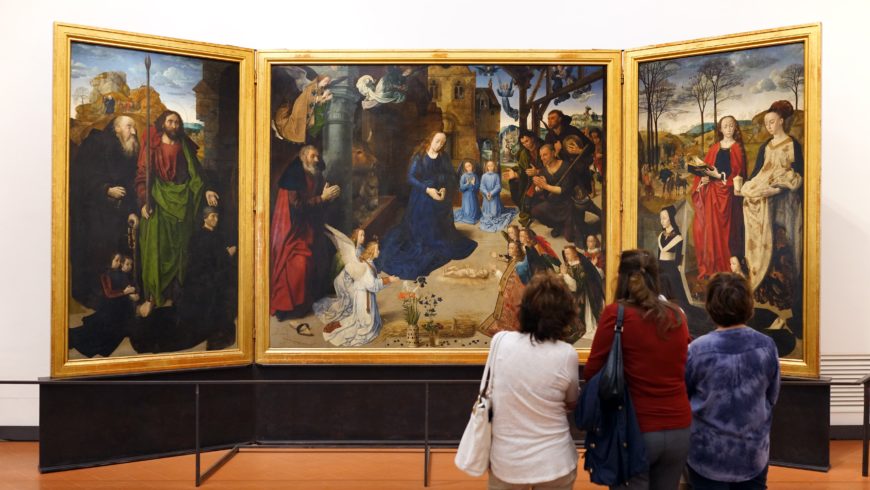
Artworks are powerful things. Hugo van der Goes’s Portinari Altarpiece caused quite a stir when it arrived in Florence—the city that was to become its permanent home. Van der Goes, master of light and minute descriptive details, is considered one of the greatest Netherlandish painters of the second half of the fifteenth century. The Portinari Altarpiece is a large triptych that was commissioned by an Italian named Tommaso Portinari, who was living in the Netherlands.
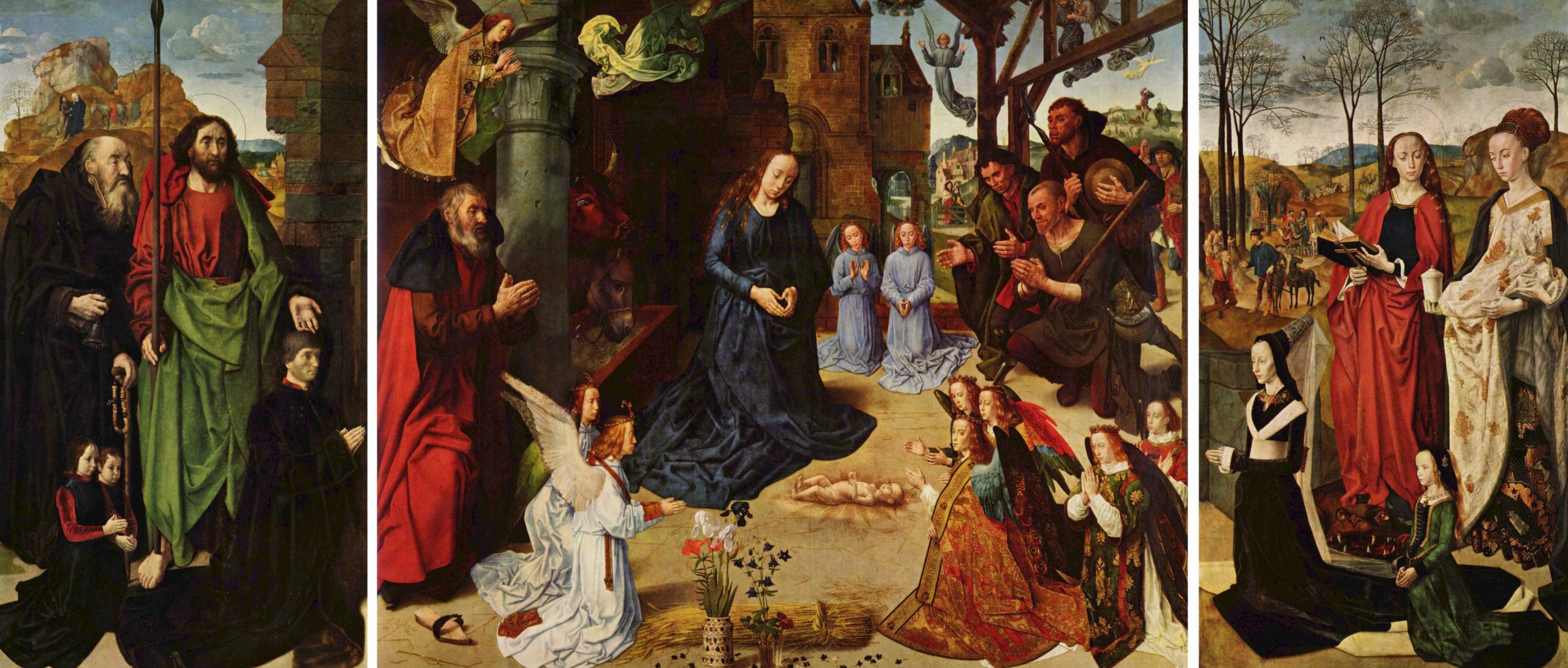
An Italian family in the North
Just as today, people in the renaissance often traveled extensively or even moved permanently for work. Portinari, his wife Maria Maddalena Baroncelli, and their children were living in Bruges at the time of this painting’s creation. Tommaso worked as a high-ranking agent of the Medici banking industry, helping to run a branch of the bank in Bruges. The Medici were one of the most powerful families in western Europe, and their lineage had developed an extremely wealthy banking, mercantile, and political family. Agents throughout Europe managed branches of their banking empire.
The Portinari family and Florence’s Hospital of Santa Maria Nuova
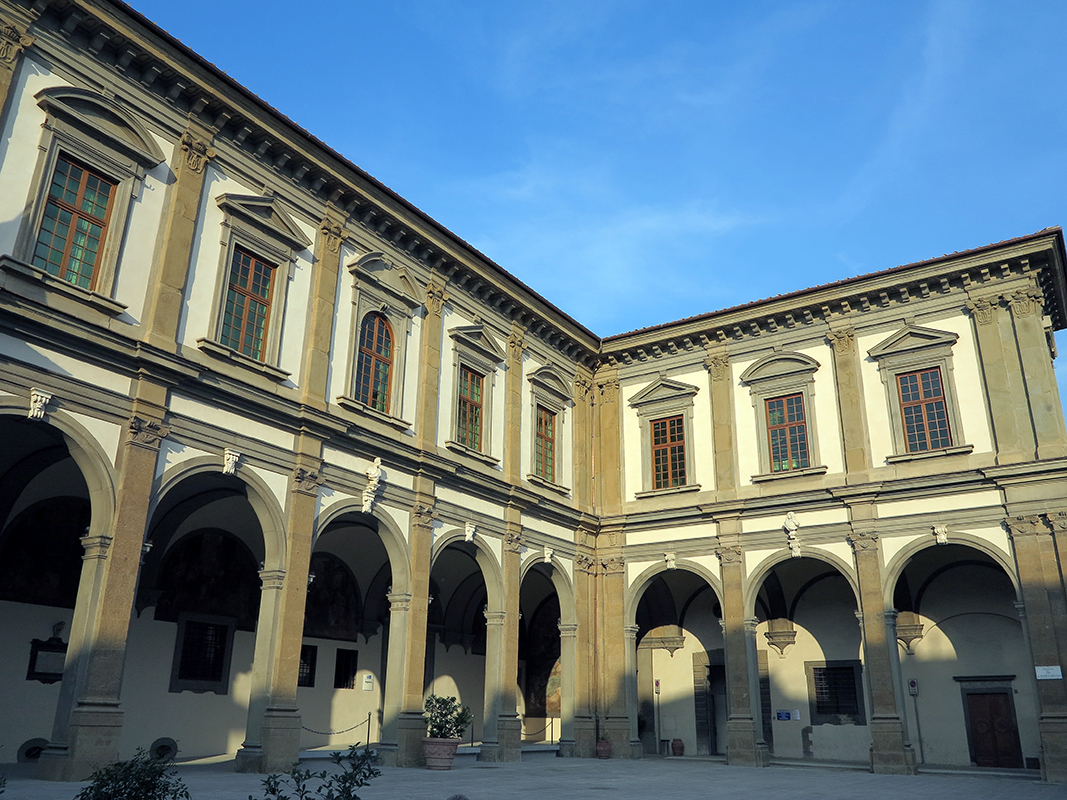
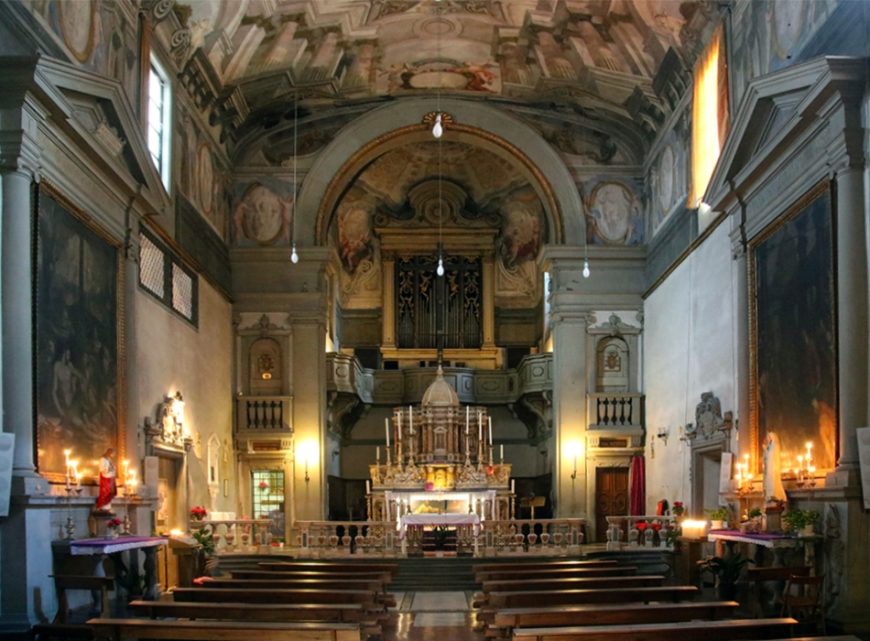
While Tommaso had made a name for himself in Bruges, his family remained important to the history of Florence. In 1288, Tommaso’s ancestor, Folco Portinari, founded the hospital of Santa Maria Nuova, today the oldest functioning hospital in Florence. In the 1420s, the Portinari family supported further renovations to the hospital, which, by the fifteenth century had around 200 beds (up from 12). As with many hospitals today, Santa Maria Nuova had a connected church, Sant’Egidio.
The Portinari Altarpiece was commissioned for the main altar of this church, and was simultaneously a way for Tommaso to perpetuate his family’s name and importance in conjunction with the city of Florence and the hospital of Santa Maria Nuova.
The Portinari Altarpiece stands as a highlight of Tommaso’s career and the public image he hoped for his family name to retain. Unfortunately, the Portinari family fell on difficult financial times not long after this painting’s creation, as Tommaso lost the Medici family a great deal of money through loans to Charles the Bold, the Duke of Burgundy, which were never paid back in full.
Hugo van der Goes and north-south exchange
Portinari’s choice of a Netherlandish artist to complete this great altarpiece to be sent back to Florence helped to effectively change aspects of Italian art. The latter half of the fifteenth century was characterized by increased artistic exchange between northern European and Italian artists. Italian artists were enthralled by Northern artists’ careful attention to individual details and still-life minutiae incorporated in architectural settings and landscapes. Hugo van der Goes was considered a master of such careful, minute details and his talent was often compared to that of Jan van Eyck, considered one of the greatest painters of the early fifteenth century. Look closely, for example, at van der Goes’s rendering of the foreground angels’ garments. It appears as though we can physically touch the gold brocade of the fabric. And the clear vessel in the foreground also flawlessly seems to capture, reflect, and refract light.

Such tiny details are found throughout the Portinari Altarpiece, and nearly all of them hold some iconographic meaning. When this painting finally arrived in Florence in 1483 for its installation in the church of Sant’Egidio, it had a direct, visible effect on artistic production in Italy. A particularly famous painting that clearly recalls the Portinari Altarpiece is Domenico Ghirlandaio’s Adoration of the Shepherds, painted in 1485—only two years after the Portinari Altarpiece arrived in Florence. In Ghirlandaio’s painting, one can see that the shepherds adoring the Christ child are rendered with such individualized detail that they feel like portraits, as in the Portinari Altarpiece. The group also takes the exact same formation as the three shepherds pictured in van der Goes’s work.
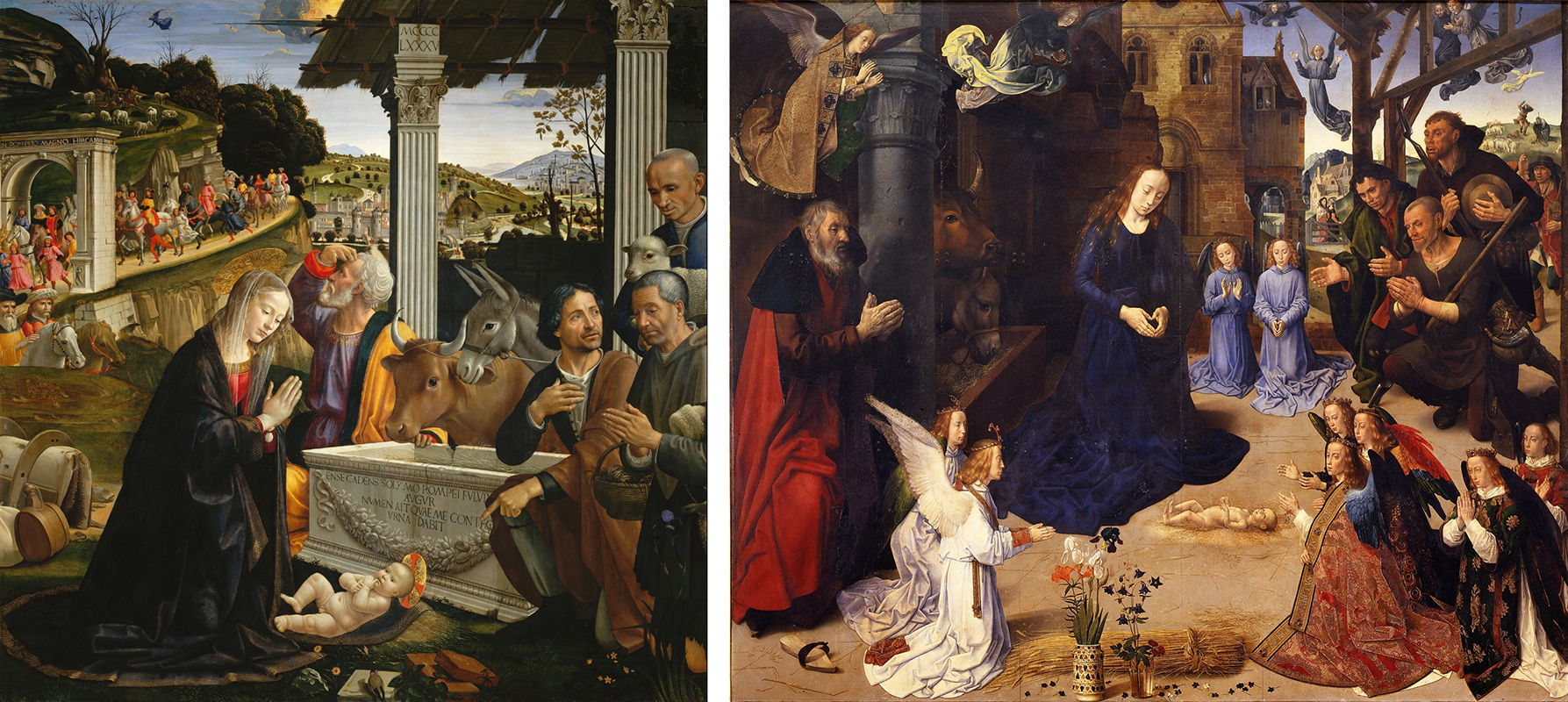
Layered iconography
Iconography, commonly used in the field of art history, is the study of the symbolic meaning of things found in works of art. In northern renaissance art, artists frequently used certain figures, objects, and even depictions of biblical or historical events to symbolize something more to period viewers than what was seen on the surface. The iconography throughout the Portinari Altarpiece is extensive and quite complex.
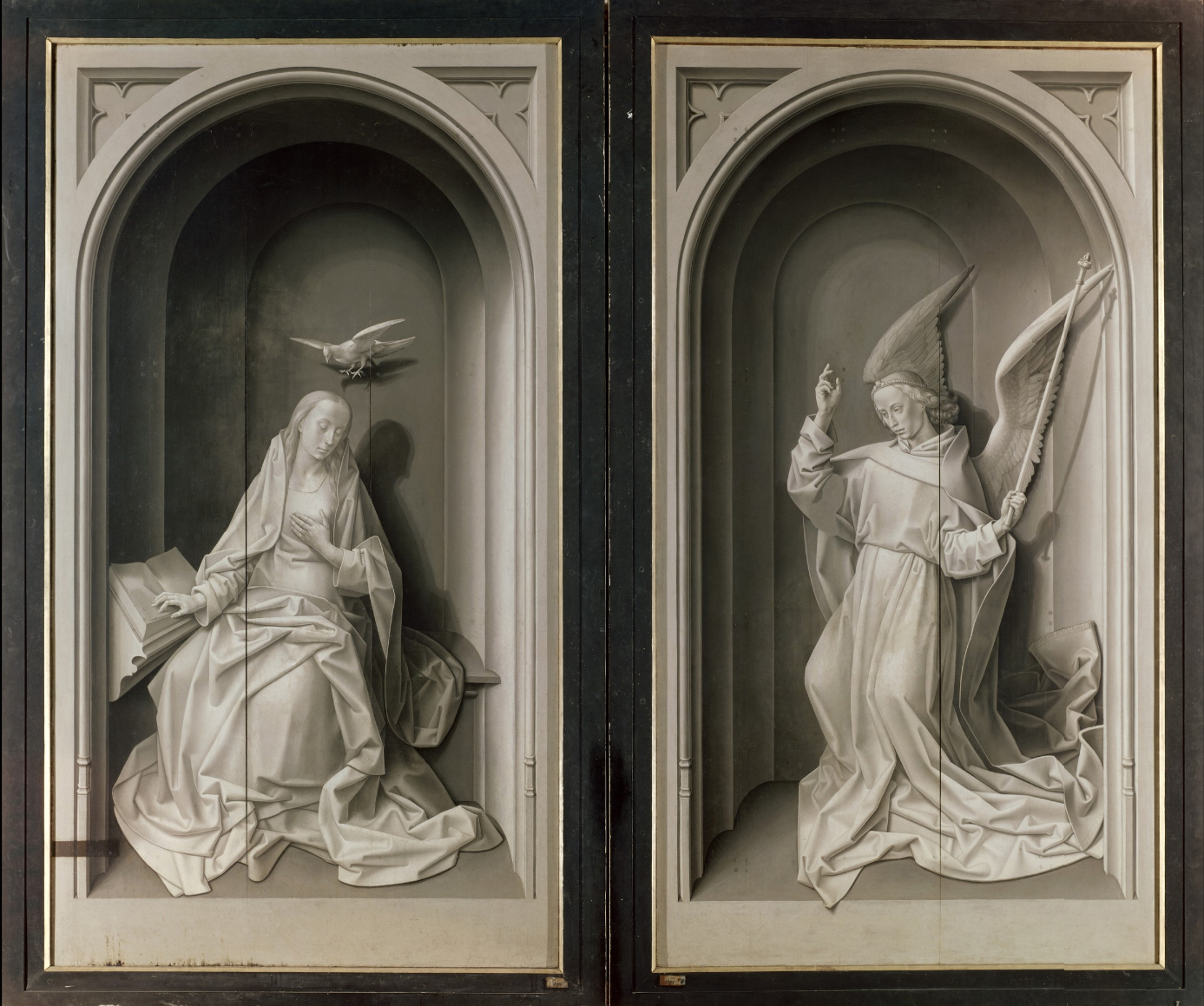
Triptych altarpieces like the Portinari Altarpiece would have been kept closed, except on holidays and special feast days. Therefore, the exterior of the folding side wings of such artworks were typically painted. The Portinari Altarpiece’s exterior is decorated with a depiction of the Annunciation, the biblical event when the Angel Gabriel appeared to the Virgin Mary to tell her that she had been chosen to carry the son of God. This moment is understood in the Christian faith as the beginning of mankind’s salvation. Here, we see it essentially frozen in time, as the artist has chosen to paint these figures in grisaille. These faux sculptural figures are located in shallow architectural niches and reveal van der Goes’s incredible artistic talent in their believable naturalism.

Upon seeing the Portinari Altarpiece opened, one can imagine that any period viewer would have been stunned by the elaborate details and bright colors contained on the three panels within. In the center panel, we are privy to the quiet, magical moment just after Christ’s birth, the Nativity. Angels surround the kneeling Virgin Mary and newborn Christ child, and the three shepherds have rushed in from the countryside to bear witness to the miracle. This scene would have been instantly recognizable to any period viewer, and most would have noticed the iconographic details—certain objects and scenes that held multiple meanings.
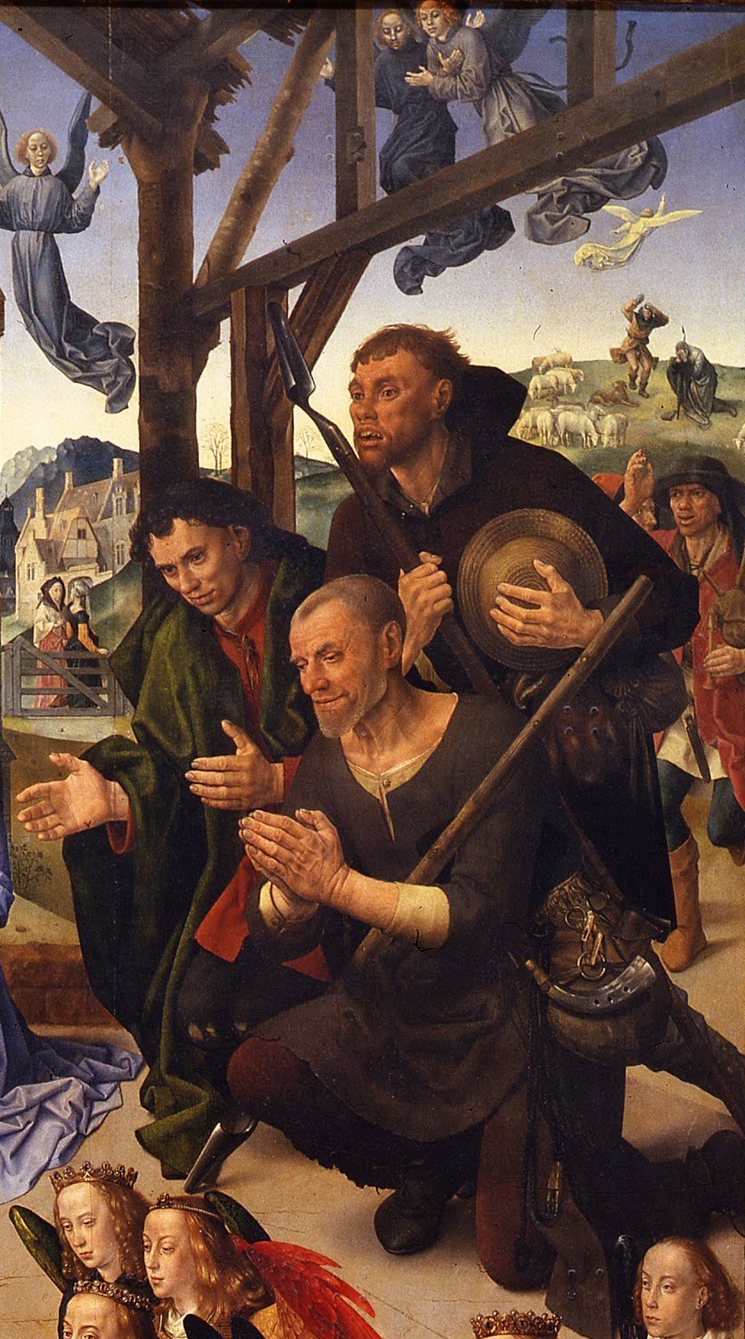
Far in the distance, behind the heads of the shepherds, we see those very same shepherds attending to their flock on the hillside. These tiny figures make gestures of surprise as an angel appears above them. This is the moment of the Annunciation of the Shepherds, when they were told that Christ had been born. In the repetition of these shepherds in the background and again in the foreground, the artist has used what is called continuous narrative, wherein figures are repeated within the same frame of an artwork to show more than one moment of a story.
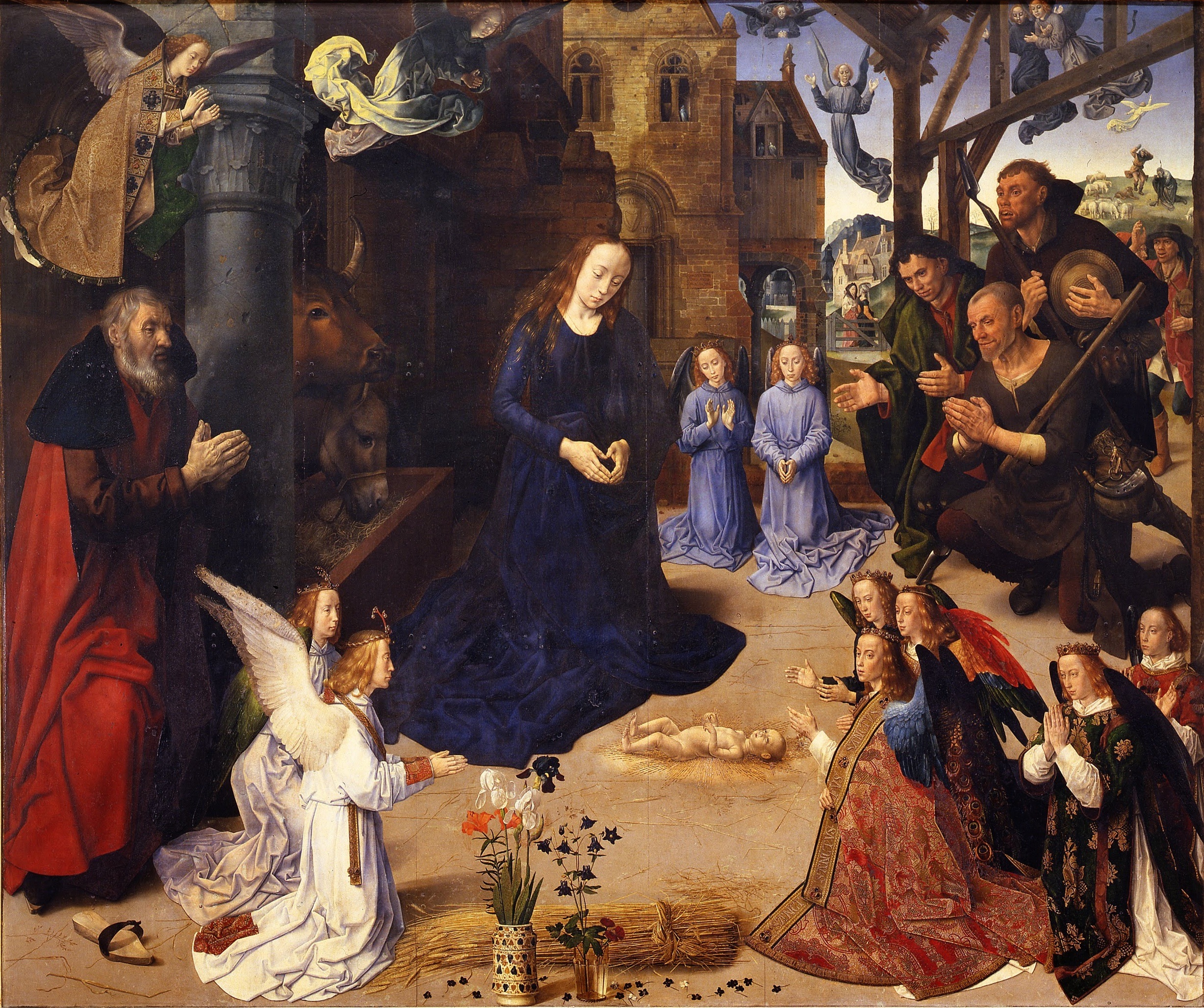
Moving to the left side of the central panel, we see Joseph, Mary’s husband, clothed in a rich red drapery. His hands are together in a gesture of prayer or supplication, as he honors the newly born Christ child. Just in front of him is a clog that has been removed. This detail symbolizes that this scene is taking place on holy ground. Above Joseph are two angels. Note that many angels in this work are dressed in elaborate liturgical, priestly garments (such as the one immediately above Joseph’s head and those on the right side of the image). This would have reminded viewers of the important sacrament that took place at the altar, in front of this altarpiece—the sacrament of communion (where the bread and wine miraculously transform into the body and blood of Christ). One angel, however, who hovers just above the ox and the ass (and is barely visible), has a somewhat dark, foreboding countenance. This is believed by some art historians to represent the lingering threat of Lucifer (Satan).
Everything centers around the Nativity
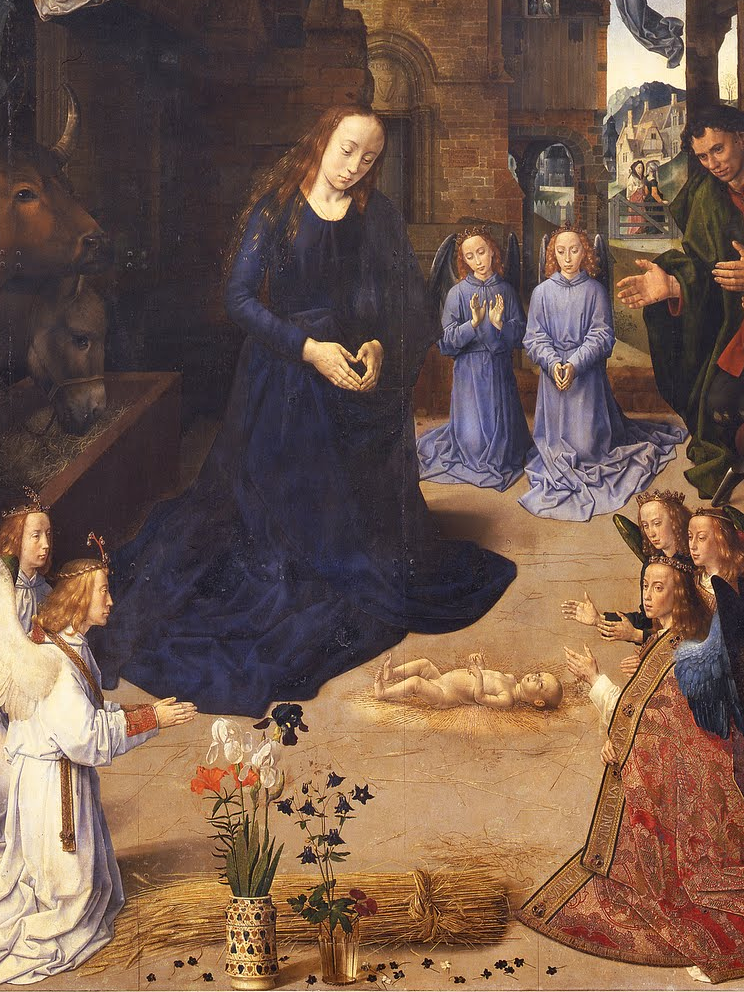
In the center are the most important figures in the scene, the Virgin Mary and the infant Christ. It may seem strange that Christ is laying naked on the bare, hard ground, and that rays of light appear to emit directly from his body. However, this imagery is drawn from the writings of a medieval visionary named St. Bridget of Sweden. By the fifteenth century St. Bridget’s vision of the Nativity had become the inspiration for many depictions of this moment. Mary kneels beside Christ on the ground, a position meant to emphasize her humility, and bends over in somber adoration of her child. And her solemn nature, in this case, is meant to foretell what is to come—that she will have to sacrifice her son for the salvation of humanity.
Perhaps the most striking detail in the central panel is the group of objects in the foreground. Imagine this altarpiece in its original location, just above the altar of Sant’Egidio. The two vases would appear almost as though they were sitting on the altar itself. Notice, too, that the sheaf of wheat behind them is quite similar in color to and situated directly parallel with Christ’s body. At Mass, a priest would consecrate the Eucharist—the bread and wine—thereby turning it into the body and blood of Christ (according to Catholic tradition), which would be consumed in remembrance of his sacrifice. The hem of the red and gold brocaded vestment worn by the angel foregrounded on the right is embroidered with the repeated word “sanctus,” or holy, referencing the moment of the consecration of the Eucharist. The positioning of Christ’s body parallel to the sheaf of wheat, which in turn would be parallel to the physical bread on the altar, functioned as a stark reminder of what really took place at communion. The image masterfully creates a visual equation between the bread, the wheat, and Christ’s body.
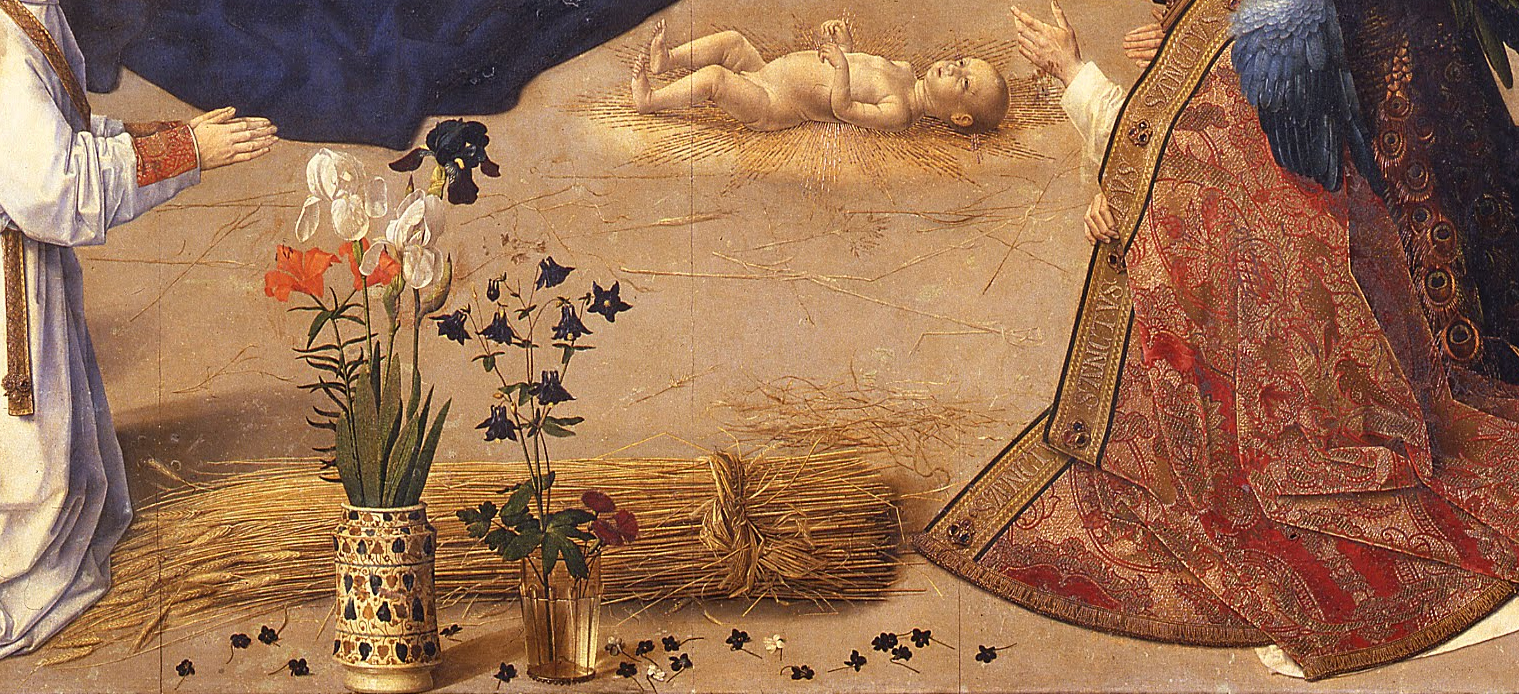
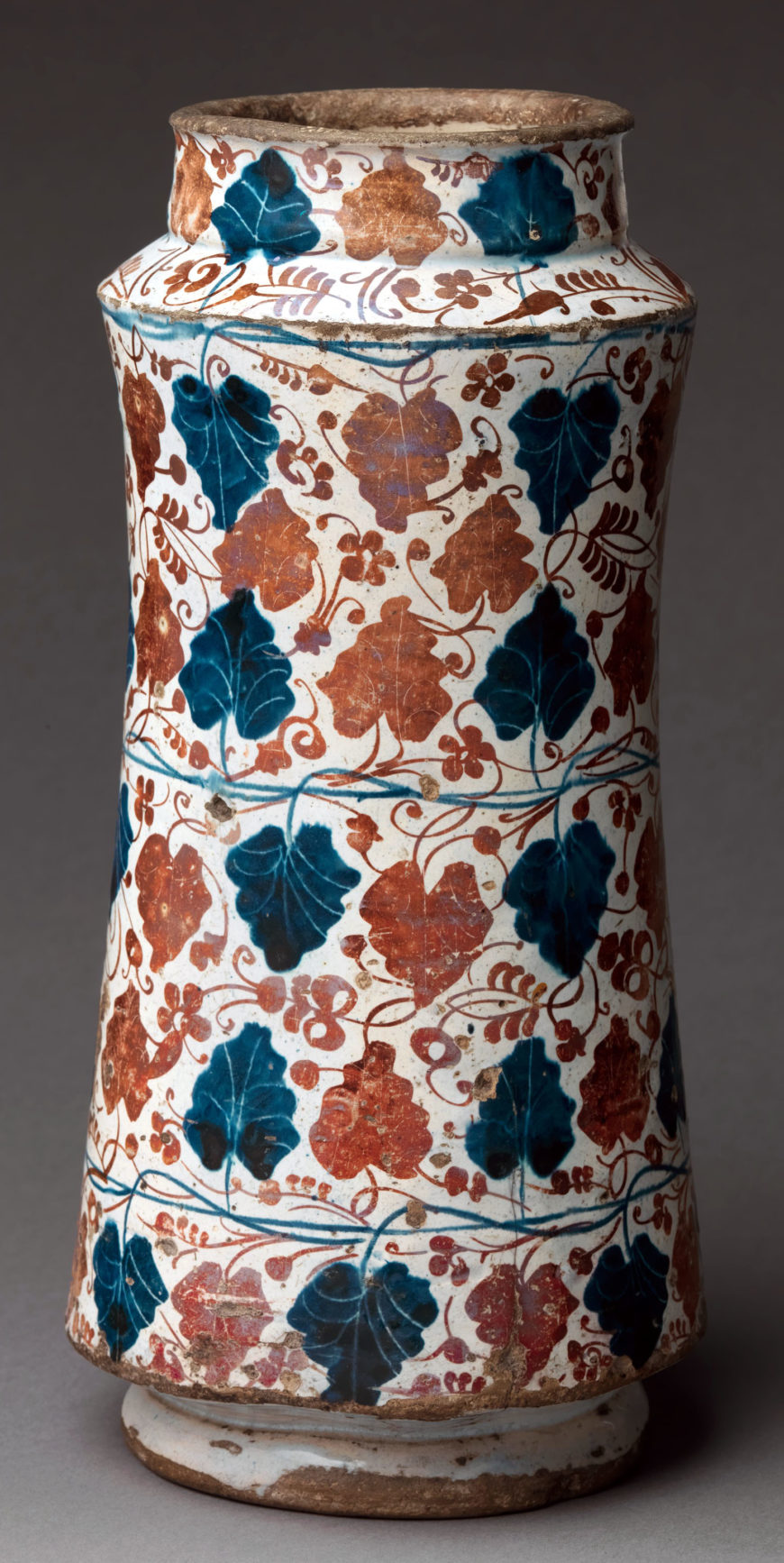
The vases and flowers just in front of the wheat are carefully studied depictions of recognizable flowers that each held symbolic meaning for period viewers. The Spanish albarello vase on the left is a type of vessel that traditionally held herbs and ointments used by apothecaries, an artistic choice which was almost certainly meant to comment on the altarpiece’s location in a hospital’s church. The albarello vase holds two white and one purple iris, along with a scarlet lily. These flowers represent the purity (white), royalty (purple), and Passion, or tortures, (red) of Christ. This vessel is also decorated with an ivy leaf motif that resembles a grape vine, alluding to wine, and therefore, to the blood of Christ, consumed with His body during Mass. The presence of this vase also reminds us that Valencia (in Spain), Italy, and northern Europe were engaged in extensive trade during this time, and expanding their trade across the globe. Spanish lusterware, like this vase, was a popular luxury trade item in the fifteenth century, admired for its reflective surface. The luster technique derives from Islamic pottery, and it is important to keep in mind that the Iberian Peninsula (Spain and Portugal) had a large Muslim population.
The clear vessel to the right holds three red carnations and seven blue columbines. The seven columbines are symbolic of the Seven Sorrows of Mary, while the three red carnations make reference to the three bloodied nails at Christ’s Crucifixion. As you can see, many of these flowers were meant to remind viewers of what was to come for Christ.
The story grows, and so does the Portinari family
Having discussed the details of the central panel, let’s take a look at the two side panels. In the backgrounds of each of the side panels, we find scenes that occurred before, after, and during the primary scene of the Nativity in the center. And just as the story is expanded in the side panels, we see that Tommaso and Maria have expanded their lineage, as well. Van der Goes, a master of detailed portraiture, depicted Tommaso Portinari in the left panel, kneeling in prayer as he faces the miraculous scene in the center. Because he paid for this elaborate gift, his family’s inclusion in the altarpiece essentially guarantees that they will forever be included in the daily prayers carried out in the church. Tommaso is accompanied by their two sons (as of the creation of this painting c. 1476), Antonio and Pigello, who kneel behind him. Note that, even if Tommaso were standing, he would still be noticeably smaller than the two figures who stand behind him. This is known as hierarchy of scale, where a visible difference in size between figures indicates that larger figures are of higher status. In this case, the larger figures are saints. St. Thomas, the name saint of Tommaso, works as his intercessor, effectively “introducing” him to the scene in the center and helping to convey his prayers to heaven. Behind St. Thomas is St. Anthony, the name saint of Antonio, as well as a “plague saint” who was frequently invoked by the sick, suffering, and dying. His presence makes yet another connection to the altarpiece’s original hospital location.
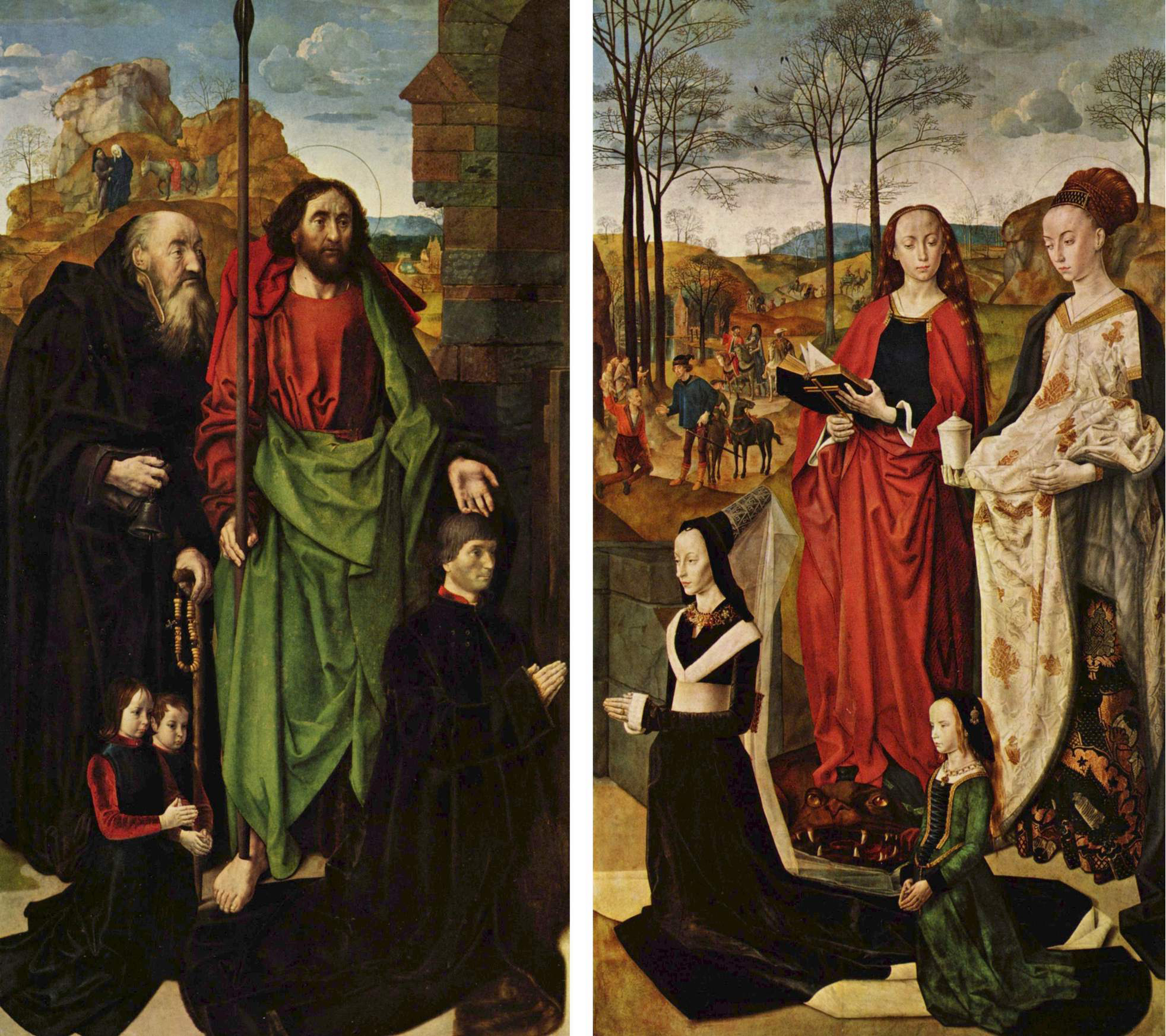
In the right panel, Maria Maddalena Baroncelli kneels in a position that mirrors her husband’s, accompanied by their daughter Margarita. These two figures are joined by their name saints, Mary Magdalene and St. Margaret. Interestingly, however, it is St. Margaret who stands behind Maria, not her name saint Mary Magdalene. St. Margaret is the patron saint of childbirth, and is evoked by pregnant women and those in labor in hopes of a successful process and outcome. St. Margaret is typically depicted as emerging from the mouth of or standing atop a dragon, as seen here (her legend explains that she survived being consumed by Satan, disguised as a dragon, whose stomach then rejected her and she emerged unharmed). As such, it is speculated that this may have been a deliberate choice, as Maria’s primary role as a wife in the fifteenth century was to bear children and continue the Portinari lineage, so she felt a stronger connection to St. Margaret at this point in her life.
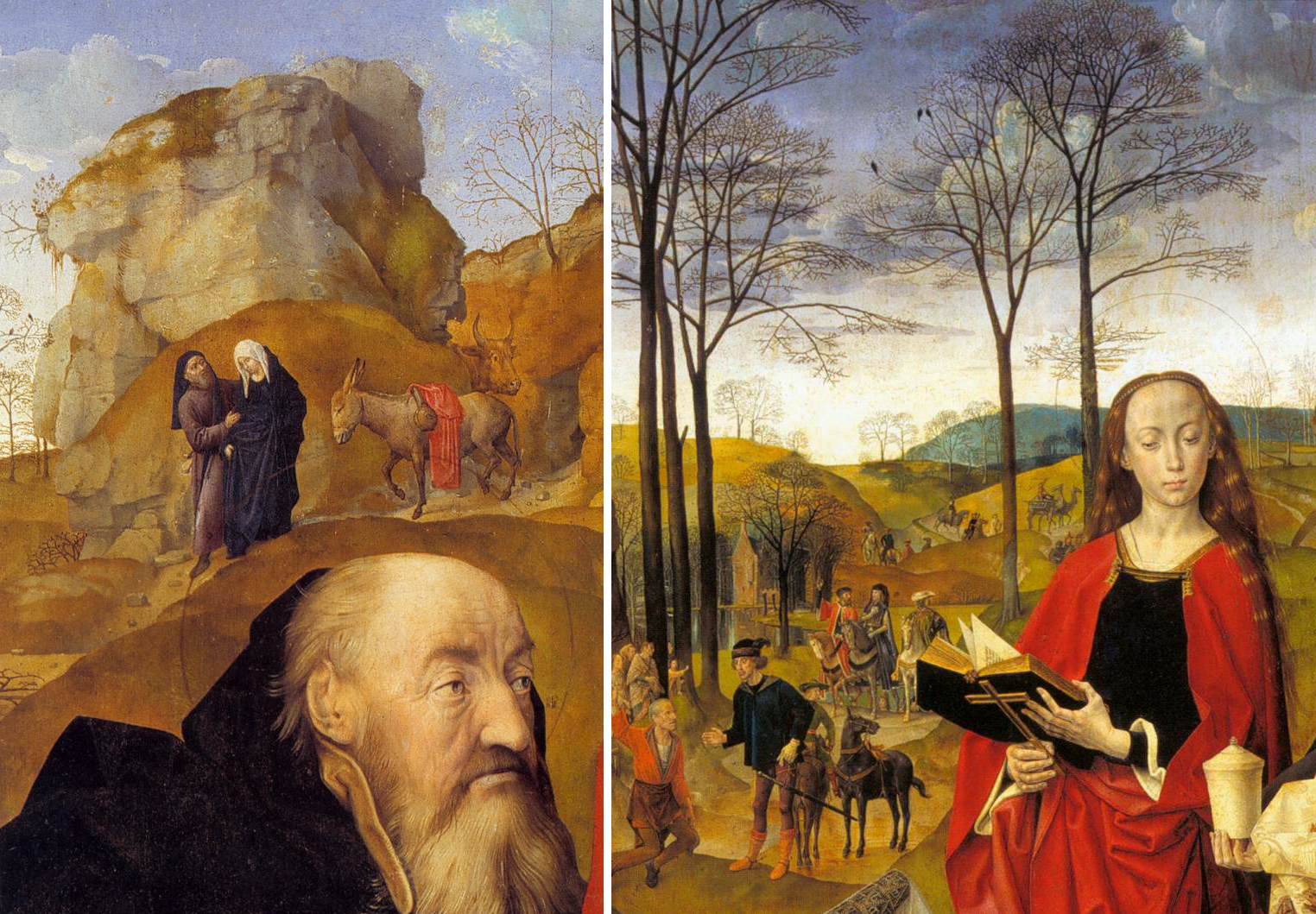
Just as in the central panel, the side panels also include small scenes in the background. In fact, the left panel continues the theme of childbirth already indicated by the Nativity in the center and the presence of St. Margaret in the right panel. Far in the distance behind St. Anthony’s head, we see Joseph attending to a pregnant Virgin Mary who has decided to walk rather than ride her donkey. This is a precursor to the miraculous birth that will soon occur, the Nativity. In the right panel, the landscape is populated by scenes of the three kings, the Magi, on their journey from far parts of the world to visit the newborn Christ.
What the northern painters did best
Hugo van der Goes’s Portinari Altarpiece encompasses the numerous aspects of northern renaissance painting that enthralled those in other parts of the world. This particular artwork perfectly embodies all the things that northern European painters were thought to do best—the rendering of complex landscapes that stretch far into the distance, skies that seem to capture light at different times of the day or under different circumstances, faces that appear highly individualized, even when they are not intended to be recognizable portraits, and carefully rendered, incredibly minute details throughout. Considering this triumph of artistic virtuosity, along with the work’s fascinating layers of symbolism, the direct and immediate impact of the Portinari Altarpiece on the art world of late-fifteenth-century Florence comes as no surprise. It is after this moment that we see, in particular, increased individualism in Italian faces and, perhaps even more importantly, a swift rise in the use of oil paint in Italian city-states.
Additional resources:
Read about this painting on the Uffizi website
Victor Coonin, “Altered Identities in the Portinari Altarpiece,” Source: Notes in the History of Art 36, no. 1 (2016), pp. 4–15.
Roger J. Crum, “Facing the Closed Doors to Reception? Speculations on Foreign Exchange, Liturgical Diversity, and the ‘Failure’ of the Portinari Altarpiece,” Art Journal 57, no. 1 (1998), pp. 5–13.
Margaret L. Koster, Hugo van der Goes and the Procedures of Art and Salvation (Turnhout, Belgium: Brepols, Harvey Miller Publishers, 2008).
Julia Miller, “Miraculous Childbirth and the Portinari Altarpiece,” The Art Bulletin 77, no. 2 (1995), pp. 249–261.
Paula Nuttall, From Flanders to Florence: The Impact of Netherlandish Painting, 1400–1500 (New Haven: Yale University Press, 2004).
Robert M. Walker, “The Demon of the Portinari Altarpiece,” The Art Bulletin 42, no. 3 (1960), pp. 218–219.
The Holy Thorn Reliquary of Jean, duc de Berry
Video \(\PageIndex{25}\): The Holy Thorn Reliquary houses one of the most important relics of all time – a thorn from the Crown of Thorns that was put on Christ’s head during the Crucifixion. Video © Trustees of the British Museum.
England, France, and Tyrol
Souls saved from the jaws of hell, a tame unicorn, and more.
1400 - 1500 (Renaissance)
England
The Harrowing of Hell
by DR. NANCY ROSS and DR. PAUL BINSKI
Video \(\PageIndex{26}\): The Harrowing of Hell, c. 1440-70, carved painted and gilt alabaster, 58.3 x 31.5 cm (Victoria and Albert Museum)
France
Portraits of Christine de Pizan in The Queen’s Manuscript
One of the thirty-nine women who gets a seat at the table in Judy Chicago’s iconic feminist artwork The Dinner Party, from 1979, is Christine de Pizan. As the first professional author and an important female role model from the late Middle Ages and early Renaissance, she is certainly worth celebrating. A number of portraits that accompany her written works survive that show her in the act of writing. Since she often played a role in directing artists (sometimes other women) in how to depict her, we can conclude that these portraits reveal a great deal about Christine and how she wanted to be represented and understood within her lifetime.
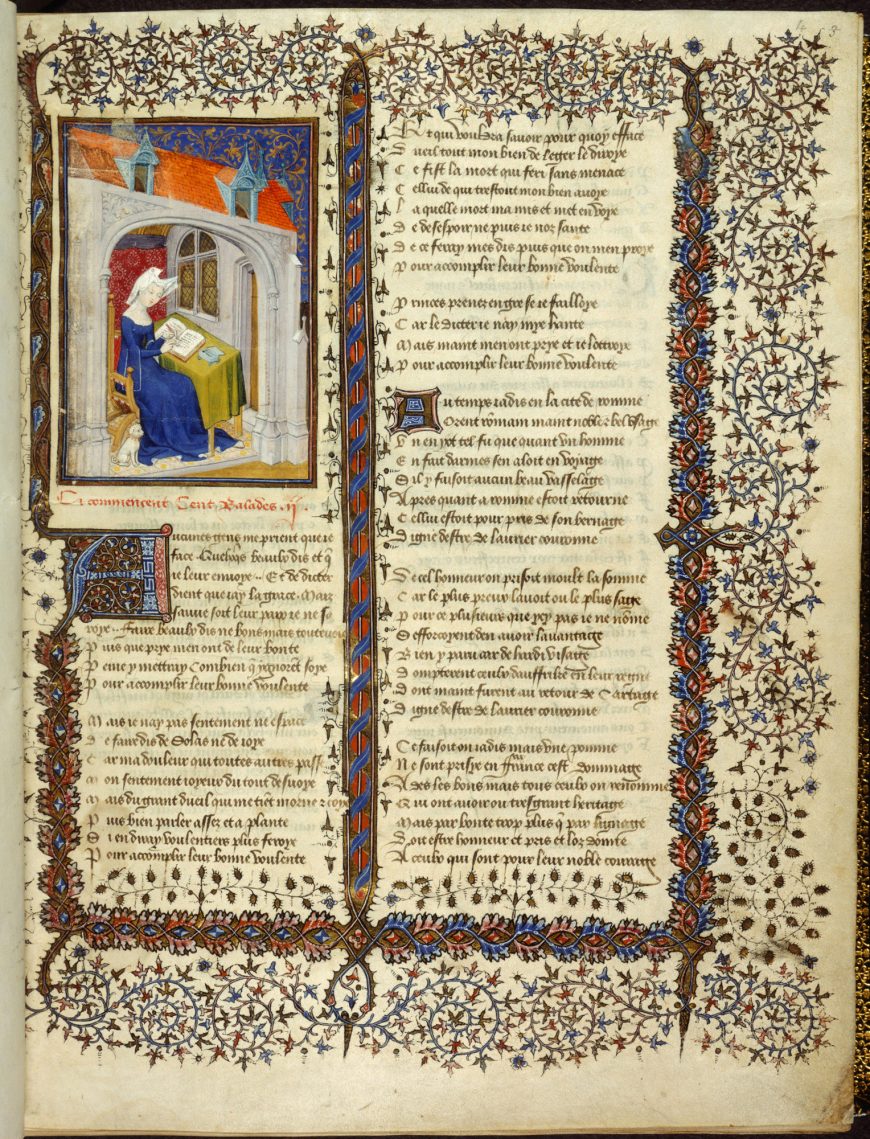
Christine in Her Study
In one of the most recognizable portraits of Christine de Pizan, she wears a simple but brilliant blue dress, called a cotehardie, with her hair tucked back and covered with a double horned headdress covered by a transparent white veil. This distinctive headdress looks like one called the Attor de Gibet, or horned hennin (or possibly even the butterfly hennin), which originated in Burgundy and France.
Aristocratic or royal women typically wear them. The horns would be made to stand with wire to hold up cloth, and then often the veil draped over them. Christine communicates her noble status with her headdress, and dress. The saturated, luminous blue of the dress is painted with ultramarine, which comes from the semi-precious stone lapis lazuli which is mined in Afghanistan and was extraordinarily costly at this time. Throughout The Queen’s Manuscript, she wears the same blue cotehardie, with the expensive material undoubtedly conveying her status and a sense of luxury.
In the portrait, Christine sits within a study, framed by a rounded arch, which belongs to a larger architectural setting. She holds a pen as she writes in a book. Accompanying her in the study is a small white dog, loyally seated next to her chair. While we might wonder if Christine’s portrait is a fiction, Pizan actually did have a study with a desk, writing tools, and various books. The portrait imagines what it would have looked like. It is within her study that Pizan wrote her poems and prose texts, as well as studied the literary works of other authors–both her contemporaries and those who preceded her.
Christine gave The Queen’s Manuscript to Isabeau de Bavière, Queen of France and wife of Charles VI. The portrait of Christine writing appears early on in the manuscript, accompanying the One Hundred Ballades of a Lover and His Lady (Cent Ballades d’amant et de dame, virelyas, rondeaux), which Christine wrote around 1402.
Christine’s portrait is remarkable for a number of reasons, including that it shows a known late medieval/early renaissance woman writing in a study. She was not, however, the first woman to be depicted in the art of writing or engaged in intellectual activities. Several centuries earlier, we find images of Hildegard of Bingen recording some of her mystical experiences (as in the Liber Scivias).
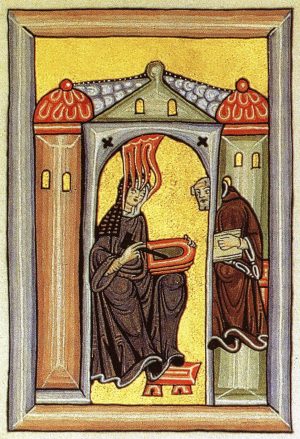
We know of other medieval women, such as Diemund of the Cloister of Wessobrun in Bavaria or the painter Ende, who wrote or illuminated manuscripts. Still, it was uncommon to show women in the act of writing since this was not understood to be their domain. Christine’s portrait is also noteworthy because it is not the sole portrait portraying her engaged in intellectual pursuits. There are a number of others within The Queen’s Manuscript, as well as in many other manuscripts as well.
Christine as author and intellectual
The portrait of Christine seated at a desk in her study while writing is a familiar type that dates back to antiquity. There are numerous examples of the solitary thinker and scholar, writing and engaged in deep thinking and other intellectual pursuits. Christine’s portraits likely called to mind portraits of the four evangelists who are often shown seated and in the act of writing, such as portrait of St. Luke from the Lindisfarne Gospels from c. 700 or St. Matthew in the Ebbo Gospels from the ninth century. Medieval scribes, such as Eadwine, were frequently displayed similarly, seated and writing in their studies or scriptoria. Christine’s portrait draws on this long heritage of images of educated authors.
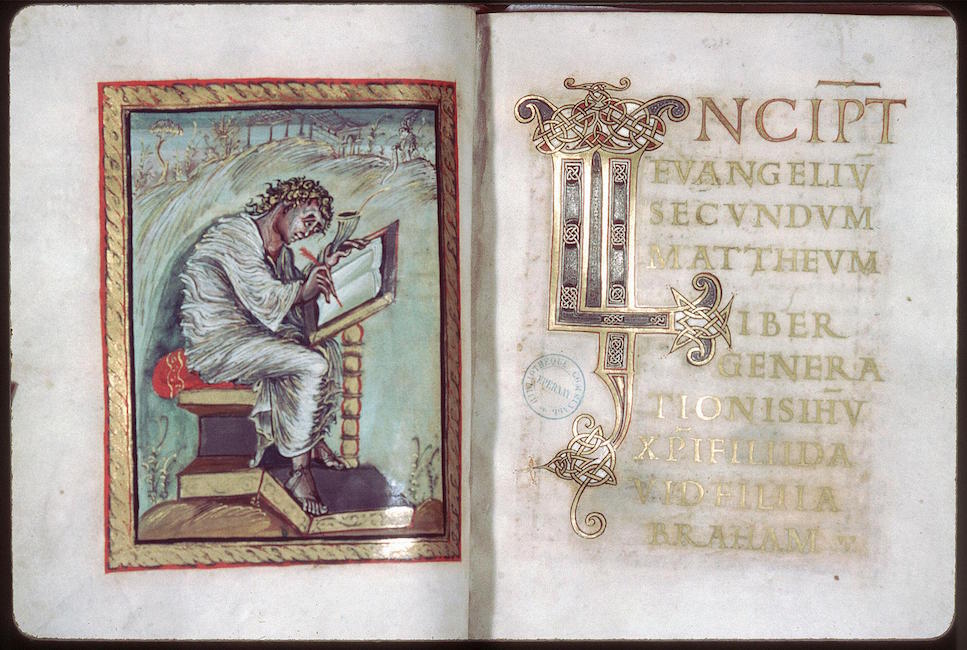
Christine’s life
Christine was born in Venice, Italy, but at a young age her father (Tommaso di Benvenuto da Pizzano, or Thomas de Pizan) joined the French court in Paris as an astrologer and secretary to the king, Charles V. She had a humanist education, learning history, classical languages, and literature (among other subjects). She was married at fifteen to the royal secretary and notary, Etienne du Castel, with whom she had three children. Historical records, and even Christine herself, indicate that they got along well, which was certainly not always the case in arranged marriages.
Etienne supported Christine’s continuing education and literary endeavors. He died suddenly in 1390, when Christine was only 25, and her father died shortly thereafter, leaving Christine to support her children and mother. She turned to writing full time to make a living, and she was the first person in France to earn a living as a professional author. Later in her life, she entered a convent where she remained until her death in 1431. One of her final works was a poem celebrating Joan of Arc, likely written shortly before Joan was burned at the stake for her supposed heresy during the Hundred Years’ War (1337–1453). The War pitted England and France against one another, and Christine had witnessed the chaos and devastation the ongoing conflict wrought on the people of France.
Figure \(\PageIndex{119}\): Christine de Pizan talking with her son (detail), for The Queen’s Manuscript, c. 1410–1414, f. 261v (Harley MS 4431, British Library)
Throughout her literary career, Christine wrote on a number of topics, ranging from religion and political theory to courtly love poetry and military tactics. She also wrote in different genres, including poetry and prose texts. Many of her writings refer or allude to the upheavals that she experienced in her lifetime, including lingering deaths from the plague, an unstable crown, civil wars, and foreign occupation.
She produced many manuscripts in her own scriptorium, of which about 50 survive. There are many others (about 150) that include some of her work. Of those that she completed, we know that she determined how they would be arranged, what would be included or excluded, including the types of images. She had a direct hand in their entire composition, which is all the more remarkable as a female professional author at a time when women were not expected or encouraged to work—particularly not noble ladies—and most were not well educated.
Christine’s manuscripts, and the images she determined would be included within them, help us to learn what types of messages and ideas she hoped to convey to her readers. While she herself did not draw and paint the illustrations, it seems that she did employ female artists to produce them. She even mentions this fact in her Book of the City of Ladies (c. 1405), naming the artist Anastaise whom she said was “so good at painting decorative borders and background landscapes for miniatures that there is no craftsman who can match her in the whole of Paris, even though that’s where the finest in the world can be found…. [S]he is so well regarded that she is entrusted with finishing off even the most expensive and priceless of books.” [1]
Christine presents her manuscript to the Queen of France
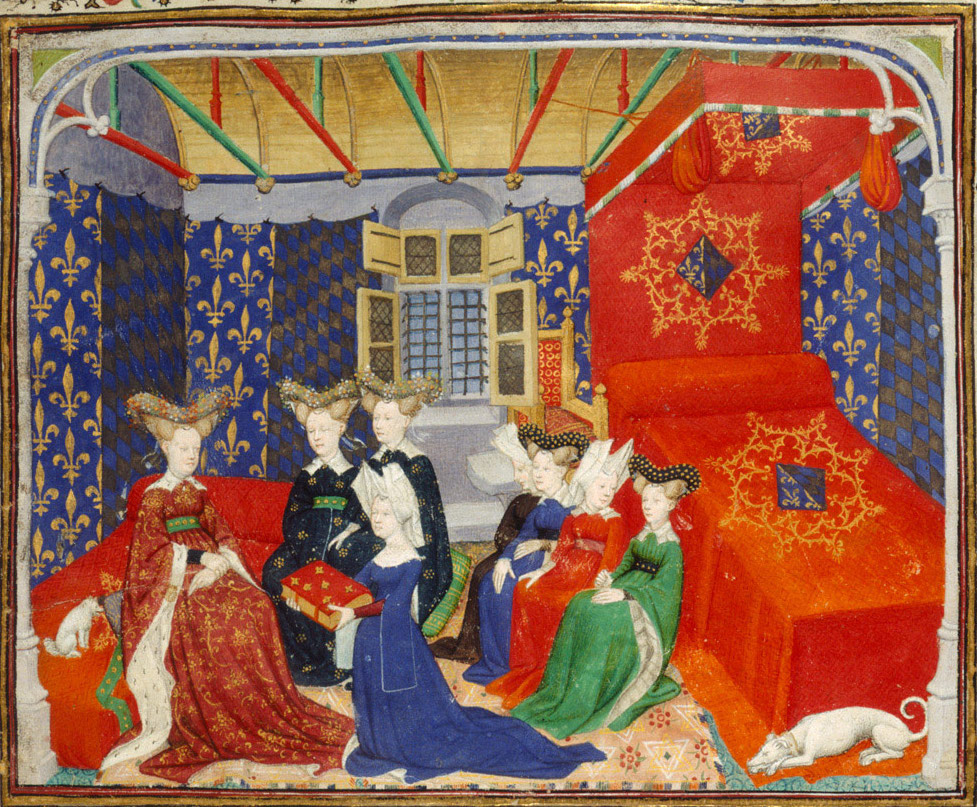
Christine’s other portraits within The Queen’s Manuscript are easily identifiable because the artist (under the direction of Christine herself) consistently portrays her wearing the brilliant blue dress and horned white headdress. In the first image of the manuscript we see her kneeling and presenting a book before the Queen, who sits on a lounger within her royal chamber with a small white dog. Other ladies in waiting sit in the room. Another white dog rests at the foot of the bed, set to the right in the room. Blue textiles decorated with the royal golden fleur-de-lis adorn the walls.
The Queen and many of her ladies in waiting wear more elaborate clothes than Christine and have more intricate headdresses. The book that Christine offers is supposed to represent the very manuscript from which the image comes. This portrait was based on a type called presentation images, which typically showed a male author presenting a book to a king. Christine, and the artist she employed, modeled the image on established artistic conventions so that she could establish her position as legitimate author.
Christine in the act of disputation
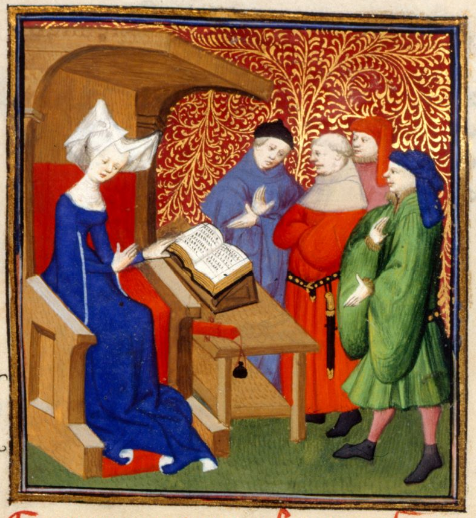
In another portrait Christine appears at the beginning her Moral Proverbs (Proverbes moraux). She sits on what looks like a throne, once again dressed in a brilliant blue dress with a white headdress. The chair is similar to a cathedra, or a bishop’s chair, which was associated more generally with ecclesiastics but was also commonly associated with authors or men of intellectual regard in the medieval era. She has a book, open on a stand, that rests on a desk.
To the side of the desk are four men, three of whom look in her direction. The five of them seem to be engaged in conversation. Some have suggested that Christine and these four men are engaged in a debate, known as a disputation (disputa) in the Middle Ages. Disputations were common at universities, where students and professors would engage in intellectual debates to prove their wisdom. Women were not permitted at universities, so Christine’s seat in a position of authority and engaged in debate with four men communicates her intellectual abilities and elevates her to a position of authority.
This portrait, along with all of Christine’s portraits in The Queen’s Manuscript, highlight her important status. Still today, works like Judy Chicago’s The Dinner Party recognize Christine’s significant contribution.
Acknowledgments
Thanks are due to Lydia Parker.
Notes
[1] Christine de Pizan, The Book of the City of Ladies, trans. Rosalind Brown-Grant (London: Penguin, 1999), part 1, p. 41.
Additional Resources:
View the entire Queen’s Manuscript at the British Library
The Making of The Queen’s Manuscript project
Susan Groag Bell, “Christine de Pizan in Her Study,” Cahiers de recherches médiévales et humanistes [En ligne], Études christiniennes, mis en ligne le 10 juin 2008, consulté le 18 juillet 2019
Susan Groag Bell, The Lost Tapestries of the City of Ladies: Christine de Pizan’s Renaissance Legacy (Berkeley and Los Angeles: University of California Press, 2004)
Charlotte E. Cooper, “Ambiguous Author Portraits in Harley MS 4431,” In Performing Medieval Text, ed. Ardis Butterfield, Henry Hope, and Pauline Souleau (Cambridge: Legenda, 2017), pp. 89–107
Sandra Hindman, Christine de Pizan’s ‘Epitre Othea’: Painting and Politics at the Court of Charles VI (Wetteren: Pontifical Institute of Medieval Studies, 1986)
Nadia Margolis, An Introduction to Christine de Pizan, New Perspectives on Medieval Literature: Authors and Traditions (Gainesville: University Press of Florida, 2012)
Christine de Pizan, The Book of the City of Ladies (London: Penguin Classics, 2000)
Christine Sciacca, Illuminating Women in the Medieval World (Los Angeles: J. Paul Getty Museum, 2017)
Christine de Pizan and a City of Ladies
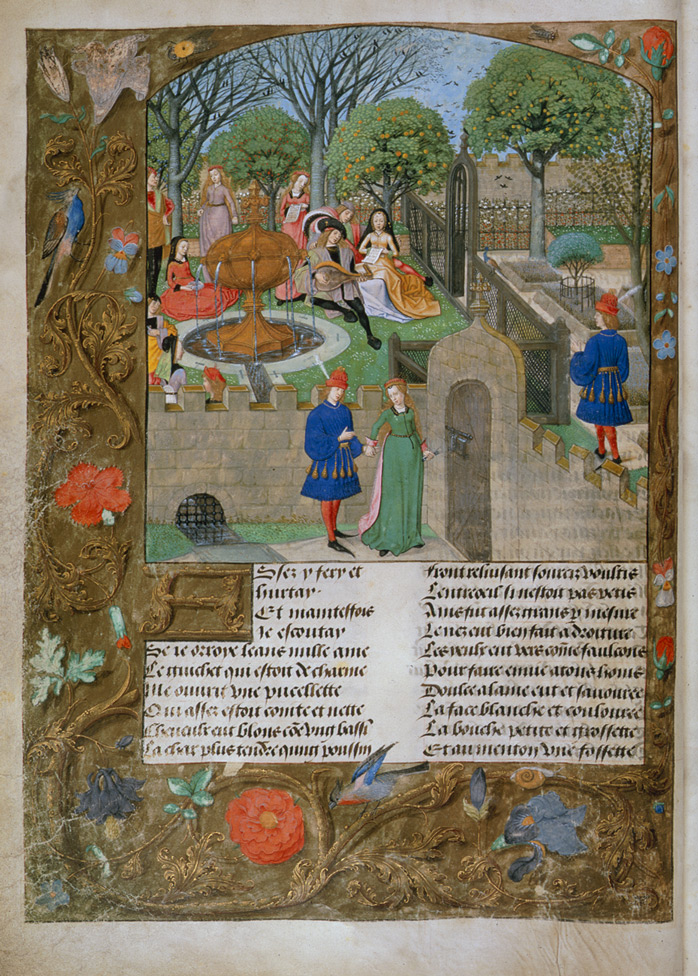
The woman question
In the late Middle Ages, one of the most popular books was the Romance of the Rose (Roman de la Rose), begun in 1237 by Guillaume de Lorris and expanded by Jean de Meun some decades later. The lengthy medieval poem describes a dream vision about romantic love or the art of love. At the center of the poem is a young man who, while asleep, encounters a garden of love. While there, he sees a rose with which he falls in love. During his dream journey he meets various allegorical figures or personifications. Eventually the young man will acquire the rose, deflowering it. The book was a bestseller, with many manuscripts illustrating the story, but it was also controversial for its descriptions of courtly love, women, and marriage.
In the early fifteenth century, a major debate about the Romance of the Rose ensued, as did the nature and role of women. It was called the querelle de femmes, or “the woman question.” It pitted important thinkers against one another.
One of the most active participants in this debate was Christine de Pizan, the first professional author and a woman to boot, and she, along with Jean Gerson (chancellor of the University of Paris) and others, challenged the misogynistic text’s ideas as well as broader societal notions of womanhood. She disagreed with the negative, misogynistic attitudes toward women that she felt the book promoted and penned numerous letters to defend women. Her participation in the quarrel is a reason that Christine is often called one of the first feminists. In her poems and prose texts, she would also argue for the rights of women and found opportunities to celebrate women’s achievements.
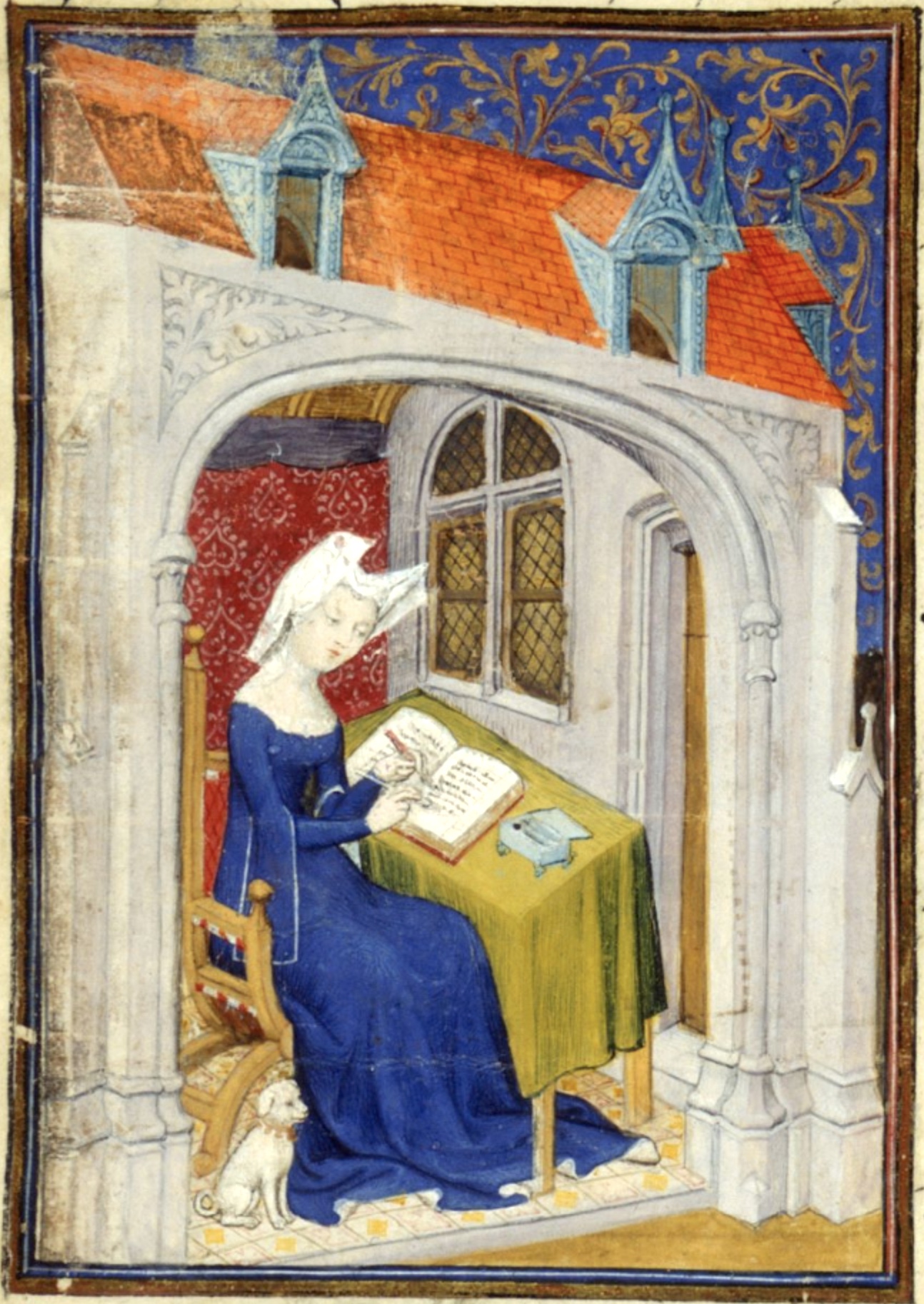
The Book of the City of Ladies
Pizan’s most famous text, called The Book of the City of Ladies, written around 1404–05, is probably the best expression of her views on women. The text begins with Christine describing how she was sitting in her study, reading. She likely had in mind a space similar to the one we see in her portrait in the Queen’s Manuscript, in which the artist—possibly even a female manuscript painter—depicts Christine seated at a desk in her study, with writing implements and accompanied by a dog.
In The Book of the City of Ladies, she reads a book about women that she finds unpleasant and shocking. She feels sad and depleted after reading it, especially because the book complained about women, and especially marriage. At this moment of sadness, she is visited by three ladies, Rectitude, Justice, and Reason, who represent different virtues. They tell Christine to build a city of ladies, and to fill it with women worthy of recognition for their intellect, compassion, and strength.
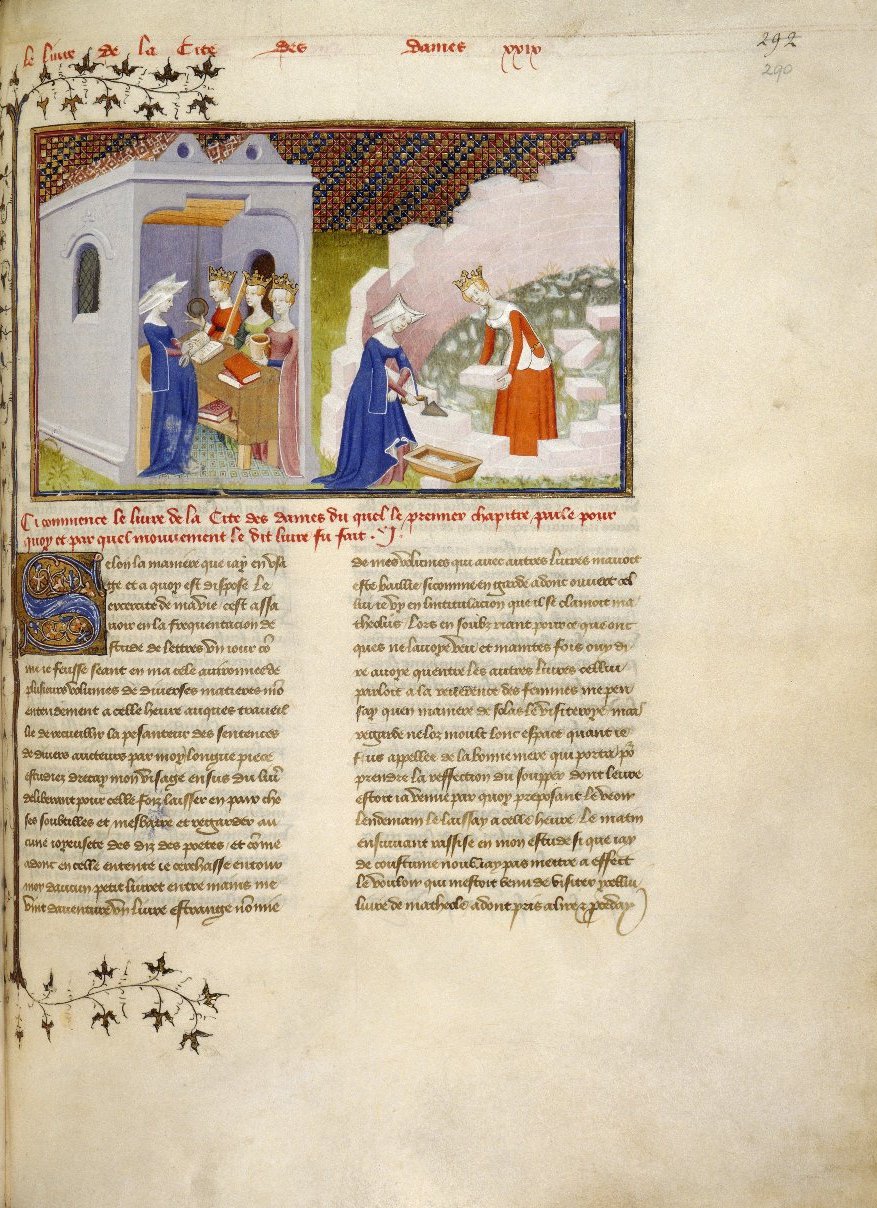
The book proceeds to catalogue important women (historical, biblical, and mythological), and includes individuals such as Judith, the Amazons, Blanche of Castile, saint Cecilia, and Sappho. Her extensive catalogue of women is indebted to Boccaccio’s On Famous Women, from 1361–62, which included short biographies of famous women (mythological and historical). Still, Christine’s text has many more women in it, and the text passionately defends them, especially their education.
The education of women
At one point in The Book of the City of Ladies, Christine discusses women’s education with Lady Rectitude, extending her arguments of the “querelle” and providing another opportunity to defend women and their right to be educated.
Christine, said, ‘My lady, I can clearly see that much good has been brought into the world by women. Even if some wicked women have done evil things, it still seems to me that this is far outweighed by all the good that other women have done and continue to do. This is particularly true of those who are wise and well educated in either the arts or sciences, whom we mentioned before. That’s why I’m all the more amazed at the opinion of some men who state that they are completely opposed to their daughters, wives or other female relatives engaging in study, for fear that their morals will be corrupted.’
Rectitude replied, ‘This should prove to you that not all men’s arguments are based on reason, and that these men in particular are wrong. There are absolutely no grounds for assuming that knowledge of moral disciplines, which actually inculcate virtue, would have a morally corrupting effect. Indeed, there’s no doubt whatsoever that such forms of knowledge correct one’s vices and improve one’s morals.”
Christine de Pizan, The Book of the City of Ladies, trans. Rosalind Brown-Grant (London: Penguin, 1999), part 2:36.

Christine’s defense of women’s education underscored her own education and her work as a writer. Other painted portraits of Christine, including those within the Queen’s Manuscript, portray her engaged in writing or disputation as visual arguments to support women and their education.
Building a city of ladies

In another image from The Queen’s Manuscript, the artist depicts Christine in her study as she is visited by the three allegorical ladies and as she begins to construct the city. Christine once again dons her blue dress and white horned headdress, and she rises from her chair to speak with her three visitors.
The three crowned ladies all hold attributes that relate to who they personify, as Christine describes in the text itself. Reason holds a mirror (symbolizing wisdom), Rectitude a ruler (symbolizing judgment), and Justice a golden container (symbolizing justice and salvation). Reason holds the mirror up to Christine so that she can see herself for who she is and not in the way that men have negatively addressed women. Rectitude’s ruler is to help Christine measure the materials needed to build the city and to separate good from bad, right from wrong. God gave Justice the golden container, and it is a reminder to live morally and justly in order to achieve salvation because Justice will dole out “the rightful portion” according to how each person lives.
In the right portion of the image, Christine is shown actively engaged in the building of the city, holding a trowel as she plasters stones one by one to construct the outer wall of the city. Reason assists her, carrying a brick to Christine. In a single image, Christine is an author, an intellectual, an individual graced with divine presence, and an architect at work.
Acknowledgments
Thanks are due to Lydia Parker.
Additional resources
View the entire Queen’s Manuscript at the British Library
The Making of the Queen’s Manuscript project
Read about the Roman de la Rose on the British Library website
View a copy of the Roman de la Rose in its entirety on the World Digital Library
Susan Groag Bell, “Christine de Pizan in Her Study,” Cahiers de recherches médiévales et humanistes [En ligne], Études christiniennes, mis en ligne le 10 juin 2008, consulté le 18 juillet 2019.
Susan Groag Bell, The Lost Tapestries of the City of Ladies: Christine de Pizan’s Renaissance Legacy (Berkeley and Los Angeles: University of California Press, 2004).
Charlotte E. Cooper, “Ambiguous Author Portraits in Harley MS 4431,” in Performing Medieval Text, ed. Ardis Butterfield, Henry Hope, and Pauline Souleau, 89–107 (Cambridge: Legenda, 2017).
Sandra Hindman, Christine de Pizan’s ‘Epitre Othea’: Painting and Politics at the Court of Charles VI (Wetteren: Pontifical Institute of Medieval Studies, 1986).
Nadia Margolis, An Introduction to Christine de Pizan, New Perspectives on Medieval Literature: Authors and Traditions (Gainesville: University Press of Florida, 2012).
Guillaume de Lorris and Jean de Meun, The Romance of the Rose, trans. Frances Horgan (Oxford: Oxford University Press, 2009).
Christine de Pizan, The Book of the City of Ladies (London: Penguin Classics, 2000).
Christine Sciacca, Illuminating Women in the Medieval World (Los Angeles: J. Paul Getty Museum, 2017),
Enguerrand Quarton(?), Pietà of Villeneuve-lès-Avignon
by DR. BETH HARRIS and DR. STEVEN ZUCKER
Video \(\PageIndex{27}\): Enguerrand Quarton(?), Pietà of Villeneuve-lès-Avignon, c. 1455, oil on wood, 163 x 219 cm (Musée du Louvre)
Smarthistory images for teaching and learning:
No photos
Figure \(\PageIndex{127}\): More Smarthistory images…
The Unicorn in Captivity
by DR. STEVEN ZUCKER and DR. BETH HARRIS
Video \(\PageIndex{28}\): The Unicorn in Captivity (one of seven woven hangings popularly known as the Unicorn Tapestries or the Hunt of the Unicorn), 1495-1505, wool, silk, silver, and gilt (The Cloisters, The Metropolitan Museum of Art)
Smarthistory images for teaching and learning:
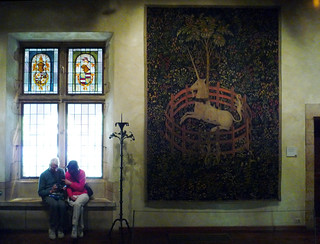
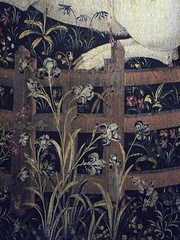
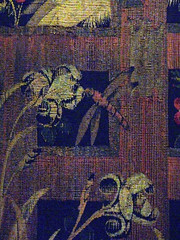
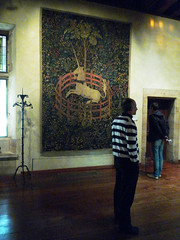
Tyrol
Michael Pacher, St. Wolfgang Altarpiece
by DR. STEVEN ZUCKER and DR. BETH HARRIS
Smarthistory images for teaching and learning:
